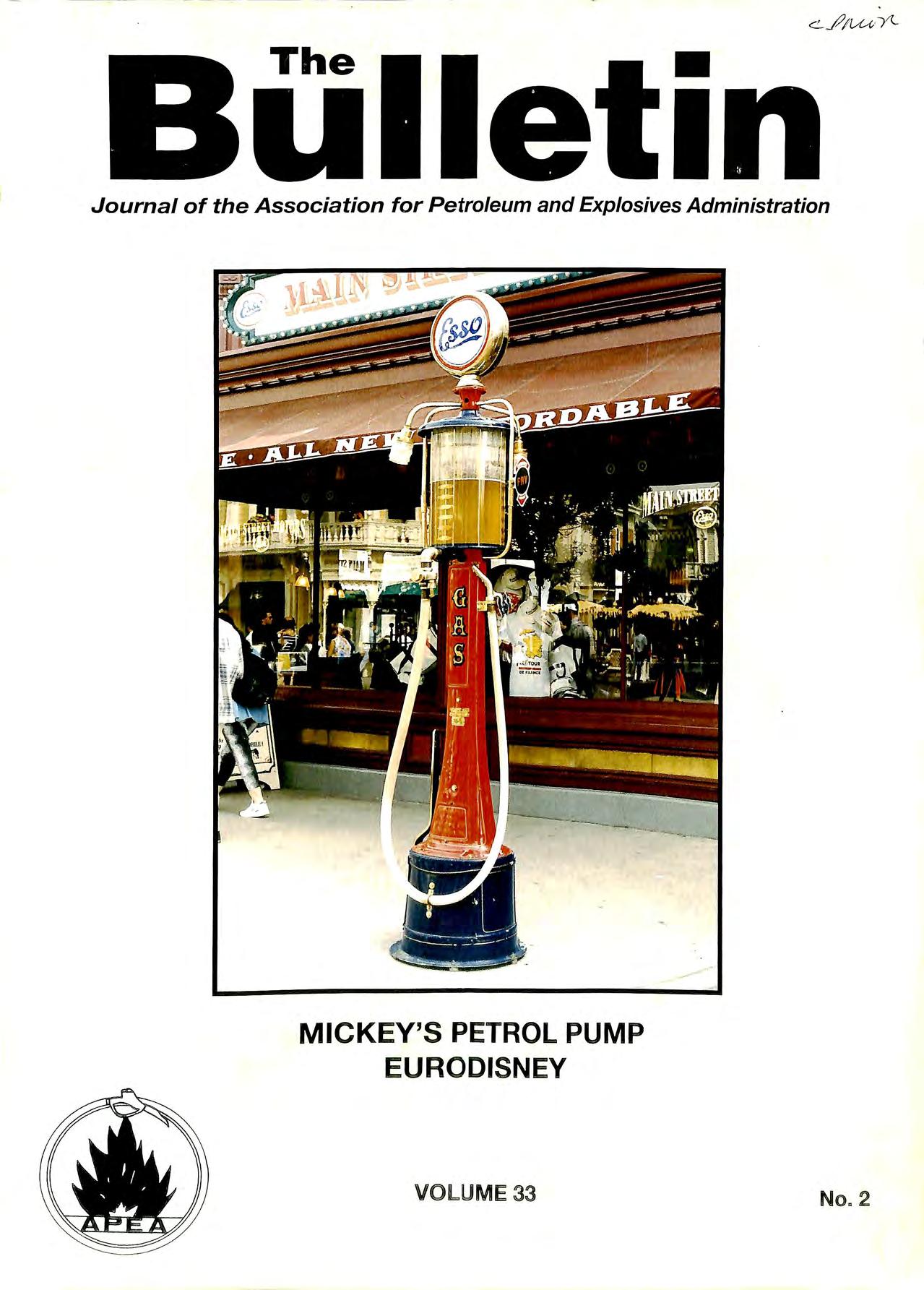
The •
MICKEY'S PETROL PUMP EURODISNEY VOLUME33 No. 2
Journal of the Association for Petroleum and Explosives Administration
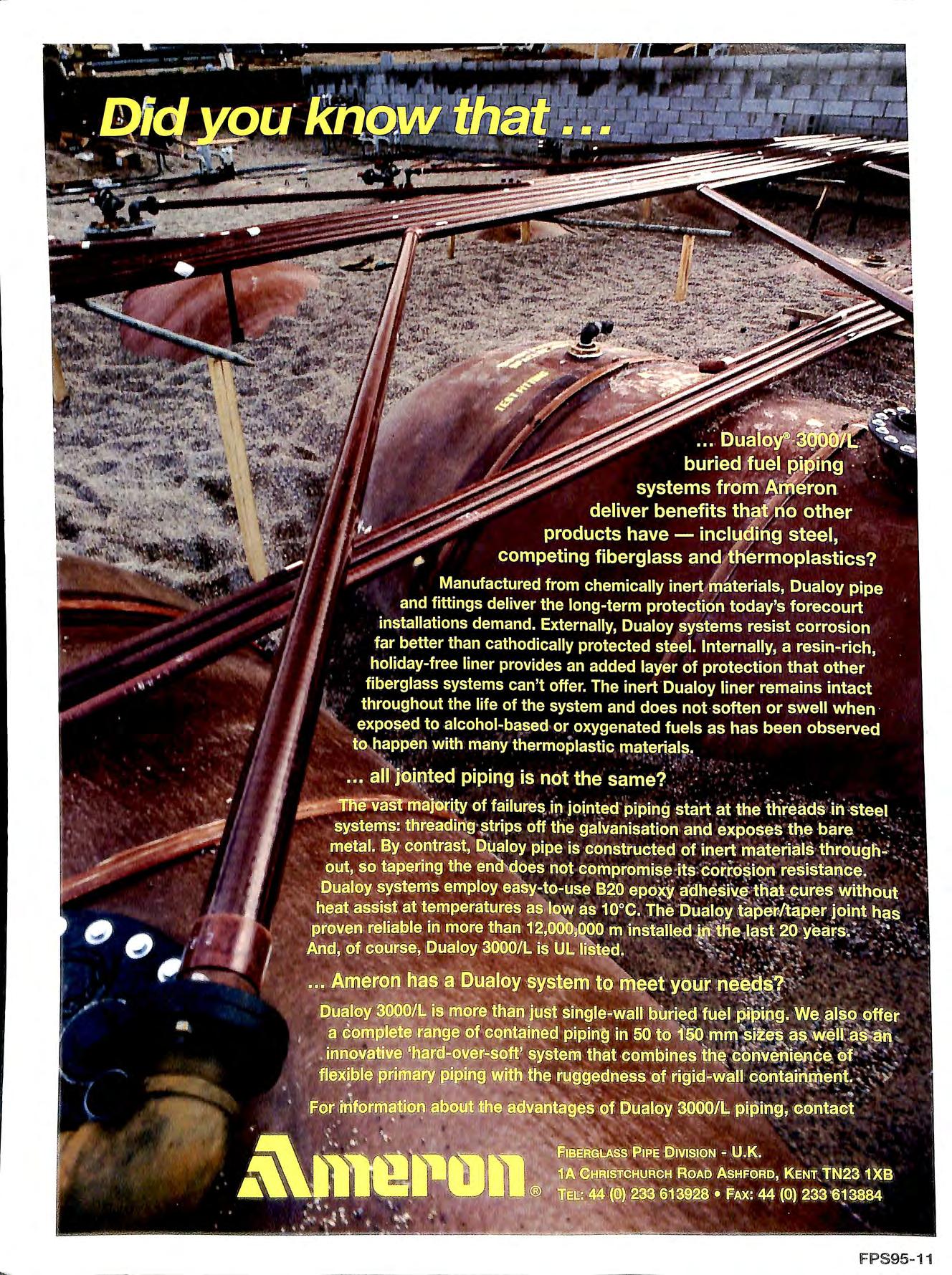
IFPS95-11
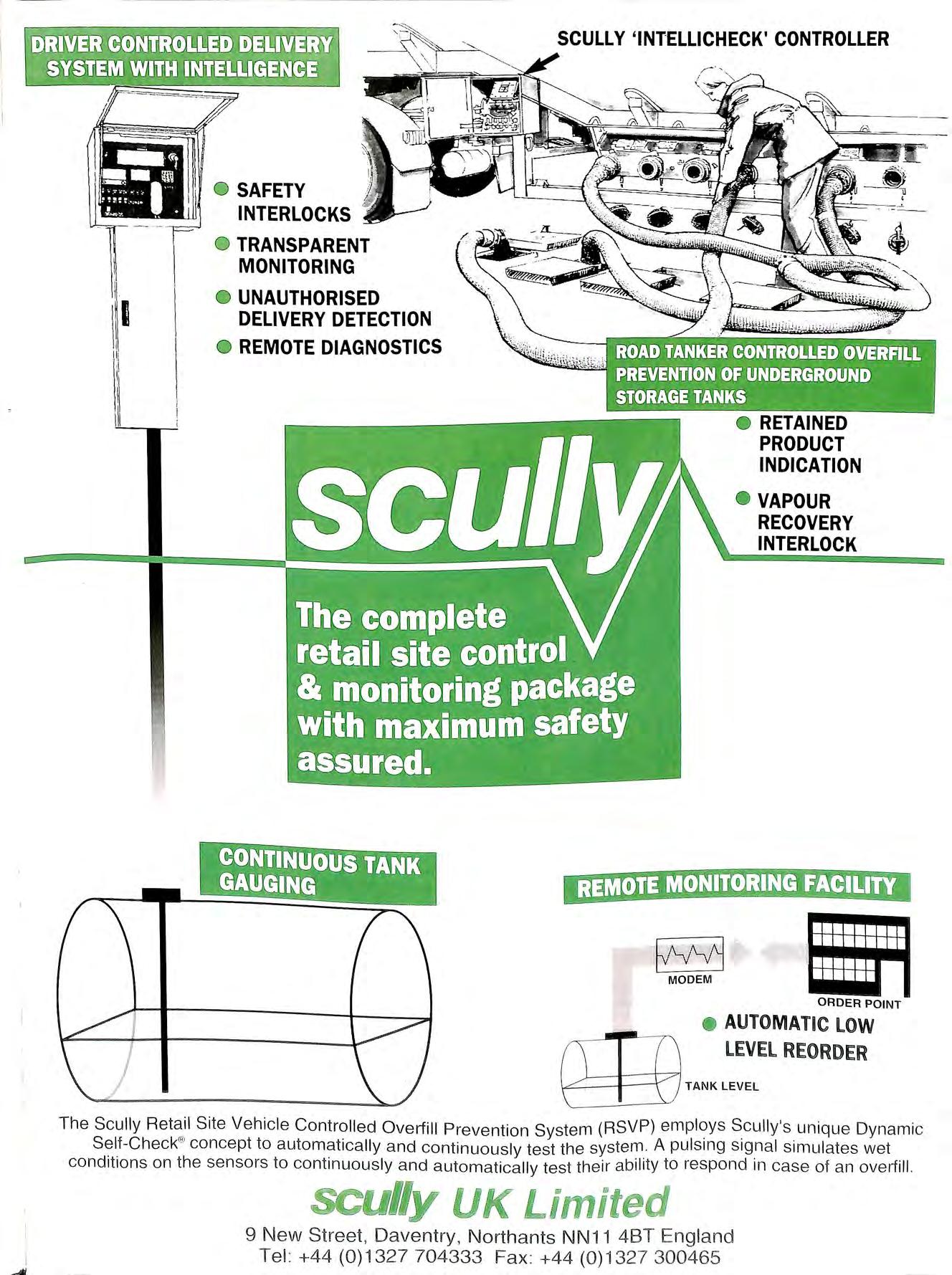
I __.,. I 1! 1 l\i I 111 I ,) O SAFETY INTERLOCKS 0 TRANSPARENT MONITORING 0 UNAUTHORISED DELIVERY DETECTION 0 REMOTE DIAGNOSTICS SCULLY 'INTELLICHECK' CONTROLLER MODEM RETAINED PRODUCT INDICATION VAPOUR RECOVERY INTERLOCK I I ORDER POINT e AUTOMATIC LOW LEVEL REORDER TANK LEVEL The Scully Retail Site Vehicle Controlled Overfill Prevention System (RSVP) employs S_cully's unique Dynamic Sel_f-Check®concept to automatically and continuously test the A pulsing signal simulates wet cond1t1ons on the sensors to continuously and automatically test their ab1l 1ty to respond 111 case of an overfill. -Ull UK 9 New St reet , Daventry, Northants NN11 4B T E ngland Tel : +44 (0)1327 704333 Fax : +44 (0)1 327 30046 5
has a network of distrib u tors throughout Europ e Each has been selected for its high standard ofexpertise and know ledge ofthe industry.
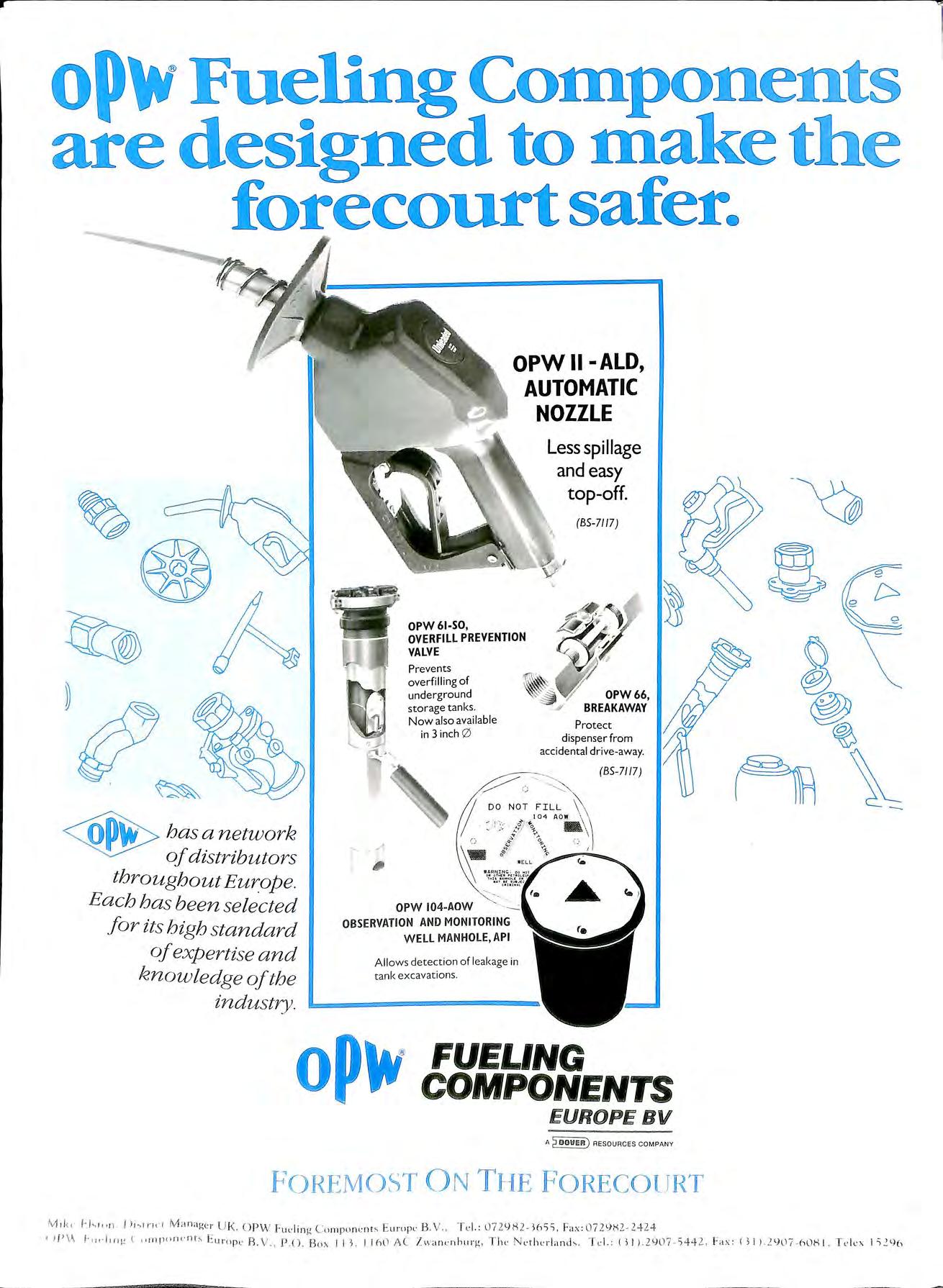
jv
OPW 11-ALD, AUTOMATIC
OPW61-SO, OVERFILL PREVENTION VALVE Less spillage and easy top-off. (BS-7117) Pre vents overfilling of underground storage tanks. Now also avail abl e OPW66 ./ BREAKAWAY' in 3 inch 0 A llo ws dete ct io n of le ak age in ta nk ex cava ti o ns Prote ct dispenser from accidental drive-away oP\V FUEi.iNG COMPONENTS EUROPEBV A 2O OH' GR) RESOURCES COMPANY FOHEMOST O N TifE FORECOURT M ik , lcl" " fl I ) j ,f ne t Manager U K OPW Fuc lin i:; C um pu n cn t' Euru pc· B V., Te l.: 072 9R Z- ) fiS S, Fax : 0 729H2 24 2 4 1 1i ' \.\ I·11 .- l ( • "nl"' 11 '' 111 Euro pe B. V ., P O Bcix I J ). I I fill AC Zwancnhu r g , Th e: Net h e r lan d" T c l. : ( l 1) 2907-'i44 2, Fa." ( l I ) 2 lJl17 fiOt-1 I Tc k x I 'i 2 96
NOZZLE
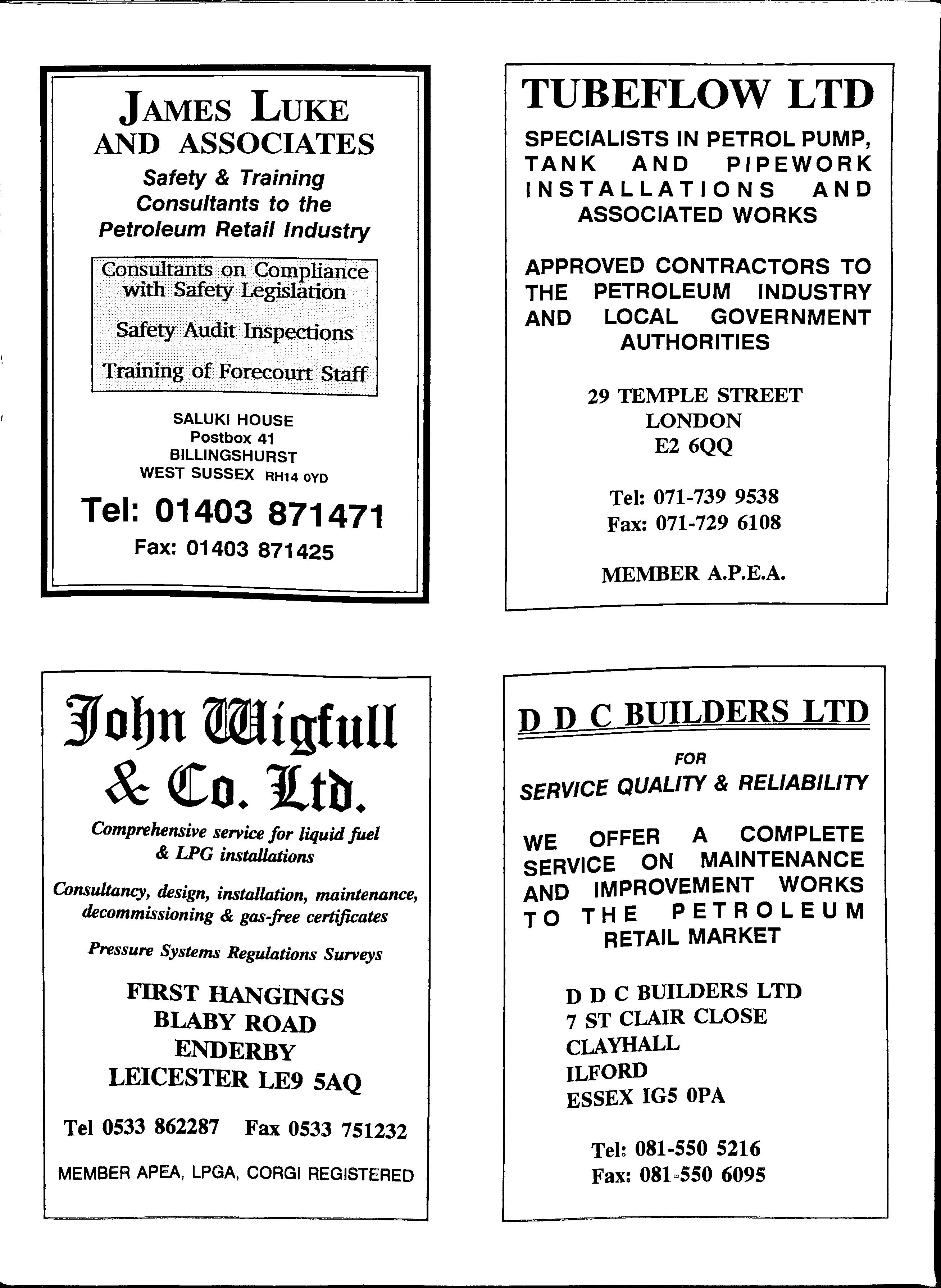
JAMES LUKE AND ASSOCIATES Safety & Training Consultants to the Petroleum Retail Industry SALUKI HOUSE Postbox 41 BILLINGSHURST WEST SUSSEX RH14 ova Tel: 01403 871471 Fax: 01403 871425 1 obn ull & 1Ltb. Comprehensive service for liquid fuel & LPG installations Consultancy, design, installation, maintenance, decommissioning & gas-free certificates Pressure Systems &gulations Surveys FIRST HANGINGS BLABYROAD ENDERBY LEICESTER LE9 SAQ Tel 0533 862287 Fax 0533 751232 MEMBER APEA, LPGA, CORGI REGISTERED TUBEFLOW LTD SPECIALISTS IN PETROL PUMP, TANK AND PIPEWORK INSTALLATIONS AND ASSOCIATED WORKS APPROVED CONTRACTORS TO THE PETROLEUM INDUSTRY AND LOCAL GOVERNMENT AUTHORITIES 29 TEMPLE STREET LONDON E2 6QQ Tel: 071-739 9538 Fax: 071-729 6108 MEMBER A.P.E.A. D D C BUILDERS LTD FOR SERVICE QUALITY & RELIABILITY WE OFFER A COMPLETE SERVICE ON MAINTENANCE AND IMPROVEMENT WORKS TO THE PETROLEUM RETAIL MARKET D D C BUILDERS LTD 7 ST CLAIR CLOSE cLAYHALL ILFORD ESSEX IG5 OPA Tel: 081-550 5216 Fax: 081.,550 6095
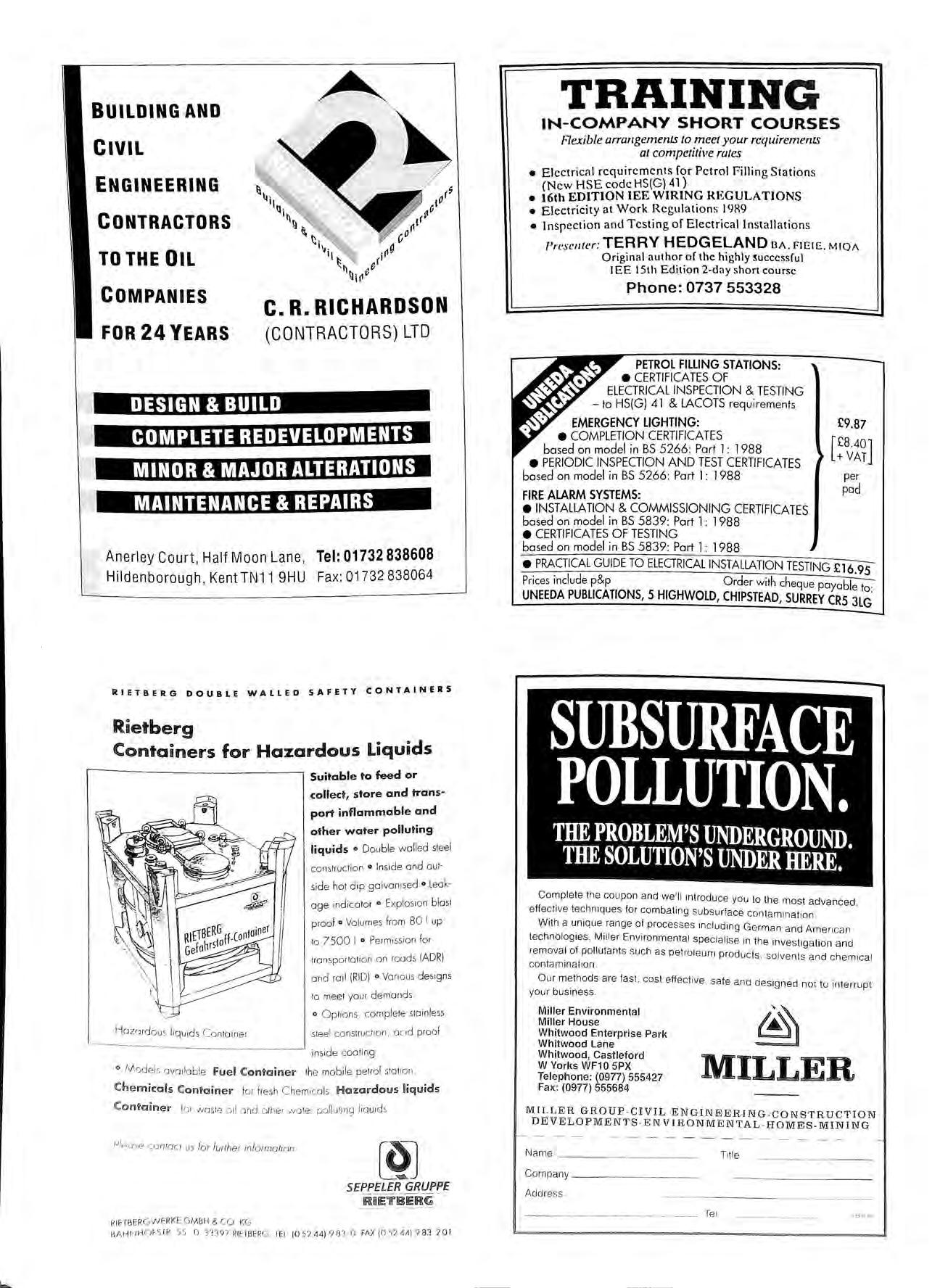
BUILDING AND CIVIL ENGINEERING CONTRACTORS TO THE OIL COMPANIES FOR 24 YEARS C.R. RICHARDSON (CONTRACTORS) LTD DESIGN & BUILD COMPLETE REDEVELOPMENTS MAINTENANCE & REPAIRS Anerley Court, Half Moon Lane , Tel: 01732 838608 Hildenborough , Kent TN11 9HU Fax: 01732 838064 RIETBERG DOUBLE WALLED SAFETY CONTAINERS Ri etberg Containers for Hazardous Liquids r-- --, Suitable to feed or Haza rdous liquids Conta iner collect, store and transport infla mmable and other water polluting liqu i d s • Double walled steel conslruclion • Inside and out side hol d ip gaivon ised • leak age indicator • Explosion blast proof o Volumes from 80 I up lo 7500 I 0 Perm ission for fran sportali on on roods (ADR) an d rail (R ID) 0 Var ious desi gns to meet your demands o O ptions: complete stain less steel co nstruction , acid proof inside coa ti ng 0 Models available Fuel Con taine r th e mobile petrol slotion Ch emical s Conta iner for fresh C hemica ls !Hazardou s liqu ids Conta in er for waste oil ond o:her wa ter polluting liq uids Pleose co n1oct us for f urth er info r ma tr on RIETBE RG WERKE G M BH l CO KG SEPPELER GRUPPE IRHIElf_!llERtrO _ BAHNHO FSrR 55 D 333 9 7 RIETBERG fEl (0 52 44} 9 8 3 0 FAX (0 5 2 44} 9 83 2 01 TRAINING IN-COMPANY SHORT COURSES Flexible arrangements to meet your requirements at competitive rates • Electrical requirements for Petrol l'illing Station s (New HSE code HS(G) 41) • I6th EDITION IEE WIRING REGULATIONS • Electricity at Work Regulations 1989 • Inspection and Testing of Electrical Installation s f'resc11/a _· TERRY HEDGELAND BA , FI E IE MIOA Origin al author of the highly !ucccssful IEE ISth Edition 2-day short course Phone: 0737 553328 PETROL FILLING STATIONS: e CERTIFICATES OF ELECTRICAL INSPECTION & TESTING to HS(G) 41 & LACOTS requ i rem ents EMERGENCY LIGHTING: e COMPLETION CERTIFICA TES based on model in BS 5266: Part l : 198 8 e PERIODIC INSPECTION AND TEST CERT/FICATES ba sed on model in BS 5266 : Part l : 1988 FIRE ALARM SYSTEMS: e INSTALLATION & COMMISSIONING CERTIFICATES based on model in BS 5839: Part l: 1988 e CERTIFICATES OF TESTING based on model in BS 5839: Part l: 1988 £9.87 [ £8 40 ]+VAT per pod e PRACTICAL GUIDE TO ELECTRICAL INSTALLATION TESTING £16.i}S Prices include p&p Order w ith cheque paya ble!;; UNEEDA PUBLICATIONS, 5 HIGHWOLD, CHIPSTEAD, SURREY CR5 JLG Compl ete the coupon and we 'll int ro duce you lo th e mos t advanced , eff ective techniques fo r comba ti ng subsu rface co nt aminat io n With a uniqu e range of processes in clud ing German and Ameri ca n te chn olog ies , Mi lle r Environmen tal specia lise rn the investi ga ti on and re mova l of pollutants such as petro leu m pro ducls solven ls an d chemic al contamrnatron. Our me thods are fast cosl effective , safe and desig ned not to interrupt your business Miller En vironm ental Miller House Whitwood Enterpris e Park Whitwood Lane Whitwood , Ca st lefo rd W Yorks WF10 5P X Telephon e: (0977) 555427 Fax : (0977 )555684 MILLER MI LLER GRO UP C I VIL ENG I NEE RI N G -CONSTRUCTION D EV E LO PMENTS EN V l RON M EN T A L HOM E S MIN I N G Title _ Company _____ Add ress Tel
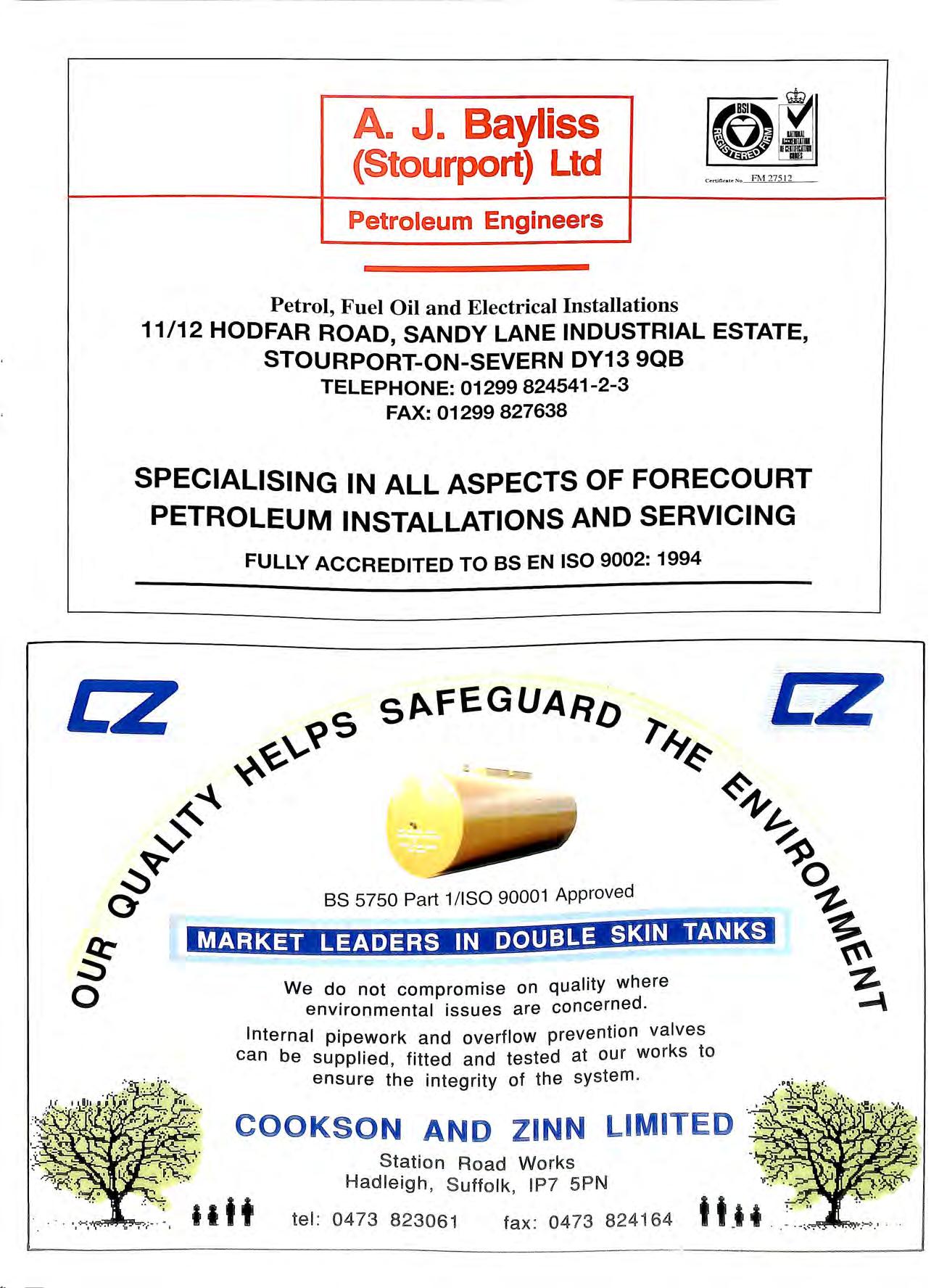
Bayliss urport) Ltd etroleum Engineers Petrol, Fuel Oil and Electrical Installations . • 11/12 HODFAR ROAD, SANDY LANE INDUSTRIAL ESTATE, STOURPORT-ON-SEVERN DY13 9QB TELEPHONE: 01299 824541-2-3 FAX: 01299 827638 SPECIALISING IN ALL ASPECTS OF FORECOURT PETROLEUM INSTALLATIONS AND SERVICING FULLY ACCREDITED TO BS EN ISO 9002: 1994 LZ S 51\FEGUARD · £7 f...4. v 0 BS 5750 Part 1/ISO 90001 Approved !§ 0 We do not compromise on quality where environmental issues are concerned. -"' Internal pipework and ove rflow prevention val v es can be su p plied, fitted and tested at o ur w o rk s t o ensu re the integrity of the syst e m. C OK ON AN ZINN LIMI S t ation Road Works Hadleigh , Suffo l k, IP? 5PN . .. 11 i + tel: 04 73 823061 fax : 04 73 8241 64 I I i f

Emco Wheaton Gold Valve? That will do nicely. The Emco Wheaton A1100 OPS is fast becoming the market leader Overfill Prevention Valve VERSATILE. Can be installed in any position within a full 360 degree rotation, without any risk of fouling suction pipes etc simply the best valve all round! DURABLE. Floats are internal and protected by a metal shroud which prevents damage during installation or inspection. FAIL-SAFE. In the event of the valve not resetting, it will close during the next fill preventing a dangerous and costly overfill other valves can fail in the open position. ' VAPOUR TIGHT. Emco Wheaton have not had to introduce a bottom seal recently, because the A1100 valve has always been fitted with one. DIPSTICK FRIENDLY. Dipstick can be used whether tank is full or empty. FAST SERVICE. The A1100 is assembled and tested in the UK . Therefore we are able to respond quickly to demands from our two UK stockists For further information on the Emco Wheaton range of products for Ser vice Stations , please contact Rob Laird at our Margate Offic e. ® Emco Wheaton Retail Europe Enterprise Ro ad, Westwood Industrial Estate Margate, Kent , CT9 4JR ' WH \I ' Tel ep hon e: 01843 221555 Fa x: 01843 295444 NASH Nash & p tn h h h ar ers ave bee n wo rking in partnershi p wit t e Retail Pe trol · d I · d e um 111 u s try for almost thirty yea rs, p an.n m g an d eve loping . t 1 · d ie a 1 m s tallation s from a s tra1 ght forwar pump ch a n ge to E . , u1op e s la rges t fdlm g s tation. Every step f I 0 t 1e way, from feas ibility studi es and sur veymg, projec t m a n ag · · f · e m e n t and co mm.1ss10111ng, we take ca 1e o eve1y d eta il. W I tl 1e 1e r a mai o r o il compan y o r a n ind ividu a l d ea le r, o ur cli ents · d are ass ured o f th e Na sh co mmitm e nt to qu a lity a n ad h e re n ce t BS 0 5750, backed b y up-to th e-minute techn o logy, 1nn o vaho 1 d 1 a n ex pe rti se Fro m a g re r· I P e n 1e d s ite to a fu ll y ope rat io n a l 111 s ta ll ation, Na s h & a rtn e rs de li ve i crea ti ve ye t hi g hl y prac ti cal solutio ns • AR C H ITECTS • SU IN EYOR S Pl ANN ER S PROJ EC I MA N A C.ER S * l' RO PF.R T Y CONSU i TA N TS '\/ !\ '-> H & p I\ fn /\J f lh I TD+ Station A pproa ch + So uth ga te+ Ch ic hester+
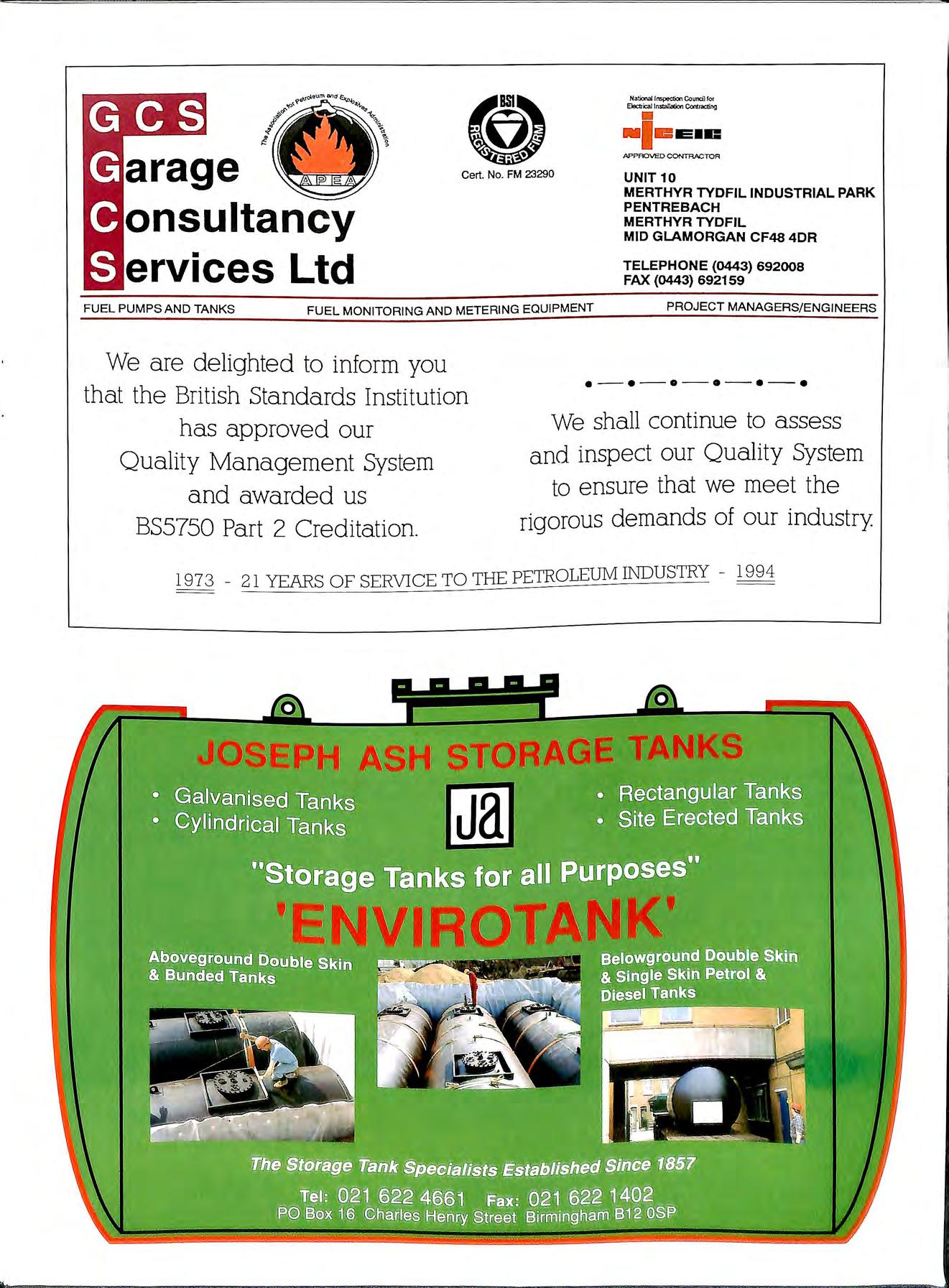
GCS G c s a rage onsultancy ervices Ltd Cert. No. FM 23290 Nafur.al Inspection Coun:::il for ElectricallnstallationConl:racting UNIT 10 MERTHYR TYDFIL INDUSTRIAL PARK PENTREBACH MERTHYR TYDFIL MID GLAMORGAN CF48 4DR TELEPHONE (0443) 692008 FAX (0443) 692159 FUEL PUMPS AND TANKS FUEL MONITORING AND METERING EQUIPMENT PROJECT MANAGERS/ENGINEERS We a.re delighted to inform you tha.t the British Sta.nda.rds Institution ha.s approved our Quality Management System a.nd a.warded us BS5750 Part 2 Credita.tion. ·-·-·-·-·-· We shall continue to assess and inspect our Quality System to ensure that we meet the rigorous demands of our industry 1973 21 YEARS OF SERVICE TO THE PETROLEUM INDUSTRY 1994
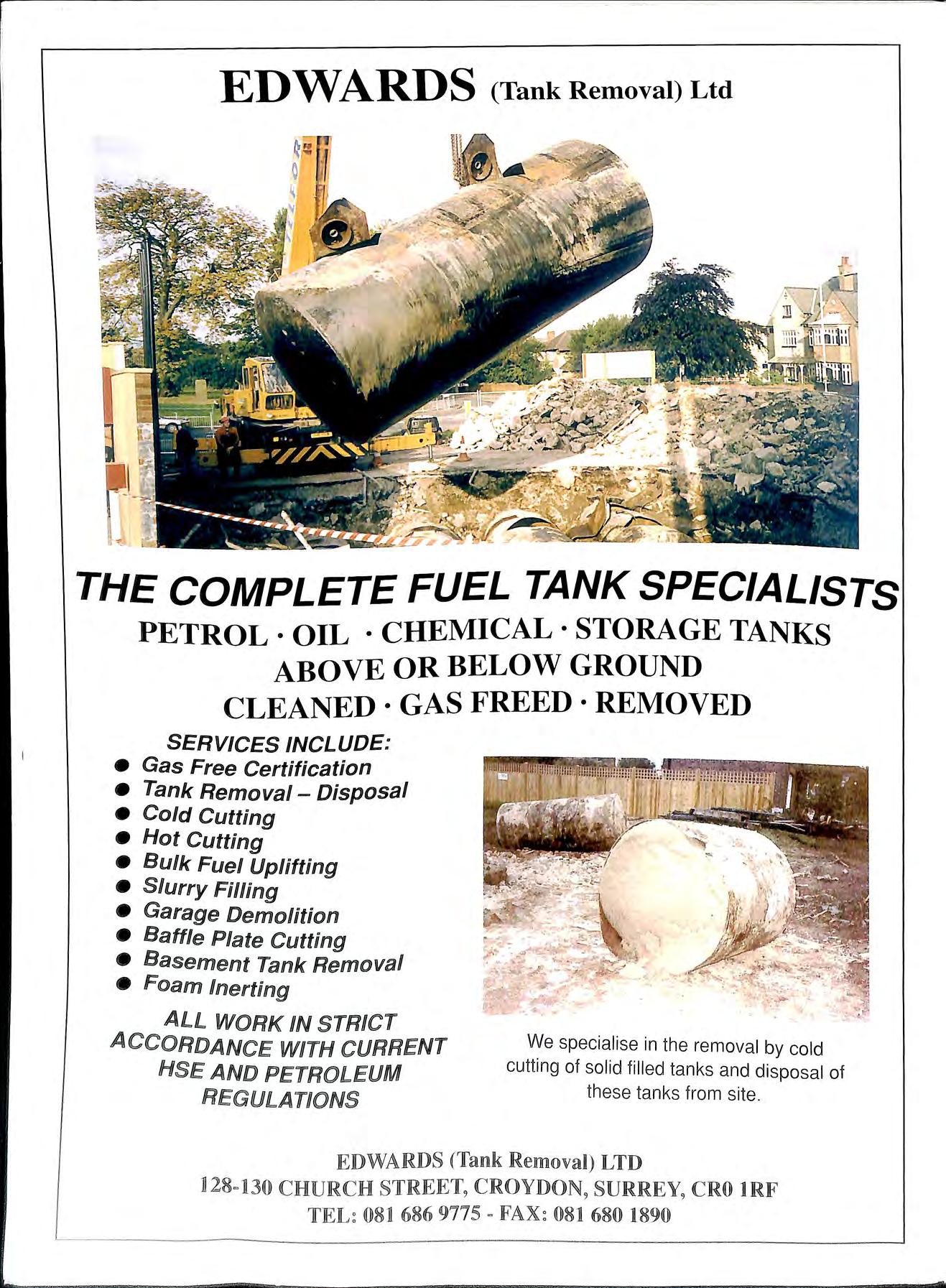
ED WARDS (Tank Removal) Ltd THE COMPLETE FUEL TANK SPECIALISTS PETROL · OIL · CHEMICAL · STORAGE TANKS ABOVE OR BELOW GROUND CLEANED·GASFREED·REMOVED S ER VI C E S INCLUDE: • Ga s Fre e C ertifi cation • Ta n k Re mova l - Disposal • Cold Cu t ting • Hot C u tting • Bulk Fuel Upli ft ing • Slurry Filling • Garage Demolition • Baffle Plate Cutting • Basement Tank Removal • Foam lnerting ALL WORK IN STRICT ACCORDANCE WITH CURRENT HSE AND PETROLEUM REG ULATI ONS We specialise in the removal by cold cutting of solid filled tanks and disposal of t hese tank s from site .EDWARD§ (Tank Removal) LTD ] Jl 30 CHURCH STREET, CROYDON, §URREY9 CRO 1RF mn 686 9775 mn 680 1890
ENVIROFLEX: For fuel delivery. Total secondary containment for suction or pressure systems, or Monoflex for direct burial suction systems. Easy to install and maintain, compatible with all fuels and additives currently on the market. UL listed.
For offset-fill , vent and vapour recovery. Robust and easy to use, this leak-free petrol and additive resistant system is based on Durapipe 's patented electrofusion jointing method .

from
NEW
from TOTA L CONTAINMENT INC.
and SUPPLIED BY THE DISTRIBUTORS for further information cm either, or both, of these products call FORECOURT EQUIPMENT SPECIALISTS PURFLEET COMMERCIALS LIMITED 520 London Road West Thurrock Esse x RM 16 1BE. Tel : (0708) 863931 Fa x: (0 708 ) 868 226
It you were losing
chocolate bars a year
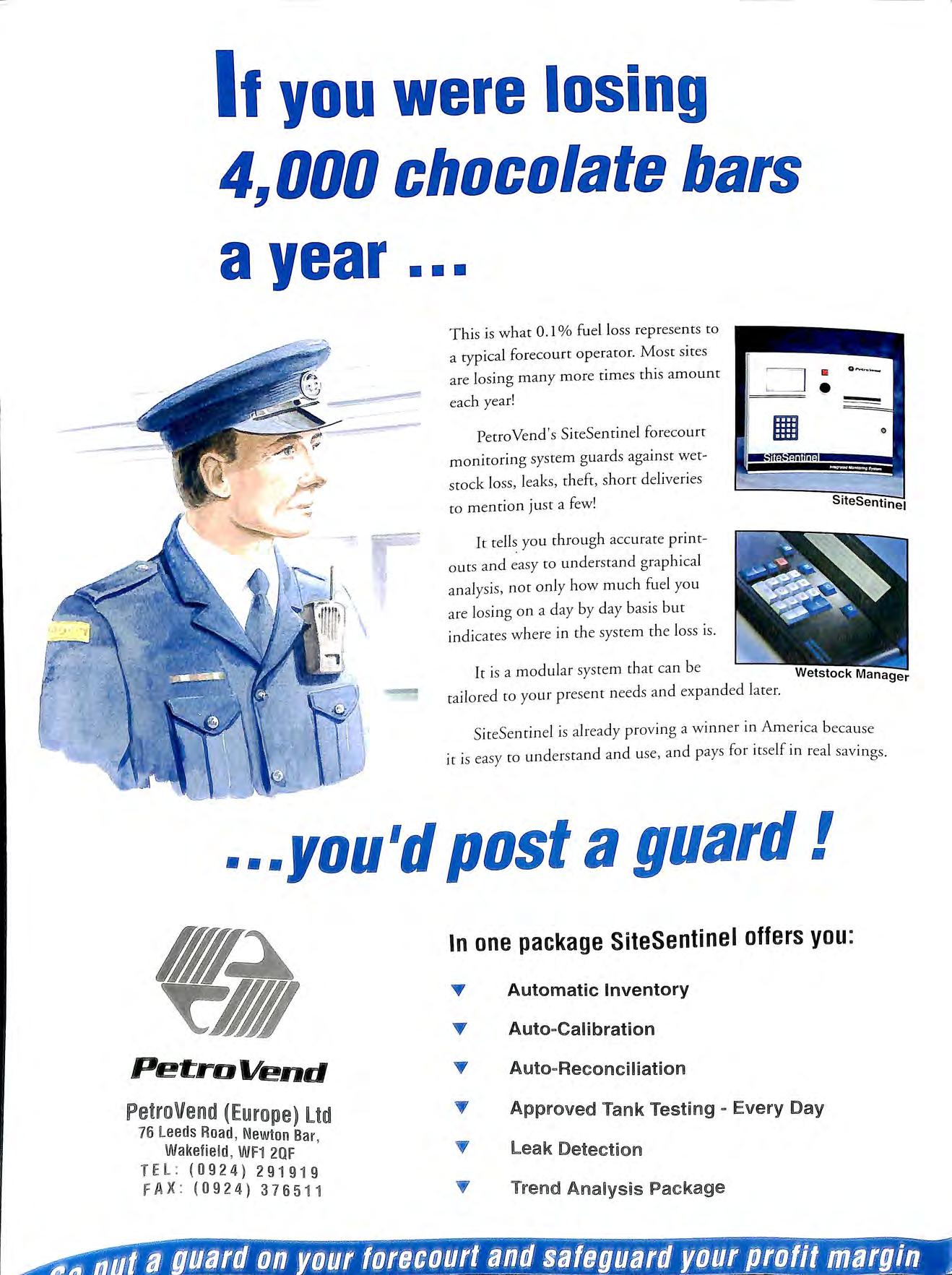
•••
This is w hat 0.1 % fuel lo ss represents to a typical forecourt operator. Most sites are losing many more times this amount each year!
Perro Vend' s Si teSentinel forecourt monitoring system guards against wetstock loss, leaks, theft, shore deliveries co mention just a few! SiteSentiner
It cells you throu gh accurate printouts and easy to understand graphical analysis, not only how much fuel you are losing on a day by day basis but indicates where in the system th e loss is.
It is a modular sys tem th at can be tailored to your present needs and expanded lacer.
SiteSentinel is already provin g a winne r in Am erica b eca us e
is easy to understand and use, and pays for itself in rea l savings
4!1000
I mo "llm."f:'lilllm'I 0
... you'd past a guard! In one package SiteSentinel offers you: .... Automatic Inventory ... Auto-Calibration Petro I/end .... Auto-Reconciliation Ud ... Approved Tank Testinig - Every Day 76 Leeds Road, Newton Bar, Wakefie l d, WF1 20F T l eak Detection TEL : (0924) 291919 F AX : (0924) 376511 .., Trend Analysis Package
it
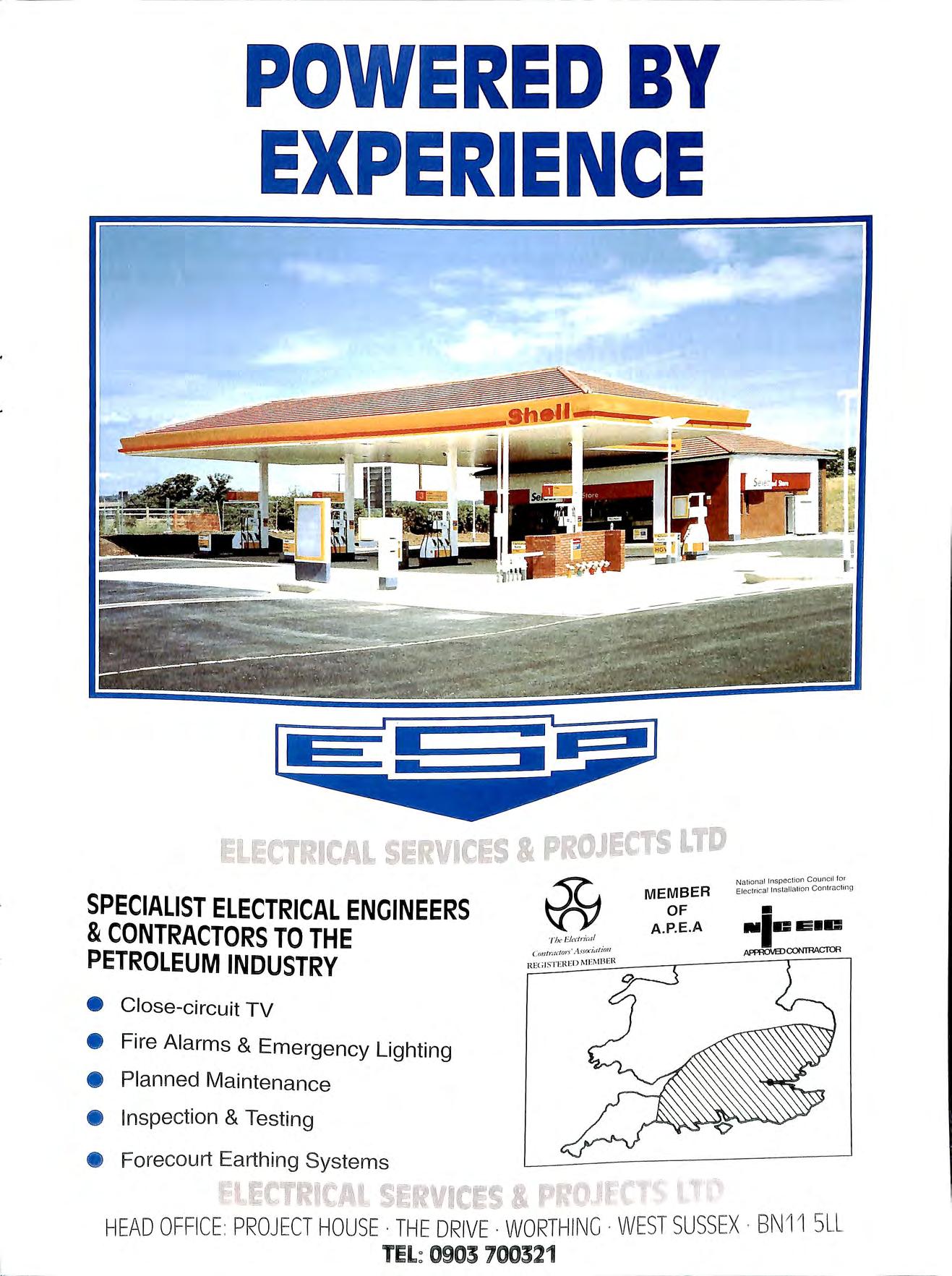
POWERED BY EXPERIENCE c s SPECIALIST ELECTRICAL ENGINEERS & CONTRACTORS TO THE PETROLEUM INDUSTRY • Close-circuit TV • Fire Alarms & Emergency Lighting • Planned Maintenance • Inspection & Testing • Forecourt Earthing S ystems S & OJEC Cv11t n1do r s' ;\ssoc1i1tin11 REl;iSTEHE D i\ fEi\ !HEll LTD MEMBER OF A.P.E.A National Inspec tion Council for Elec tr cal Installation Co ntractin g • •1c&1c APffiCMDCONTRACTOR HEAD OFFICE : PROJECT HOUSE · THE DRIVE . WORTHING · WEST SUSS EX · BN11 SLL TEL: 0903 700321
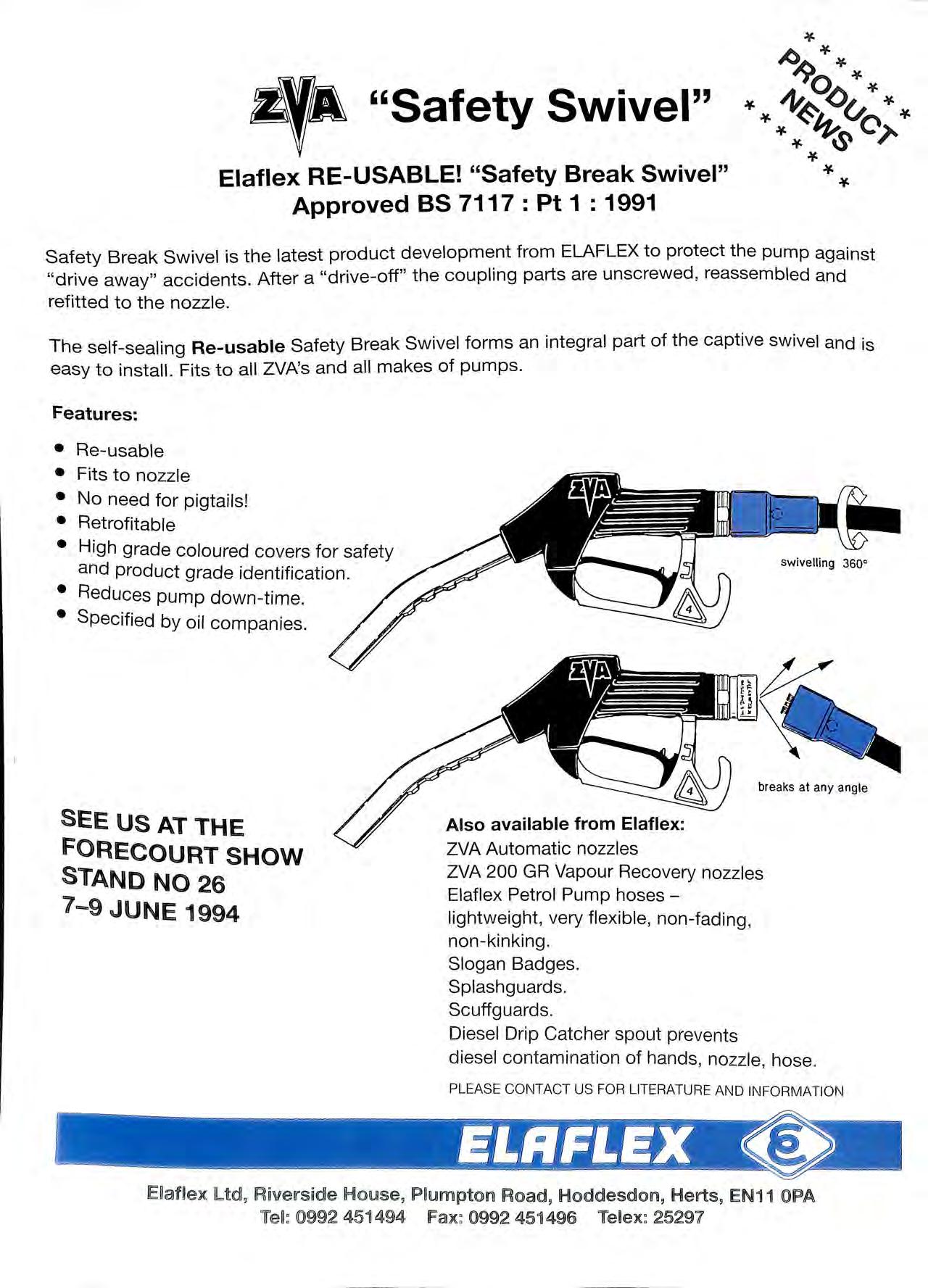
zy1A "Safety Swivel" Elaflex RE-USABLE! "Safety Break Swivel" Approved BS 7117 : Pt 1 : 1991 Safety Break Swivel is the latest product development from ELAFLEX to protect the pump against " drive away" accidents. After a "drive off" the coupling parts are unscrewed, reassembled and refitted to the nozzle. The self-sealing Re-usable Safety Break Swivel forms an integral part of the captive swivel and is easy to install. Fits to all ZVA's and all makes of pumps. Features: • Re-usable • Fits to nozzle • No need for pigtails! • Retrofitable • High grade coloured covers for safety and product grade identification. • Reduces pump down-time. • Specified by oil companies. SEE US AT THE FOREC OURT S HOW STAN D NO 26 7-9 JUNE 1994 br eaks at any angle Also available from Elaflex : ZVA Automatic nozzles ZVA 200 GR Vapour Recovery nozzles Elaflex Petrol Pump hoses lightweight, very flexible, non-fading, non-kinking Slogan Badges Splashguards Scuffguards Diesel Drip Catcher spout prevents diesel contaminat ion of hands , nozzle , hose PL EAS E CONTAC T US FO R LITERATURE AN D INFORMAT IO N ltdi Riveirs ode H o 1UJ sei Ro adi H oddesdoni Herts i EN11 OPA 0992 45 1494 Faix: 0992 45 1496 Telex : 25297
Talking Point
As this edition goes to press, the whole Industry has united on all sides to fight the proposals made by the Department of Environment for the enforcement of the proposed VOC Emission Directives on stage 1. The D of E changed its mind and proposed not only a change of enforcing agency to the environmental health officer but has suggested this cost be borne by industry.
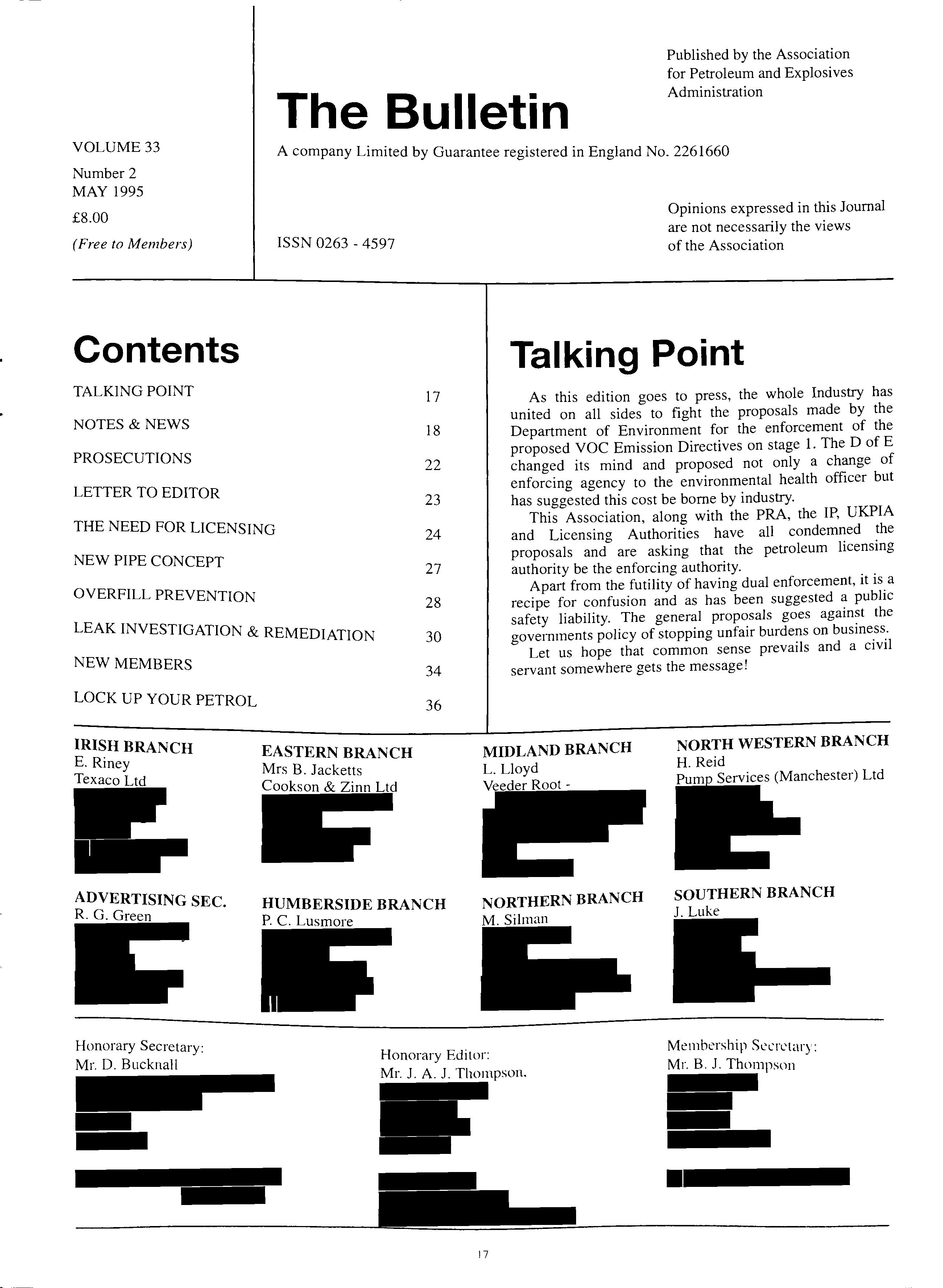
This Association, along with the PRA, the IP, UKPIA and Licensing Authorities have all condemned the proposals and are asking that the petroleum licensing authority be the enforcing authority.
Apart from the futility of having dual enforcement, it is a recipe for confusion and as has been suggested a public safety liability. The general proposals goes against the governments policy of stopping unfair burdens on business.
Let us hope that common sense prevails and a civil servant somewhere gets the message!
VOLUME33 Number2 MAY 1995 £8.00 (Free to Members) Contents TALKING POINT NOTES&NEWS PROSECUTIONS
TO EDITOR The Bulletin Published by the Association for Petroleum and Explosives Administration
company Limited by Guarantee registered in England No. 2261660 ISSN 0263 4597 17 18 22 23
LETTER
A
Opinions expressed in this Journal are not necessarily the views of the Association
THE NEED FOR LICENSING 24
NEW PIPE CONCEPT 27 OVERFILL PREVENTION 28 LEAK INVESTIGATION & REMEDIATION 30
NEW MEMBERS 34
LOCK UP YOUR PETROL IRISH BRANCH E. Riney Texaco Ltd ADVERTISING SEC. R. G. Green Honorary Secretary: Mr. D. Bucknall EASTERN BRANCH Mrs B. Jacketts Cookson & Zinn Ltd 36 HUMBERSIDE BRANCH P. C. Lusmore MIDLAND BRANCH L. Lloyd Veeder Root NORTHERN BRANCH M. Silman Honorary Editor: Mr. J. A. J. Thompson. 17 NORTH WESTERN BRANCH H. Reid Pump Services (Manchester) Ltd SOUTHERN BRANCH J. Luke Membership Sl."crctary: Mr. B. J. Thompson
REQUIRES
INDUSTRY
The Association is currently playing a key role in shaping guidance for the safe keeping. of spirit at filling stations and is now looking to provide administrative support for its working groups, branches and council members.
In addition to this administration work, which will be interpretative as well as of a servicing nature, it is expected that the successful applicant will our databases and training programme and and advice to the council of the associat10n on maintaining its lead position.
This will be a challenging and exciting new position. Applicants will need to have excellent organisational and word processing skills and be able to present information and documents to a high standard.
Initially it is anticipated that the successful applicant will work from home and it is recognised that some help with office equipment may be needed.
A full driving licence and own transport would be an advantage.
The salary for this post which will be on a 2 year contract will be in the range of£ 11,250 -£ 13,000.
Please send C.V. to:Mr D. W. Bucknall
Humberside County Council,
If you wish to have a talk about this position please above. The closing date for applications 1 be Fnday the 30th June 1995.
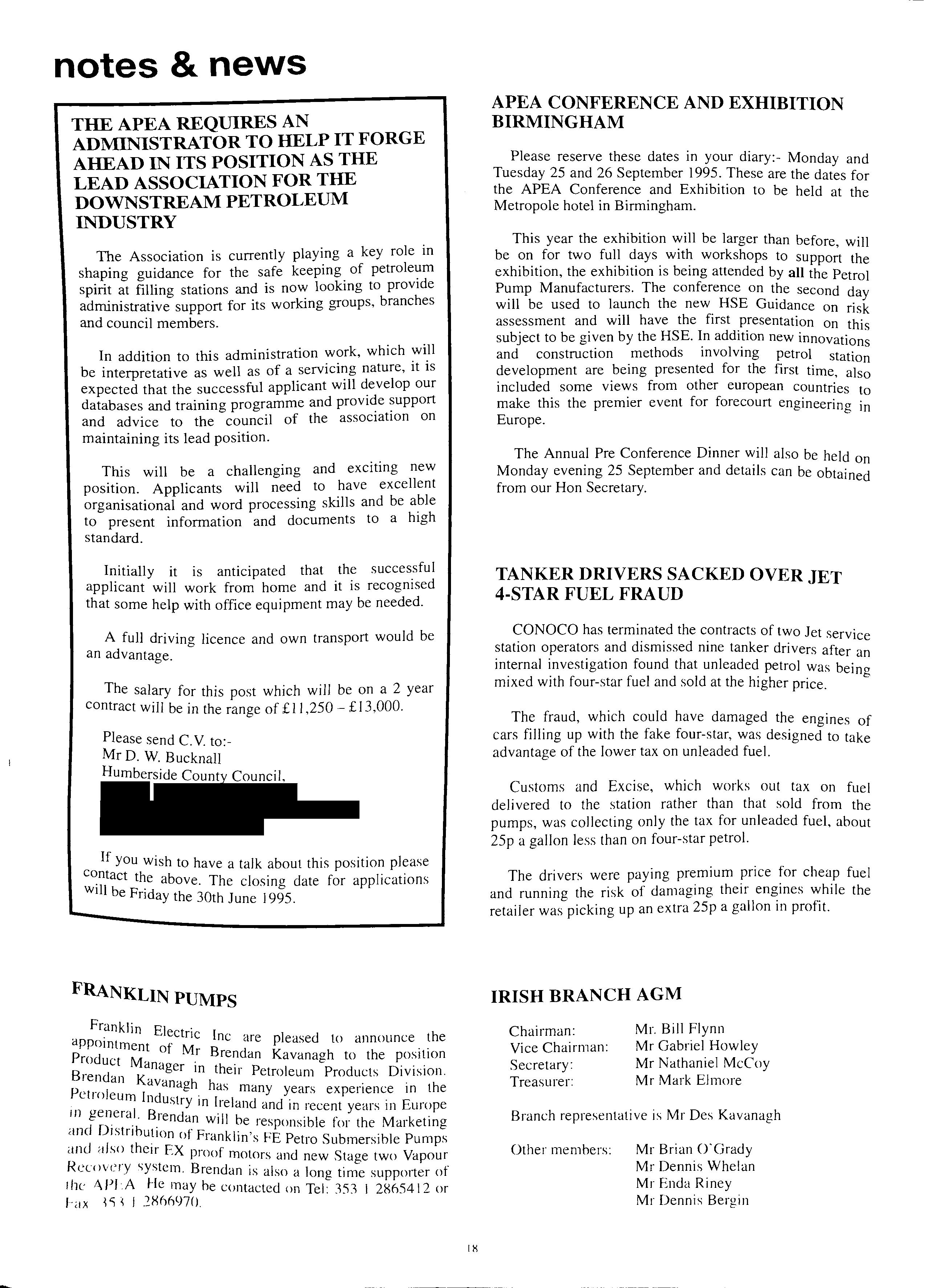
FRANKLIN PUMPS
Franklin EI appointm ectnc Inc are pleased to announce the Product M.r Kavanagh to the Brendan K· lil their Petroleum Products D1v1s10n. Petroleum I has many years experience in the . n ustry lil Ireland and in recent years in Europe 111 gen.era.I. B_rendan will be responsible for the. Marketing <tnd D1stnbut1on of Frankl1.n'. FE p . S b ··bi p . d J h . s et10" u mers1 e umps an a so I e1r FX )) · f . • 100 motors and new Stage two Vapour Recovery system. Brendan is also a long time supporter of lhe APJ-·.A He may he contacted on Tel: 353 I 2865412 or htx i;; I 2866970.
APEA CONFERENCE AND EXHIBITION BIRMINGHAM
Please reserve these dates in your diary:- Monday and Tuesday 25 and 26 September 1995. These are the dates for the APEA Conference and Exhibition to be held at the Metropole hotel in Birmingham.
This year the exhibition will be larger than before will be on for two full days with workshops to the exhibition, the exhibition is being attended by all the Petrol Pump Manufacturers. The conference on the second day will be used to launch the new HSE Guidance on risk assessment and will have the first presentation on this subject to be given by the HSE. In addition new innovations and construction methods involving petrol station development are being presented for the first time, also included some views from other european countries to make this the premier event for forecourt engineering in Europe.
The Annual Pre Conference Dinner will also be held on Monday evening 25 September and details can be obtained from our Hon Secretary.
TANKER DRIVERS SACKED OVER JET 4-STAR FUEL FRAUD
CONOCO has terminated the contracts of two Jet service station operators and dismissed nine tanker drivers after an internal investigation found that unleaded petrol was beino mixed with four-star fuel and sold at the higher price. "'
The fraud, which could have damaged the engines of cars filling up with the fake four-star, was designed to take advantage of the lower tax on unleaded fuel.
Customs and Excise, which works out tax on fuel delivered to the station rather than that sold from the pumps, was collecting only the tax for unleaded fuel, about 25p a gallon less than on four-star petrol.
The drivers were paying premium price for cheap fuel and running the risk of damaging their engines while the retailer was picking up an extra 25p a gallon in profit.
IRISH BRANCH AGM
notes & news
THE APEA
AN ADMINISTRATOR TO HELP IT FORGE AHEAD IN ITS POSITION AS THE LEAD ASSOCIATION FOR THE DOWNSTREAM PETROLEUM
IK
Chairman: Vice Chairman: Secretary: Treasurer: Mr. Bill Flynn Mr Gabriel Howley Mr Nathaniel McCoy Mr Mark Elmore Branch representative is Mr Des Kavanagh Other members: Mr Brian ()"Grady Mr Dennis Whelan Mr Enda Riney Mr Dennis Bergin
EUROPEAN PETROLEUM ENGINEERING EXHIBITION & CONFERENCE
BERLIN 6 -8 APRIL 1995
The APEA recently assisted exhibition organisers Expoconsult with arrangements for the conference at the above event. The APEA also took a stand at the E.P.E. Exhibition to promote the Association.
The conference was held over two half day sessions and on each day was attended by over forty delegates from 14 countries.
Speakers at the Thursday afternoon programme were:
Bernard Barnette of Elf Antar, France with a presentation on Transportable Service Stations for Europe;
Jamie Thompson of L.F.C.D.A., UK with a presentation on the need for Common Safety Standards at European Service Stations;
Richard Smith of Marley Pumps, USA with a presentation on the advantages of using Submersible Pumping Systems.
Speakers at the Friday morning programme were: Jari from Finland with a presentation on the of underground elements of the service station;
Dr Falckenberg of Elaflex, Germany with a presentation of the current developments with Stao-e 2 Vapour Balancing; e
John of Groundwater Technology Ltd., UK with a presentation on Leak Investigation and Cost Effective Cleanup.
The exhibition was held alongside two other exhibitions over three days, although only 23 stands were present in the E.P.E. hall other specialist forecourt equipment exhibitors were to be found in the adjacent Tankstelle exh1b1t1on (similar to the UK Forecourt Show).
APEA stand attracted a large variety of v1s1tors 111clud111g those members visiting the exhibition from the l!K and mainland Europe. A number of new members were signed up at the exhibition with several more people taking _the APEA Info packs for consideration. Several of the present expressed an interest in the possibility of c1ttend111g the APEA exhibition in September.
HEALTH AND SAFETY AT WORK ETC. ACT 1974; PETROLEUM LICENCE APPEAL. VIEWS FARM, GREAT MILTON, OXFORDSIDRE. DETERMINATION
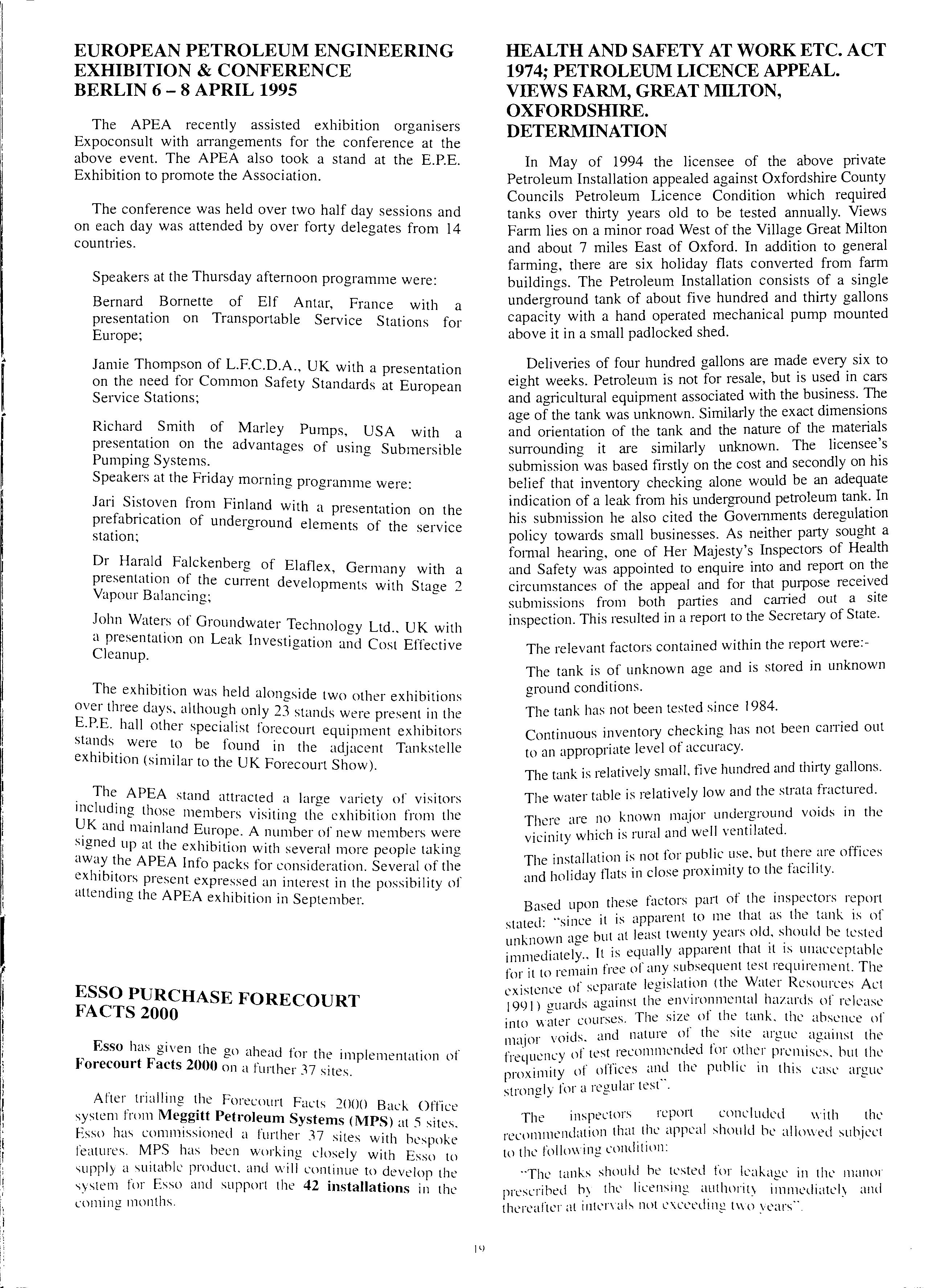
In May of 1994 the licensee of the above private Petroleum Installation appealed against Oxfordshire County Councils Petroleum Licence Condition which required tanks over thirty years old to be tested annually. Views Farm lies on a minor road West of the Village Great Milton and about 7 miles East of Oxford. In addition to general farming, there are six holiday flats converted from farm buildings. The Petroleum Installation consists of a single underoround tank of about five hundred and thirty gallons capacity with a hand operated mechanical pump mounted above it in a small padlocked shed.
Deliveries of four hundred gallons are made every six to eight weeks. Petroleum is not for but is in cars and agricultural equipment associated with the !he age of the tank was unknown. Similarly the exact dimensi?ns and orientation of the tank and the nature of the matenals surroundino it are similarly unknown. The licensee's submissionewas based firstly on the cost and secondly on his belief that inventory checking alone would be an adequate indication of a leak from his underground petroleum tank In his submission he also cited the Governments deregulation policy towards small businesses. As neither party sought a formal hearing, one of Her Majesty's Inspectors of Health and Safety was appointed to enquire into and report on. the circumstances of the appeal and for that purpose submissions from both parties and carried out a site inspection. This resulted in a report to the Secretary of State.
The relevant factors contained within the report were:The tank is of unknown age and is stored in unknown ground conditions.
The tank has not been tested since 1984.
Continuous inventory checking has not been carried out to an appropriate level of accuracy.
The tank is relatively small, five hundred and thi1ty gallons. The water table is relatively low and the strata fractured. There are 110 known nu\jor under?round voids in the vicinity which is rural and well ventilated.
TI · ·t ll·it1011 is not for public use. but there are offices 1e ms a ' T and holiday flats in close prox11111ty to the tac1 ity.
ESSO PURCHASE FORECOURT FACTS 2000
Esso has oiven the 0() ahead t· th . I . 1 e e , or e imp ernentat1on o · Forecourt Facts 2000 on a further 37 sites.
After trialling the Forecourt Facts 2000 Back Office system from Meggitt Petroleum Systems IMPS) at 5 sites. has commissioned a 37 sites with bespoke features. MPS has been work111g closely with Esso to -;upply a_ suitable product. and will continue to develop the -;ystem tor Esso and support the 42 installations in the corning months.
Based upon these factors part of the inspectors cl · 1ce 1 "t is ·ipparent to me that as the tank 1s nl state : s11 • ' k aoe but at least twenty years old, should be tested un nown ' e ' · · cl". tely It is equally apparent that 1t 1s unacceptable 1111me 1a ·· · . for it to remain free of any test requirement. The · t e C)I. s•'p·11·,·1te leoislat1on (the Water Resources Act ex1s enc · ' e 1991 ) guards against the hazards of release into water courses. The size_ ol the_ tank. the absence of · \. 01·cts· ,·111d nature ot the slle argue against the ma101 · · of test recommended tor prl'm1ses. but thl' proximity of offices the public 111 this case argue strongly for a regular test .
The inspectors report concluded with tht' recommendation that the appeal should he allowed subject to the following t'omlitiPn:
·The tanks should he tested for leakage in the manor prescribed hy the licensing a_uthority and thereafter al in ten als not t'xcccd111g two years".
I I i I I
Jl)
PILLOWS
Oil absorbent pillows are used throughout industry to collect floating oil in interceptors and drainage culverts. The pillows attract and absorbs oil until they are an unsightly hazardous mess which has to be carefully removed and incinerated.
Formula One Bioremediation Pillows are impregnated with oil digesting bacteria and will preferentially absorb oil and cause accelerated breakdown of absorbed hydrocarbons under bacterial action. Under normal interceptor conditions the pillows remain clean and exhausted pillows are easily disposed of since the oil and grease is rendered harmless by bacterial action.
Designed for continuous absorption of small amounts of oil but may also be used to absorb excess oil from casual spillage.
Technical Information
The pillows are constructed from specially treated oleophillic properties together with hydrophobic filament yarn. The choice of fibre and the construction has been optimised to give an exceptionally high void volume of 9_2% for maximum absorption. The hydrophobic, anti-static fibre treatment enables all the void volume to be used for absorbing oil whilst in contact with water.
. bonding provides high tensile strength, dimensional stability and prevents breakdown when fully w.ith oil. Nutrients support the action of natural bactena m promoting degradation of absorbed oil and grease.
. The enhanced naturally occurrina bacteria used in the pillows evolved from trials carried on the Exxon Valdez in Prince William Sound, Alaska in I989. They are used t . . b · ex ens1vely m the USA for auamented ioreclamatio f rf o b n o su ace 011 contaminated soil. They have approved by the US Environmental Protection Aaency n.) and a r . b Na re Isted 111 the Emergency Response files of the t1onal Contingency Plan (NCPJ.
Other features:-
• Easily install d d . P d. · e an needs no mamtenance other than eno 1c repla ( cement approx. every 6 months)
• Product is saf d · ·' e an needs no Haz-chem labelling
• Non toxic
• Easy t d" 0 Ispose of after use
Further inform t" 537. Ascot a.ion. Formula One Marketing, PO Box · Bei kshire. SLS 9TP. Telephone 01344 484965.
DESIGN AND OPERATION OF TRUCK COMPUTER SYSTEMS FOR ROAD TANKERS
Model Code of Safe Practice Part 20
The demand for road tanker on-hoard computer (OTC! '-V<.,lt"llJs JS. developing rapidly in Europe OTC systems llli<"JI <He with equipment al loading terminals and al service
stations, provide tractor/trailer monitoring and control, and transmit data to central point for routing, despatch control, invoicing etc. Since most petroleum terminals and some service stations cater for more than one road tanker operator, guidelines are required to ensure the maximum degree of compatibility and safe operation of the OTC equipment being installed by the various users.
This Code of Practice has therefore been prepared with the active participation of representatives drawn from both European oil industry and OTC equipment manufacturers. It provides guidance on the design and operation of truckbased OTC systems. Adherence to its recommendations will enable systems to be compatible and provide a hiah degree of interoperability without applying unreasonable constraints or inhibiting further technical development.

0471957097 104pp January 1995 £65.00 Available from the Institute ofPetroleum, London, UK.
NORTH WEST BRANCH - ANNUAL GENERAL MEETING
Twenty-two members attended the North West branch AGM on 21.3.95. In the business section of the meeting, the following were elected
Chairman: Mr Mel Churm (Cameron Technical Services Ltd)
Secretary: Mr Harry Reid (Pump Services (Manchester) Ltd)
Treasurer: Mr J O'Reilly (Pump Services (Manchester) Ltd)
Branch Rep: Mr H Reid (Pump Services (Manchester) Ltd)
Committee: Mr Mike Marczynski (Tankclean Ltd) Mr Martyn Jowett (Cheshire Fire Brigade)
A presentation was given by Mr John Stevens, Operations Manager North, of Groundwater Technology Ltd covering site contamination and remediation techniques available to carry out site clean ups. The suitability, effectiveness, timescale and cost of the different approaches were presented. Lively discussion followed concerning responsibility, authority and risk when confronted with site leakage and contammat10n. This was a new subject for the branch and proved to be of interest and value to the members.
Harry Reid updated the members on the progress of the new guidance to replace HS( G J41 . This covered the work done to date, the scope and format of the Technical Coordinating Body guidance document. the sectors that are dealing with the various subjects which are to be included in the document, a record of the meetings held (and those planned, and risk assessment. This generated a great deal of valuable discussion and exchange of ideas between licensing authorities and contractors.
The next meeting is scheduled for the 14th June when the main will he from ERA Technology and will include a summary of the services they provide and rrincipal areas of expertise. test and assessment for forecourt machinery. and testing polymer pipev. ork for rurol station usage .
BIOREMEDIATION OIL ABSORBENT
'.II
CANOPY CLADDING A FLAMING NUISANCE?
There has been reported d of extruded a . I' b . a gia ual mcrease 111 the amount boxes and y tc emg used on canopy cladding, lighting use of e t"' dedral signage 111 the petrol station market. The x ru e acryhc d followin was con emned some years aao g a small fire 01 1 f "' rapid ly 1 a pet1 o orecourt whJCh spread ac1oss a cano . 1 dropping 1 PY igmtmg t 1e acryhc and then mo ten streai f h · forecourt Th _ . ' ns. o. t e matenal across the advice to. b e 1esult111g mc1dent caused the following <>enerall e given to the Industry by the HSE and this was "' y accepted by everyone as a sensible step forward.
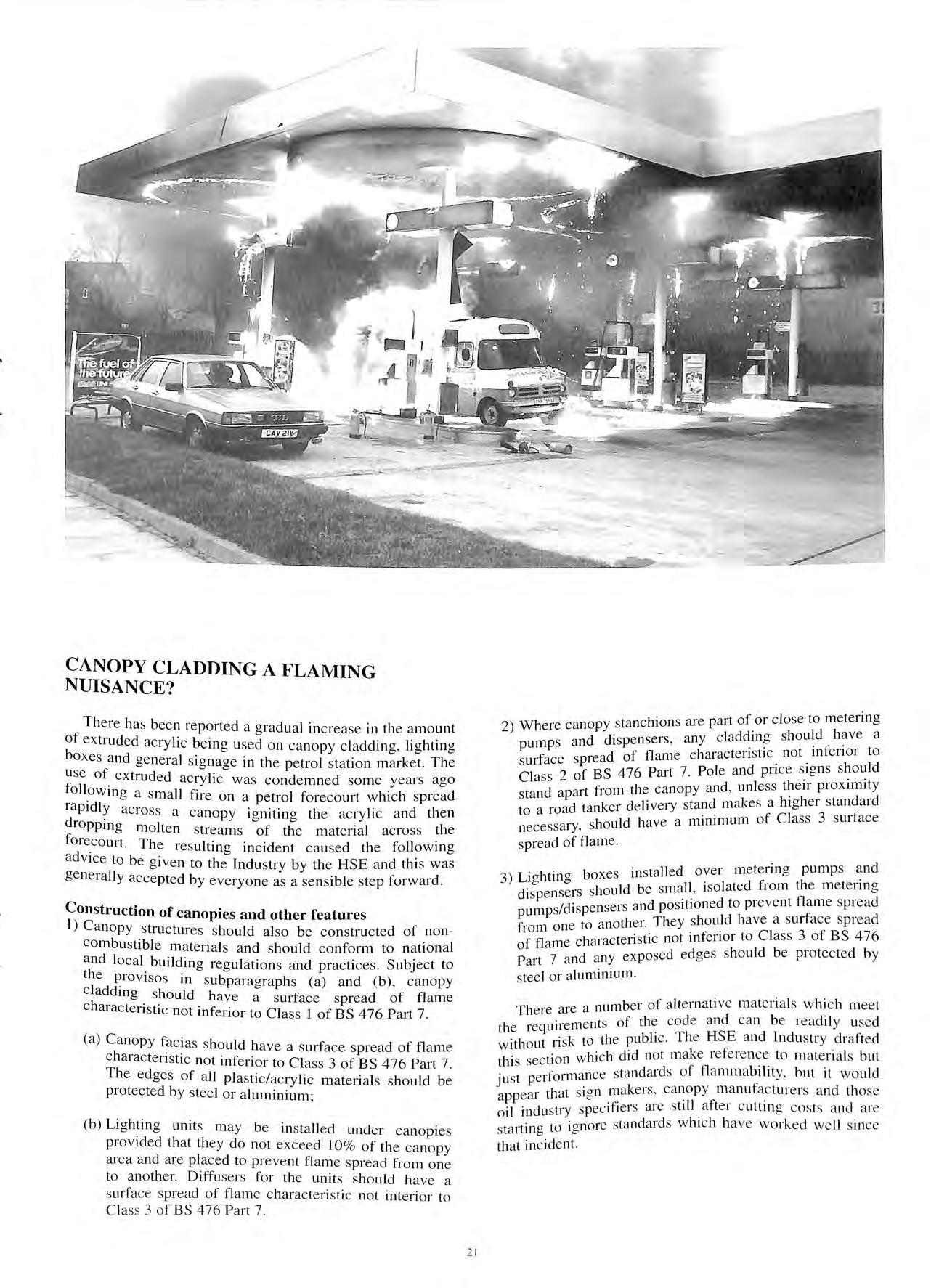
Construction of . I) C canopies and other features
c~i~~~i~ti~\~ctures_. shou ld also be constructed of non- and local b ials and should conform to national the p. Ll1 mg regulations and practices. Subject to I OVISOS 111 sub h cladding sh Id pai·agrap s_ (a) and (b), canopy charactei;sticou . have a surface spread of flame not mfenor to Class 1 of BS 476 Part 7.
(a) Canopy facias sho Id characteristic uf have a surface spread of flame The edges 111 en?r to Cl.ass 3 of BS 476 Part 7. protected b t 11 pl_ast1c/~cryhc material s should be Y s ee 01 aJumm1um;
(b) Lightin<> units ma b . "' y e mstalled under cano ies provided that th ey do not exceed l 0'11 f I p area and are placed to preven t flame 1ef.canopy to anoth o·r+ 1om one er: t .u sers for the units should have a su1 face sp1ead of flame characterist ic not interi o. t Class 3 of BS 476 Part 7. 1 0
2) Where canopy stanchions are part of or close to metering pumps and dispensers, any cladding should have a surface spread of flame characteristic not inferior to Class 2 of BS 476 Part 7. Pole and price signs should stand apart from the canopy and , unless their proximity to a road tanker delivery stand makes a higher standard necessary, shou ld have a minimum of C lass 3 surface spread of flam e
3) Lighting boxes installed over metering pumps and dispensers should be small , isolated from the metering pumps/dispensers and positioned to prevent flame spread from one to another. They should have a surface spread of flame characteristic not inferior to Class 3 of BS 4 76 Part 7 and any exposed edges should be protected by steel or aluminium.
There are a number of alternative mate ri als which mee t the requirements of the code and can be readily used without risk to the pubhc. The HSE and Indu stry drafted th is section which did not make reference to material s but just perform ance standard s of flammabilit y, but it would appear that sign makers, canopy manufacture rs and those oil industry specifiers are still after c utting costs and are starting to ignore sta ndards which hav e worked we ll sin ce that incide nt.
.J
2 1
Prosecutions
EXPLOSIVES (FIREWORKS) PROSECUTION
At Gloucester Magistrates Court on 13th March 1995 Mohammed Amjad Shafi pleaded guilty to the supply of fireworks to a boy under the age of 16 on the 27th October 1994, contrary to the Fireworks (Safety) Regulations 1986. Mr Shafi was fined £500.
The prosecution was a result of a survey carried out by the Trading Standards Department of Gloucestershire County Council. A 13 year-old boy, under strict supervision of Trading Standards officers, entered Mr Shafi's shop and he chose a selection box of fireworks for £4.95. He was not asked his age or for any identification, he was obviously under the age of 16, and Mr Shafi should not have made the sale.
MOBIL OIL SUBSIDIARY IN COURT
Prime Garages Limited were recently prosecuted by Essex County Council Trading Standards for offences under The Petroleum (Consolidation) Act 1928 Section 1(3) and The Health & Safety Act 1974 Section 33(3).
A Petroleum Officer was called to the company's Witham premises in an attempt to find a petroleum leakage as a manhole was contaminated with persistent petroleum vapour.
A contractor on the site found a length of box section meta! which had been jammed into the overflow pipe thus keepmg permanently open the overflow valve.
'!'he company were unable to provide the required site register to identify notification of work to be carried out or the contractor concerned.
_The company were represented by Counsel and pleaded guilty to a breach of the site licence conditions.
They f" Wit med £300 with £ 150 prosecution costs at ham Magistrates' Court on 15th March 1995.

YORKSHIRE & HUMBERSIDE BRANCHAGM
its TAhe Yorkshire & Humberside Branch of the APEA held nnual Gen I M . SYFRS T . . era eetmg on 28th March I 995 at the rammg Centre, Sheffield.
The meeting corn was attended by thirty members and menced with th b . . reports and 1 . e usmess which included the were all r _ le ection of the officers. The serving officers e e ected to serve the Branch again for 1995/96:
Chairman
Treasurer
Secretary & Branch Representative Auditor
Clive Sweeting David James Philip Lusmore Peter Walker
After the business meeting there followed a seminar on tank and pipework testing with local tank testing companies
A local authority viewpoint on the H:4uirement for testing was also given. At the conclusion of 1hl' presentations a yuestion time session was held in which 1lw llll:"lllbers keenly participated. The meeting closed with I lw < ha1nnan thanking the speakers and memhers for a very , 11il1w,1<1st11
OPW61- SO 400C VAPOUR TIGHT OVERFILL PREVENTION VALVE
US Manufacturers of Overfill Prevention Valves, have been required to provide a vapour-tight version to fulfil CARB and San Diego Air Pollution Control District Regulations.
It should be noted that these areas mandate both Stage J and Stage 2 Vapour Recovery on all service stations, and the requirement for vapour tight OPV's is to specifically minimise Fugative Hydrocarbon Emission, rather than to solve UST vapour pressure problems caused by inefficient Stage 1B manifolded systems.
Both the CARB test and the San Diego Test require a 90 day pressure decay trial, and the San Diego test is considered the more vigorous, requiring a so called "10 inch" test over 90 days. This entails installing the valve leaving for 90 days, and then testing the whole system fo; vapour leakage under I O" wcg pressure. Zero leakage is required.
To date, only ONE manufacturer has achieved both the CARB and the San Diego Certification. The OPW 61 so 400C successfully passed the latter in December I 994 and is now available for installation in the UK.
What was a very minimal leak path, through the float linkage, has been solved by modifying the dynamic sealing arrangement in the internal pivot and shaft area. In addition, cold weld bonding compound is supplied for installing top and bottom tubes.
Specifiers of Overfill Prevention Valves should check that the valve they are installing has been certified vapour tight to the above Approval Standards.
It is also worth recording, that the OPW 6 I SO overfill Prevention Valve, continues to be the single most reliable mechanical valve on the market, with a reliability record directly proportional to the quality of the installer.
LINK HAMPSON THE DISTRIBUTION CHAIN IS RE-FORGED
Link Hampson. a division of UTC, has built an enviable reputation, over the last thirty-five years, for the supply _of quality parts to the petroleum forecourt industry. Our aim has always been to provide the best possible equipment. and the best customer service, to the UK Retail market.
Link Hampson has recently restructured its organization to optimize this approach. Alan Gee retired at the end of March after 30 years sterling service with Link Hampson. David Brewer is now concentrating on the OPW range of Distribution products.
We have recently recruited Ged Norris who will focus his efforts on the Retail side of our business, Ged was previously with Emco Wheaton for more than twenty years and has considerable experience in the petroleum industry. He is presently serving as chairman of the PVE/1 in panel. which formulates the official UK viewpoint on m erfill prevention devices for the European standard which is currently being drafted,
ll
Link Hampson represent OPW Fuelling Components and EBW International , both of whom are leading manufacturers in the Retail sector. Our mi ssion is to provide comprehensive and innovative solutions, fast efficient service and technically superior products for the safe handling of petroleum liquid and vapour. Whether you require the latest information on vapour-tight overfill valves , or advice on installation of Stage lB vapour recovery equipment to comply with the EC directive , Link Hampson will be able to help you.
Letter to the Editor
Dear Sir,
I noted with great interest the report of pipe joint failur e s in polyethelene pipe which featured in the February issue As we were involved rn one of the two site s I feel some further information would be of interest to your readers.
We , as cont1:actors, put together the original offset fill sy stem e arly in 1993 On completion of the works the system as a whole failed to hold pre ssure. Despite several te sts being applied it ultimately would not pass the test required by the local Petroleum Officer.
The manufacturer of the pipework s ystem decided to replace the offset fill s in their entirety, a differe nt sy ste m was brouaht toaethe1· seve · 1 · I b · · b b ia palls were , eheve imported from Europe.
In view of the previous failure of the system the oil company concerned, quite rightly, insisted that the manufacturer be responsible for the installation through to its ' conclusion. The manufacturers ' staff were on site throughout all of the remaining works to supervise all of the assembly procedures and ensure that the system as a whole would pass the tests which were finally applied. We can be confident therefore that pipe preparation was carried out as instructed. Recent investigations indicate that proper fusion did not occur, indeed this was found on several joints. Once full excavation took place a number of other problems were revealed all of which are , I understand, being scrutinised elsewhe;e and no doubt will be reported on in due course.
One lesson to be learned, I believe, is that the problem as a whole has to be understood before jumping to conclusions as to who is to bl ame
As far as the rest of the report was concerned I believe th at this contains very sensible comments, a well thought out carefully manufactured, thoroughly tested product, ' · · d proper backed up with suitable techmcal expertise an . h l d 'th an installat10n tra1mna procedures will , w en coup e wi by an bestablished contractor whose skilled engineers are . . 'll d l' an end product properly motivated and trained wi e iver which meets the need s of the market place. I feel sure that all of your readers will subscribe to that view
Yours faithfully, K. S. Holmes Installation Manager Gilbarco
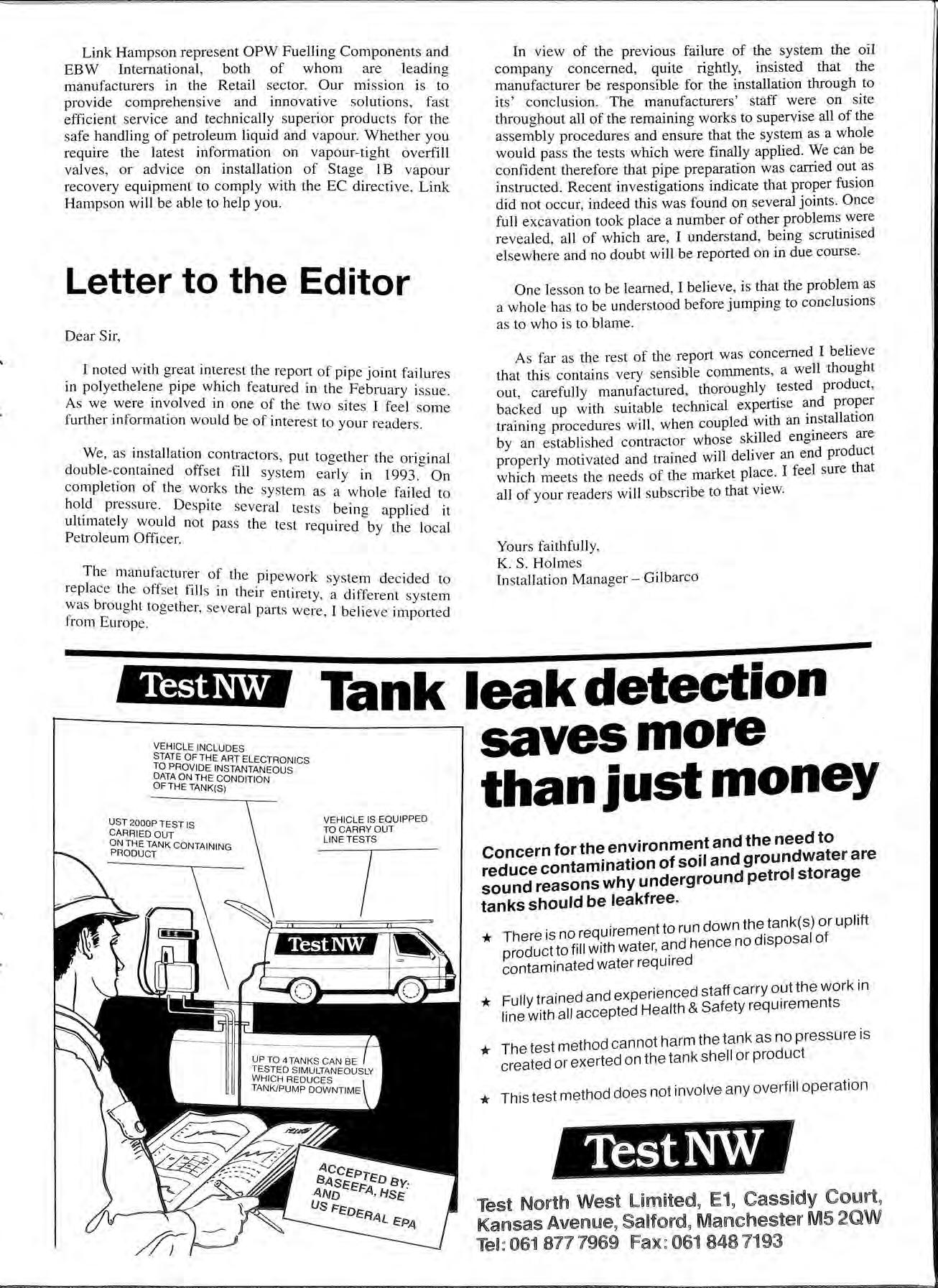
TestNW VEHICLE INCLUDES STATE OF THE ART ELECTRONICS TO PROVIDE INSTANTANEOU S DATA ON THE CONDITION Tank leak detection saves more OF THE TANK(S) UST 2000P TEST IS CARRIED OUT ON THE TANK CONTAINING PRODUCT VEHI CLE IS EQUIPPED TO CARRY OUT LINE TESTS than just money concern a re underground petrol storage tanks should be leakfree. equirement to run down the tank(s) or uplift * There 1s nor h disposal of product to fill with water, a_nd ence no contaminated water required nd ex erienced staff carry out the work in * Health & Safety requirements * The test method cannot harm the tank as no pressure is created or exerted on the tank shell or product * This test method does not involve any o ve rfill operation TestNW Test Nort h West U mited, E1, Cass idy Courrti Ka n sas Ave ntU e 9 Man(C h esteir M5 2QW 061 8771969 Fax: 8481193
THE NEED FOR LICENSING
By. Bryan Catcheside Senior Petroleum Inspector London Fire Brigade
This burgeoning organization, the APEA, includes in its membership practitioners whose skills we, as petroleum inspectors, have come to admire and respect over the years.
• There is the architect who ingeniously squeezes the proverbial quart into the pint pot.
• The manufacturer and his design team whose innovation continues to advance the science of storage and handling of a very dangerous material.
• The installation contractor who lays a veritable "Clapham Junction" of pipework with remarkable accuracy and precision.
• And the oil company engineer who unenviably walks that perilous tightrope between the requirements of the licensing authority on the one hand, and the dictates of his marketing overlords on the other.
So where does the humble petroleum inspector fit into this scenario? Perhaps it is sometimes overlooked that this much maligned individual who, in some quarters present company excepted of course! might be regarded as a great deal lower than the angels, and just a little higher than a traffic warden, in fact represents the interests of our absent guest, all important member of the public. Licensing are the arbiters of public safety representing the interests of that two thirds of the adult population who a ?riving licence and, by inference. use petrol 1 mg stat10ns on a regular basis. That is no mean responsibility!
of first began to have its impact on the citizens ra a century and a half ago. Up until then primitive whale, seal and fish oils were used to fuel the oil as m at that time. The introduction of petroleum oils new fuel for the more advanced type of oil sue as the D I becorn· up ex and the Ventas which were mg avallable h d 1 As the d saw t e ec me of the fatty oils as fuels. emand for pet 1 ·1 in their d . ro eum 01 increased the oil barons es1re to d ' ' their crude .1 uce as much kerosme as possible from gasoline in : mcorp_orated large proportions of heavy highly flam ebir kerosme fractions rendering the product ma le and d spec1f1cation st· angerous to store. The lack of flashpoint res. notably a prescribed minimum I , . u te Ill ma oss of life which . . ny serious f1res and a widespread campaigned was documented in a national press which C vigorously f 1862 · control. senes of A ·t. saw. the mtroduction of the first of a . . c s controllmg pet. 1 . h . . . m1111mum fl· ·h 10 eum wn m1tially a as pomt of 730F b . '. , London·s first p t 1 emg prescn bed and · e ro eum Inspectorate came into being.
Now there is 'l t· · b 1 replace the. '..' c.e1 am ocy ol_op1111011 which seeks to Ii h cun cnt and long stand mg system of petroleum censmo y IO'"ll tl I e '"'' dU 1ont1es Wit 1 self-regulation ·md I pr orose t< 1 t I · · ' .• ·. > pu o l 11s meeting today the proposition that the ' .ise l<>r self · I · · · · · -regu at1<m 1s tlawed and that the current
system of licensing, though requmng overhaul, best represents the interests of the public and the industry alike.
Perhaps there are those who, as a result of technical advances and innovation, have become complacent about the dangers attached to petroleum spirit and thus interpret "prevention" in its other meaning, that is, "hindrance". It may, therefore, be as well to remind ourselves precisely what sort of "animal" we are dealing with and that petroleum spirit:
• Gives off flammable vapour at very low temperatures
• That the vapour is explosive at concentrations of 2-8% in air, which means that 1h pint of petrol in a drainage system may produce an explosive atmosphere for anything up to, and beyond, a mile.
• Is a pollutant.
• Is carcinogenic .
• Is anaesthetic.
• Has a high calorific value, burning with intense radiant heat.
The proponents for self-regulation argue that licensing is outmoded for the following reasons:-
I. That the present form of licensing under the Petroleum (Consolidation) Act produces inconsistency of approach from authority to authority.
2. That onerous and often unnecessary licence conditions are applied to premises which are subject to licensing.
3. That the concept of risk assessment relegates Petroleum Act approval of sites to the status of an unnecessary formality.
4. That the licensing of premises for the storage of petroleum places an undue burden of cost upon the industry.
5. That the petroleum industry is capable_ of _regulating itself in keeping with statutory safety gu1dehnes.
Well, Jet us take a closer look at those points upon which their argument is based.
Any progressive Licensing Authority would readily acknowledge that the Petroleum (Consolidation) 1928 and its associated regulations require a major overhaul and that this has been the case for some considerable t1111e · There has been inconsistency of approach in the policies _of various authorities and up and down the country with regard to hoth technical matters and the application of licence conditions hut. in the main. this has heen as a result
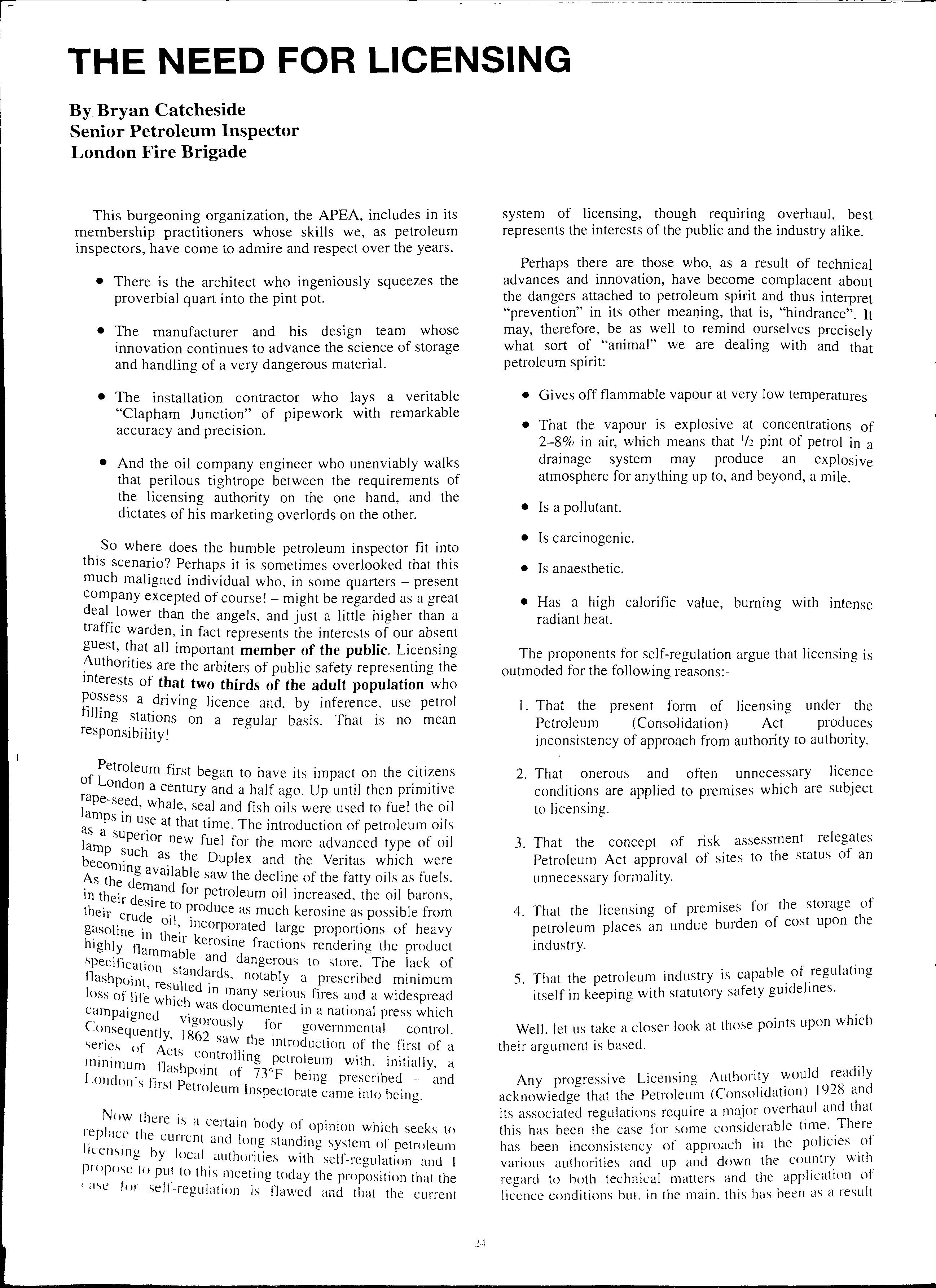
of the law itself which delegates to each licensing authority the responsibility to implement such requirements and conditions as it deems fit to ensure the safe keeping of petroleum spirit in its own specific area.
Since 1928 the growth of the industry, the advance of technology and marketing requirements and the nationwide mobility of contractors has rendered the Petroleum Act a vehicle for confusion and inconsistency and one has every sympathy with those who are critical of this aspect of the licensing system. Dinosaurs resistant to change, when clearly reform of the legislation is imperative, deserve the obscurity of extinction. However, there is clearly now an opportunity to combine the experience and advice of all disciplines associated with the industry to formulate more realistic and practical legislation reflecting modern day requirements but not at the expense of delegating the maintenance of standards of public safety to those who are directly influenced by market forces.
With regard to risk assessment I see its introduction as a welcome, important and progressive adjunct to a revised and upd?ted licensing procedure. Reflecting the identity and reqmrements relevant to specific licensed premises and licensing, together with an efficient and readily accessible appeals procedure, an even more effective means of risk management.
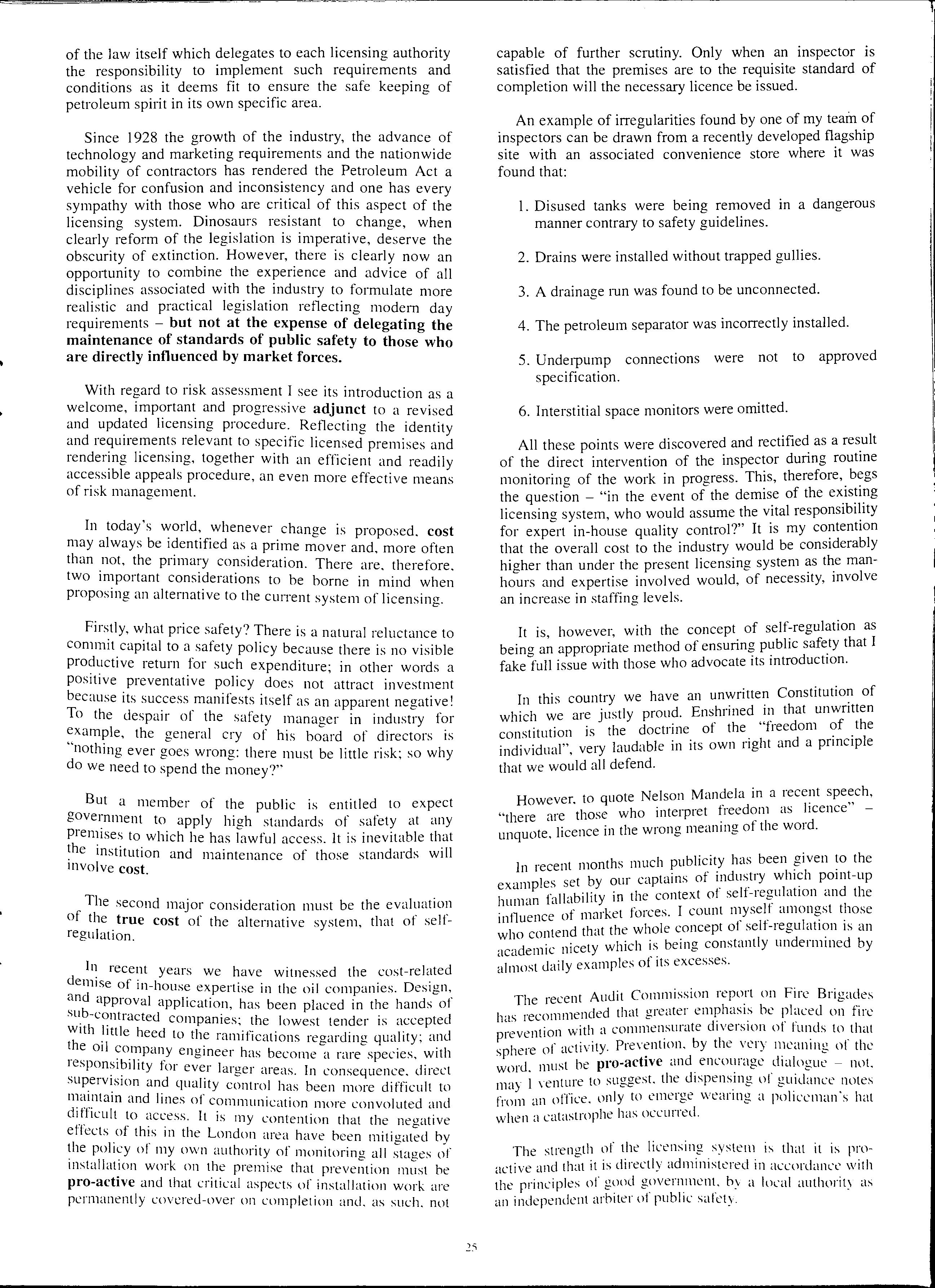
In today's whenever change is proposed, cost may always be 1dent1fied as a prime mover and, more often than not, the primary consideration. There are therefore two important considerations to be borne in proposing an alternative to the cuITent system of licensing.
Firstly, what price safety? There is a natural reluctance to commit capital to a safety policy because there is no visible productive return for such expenditure; in other words a positive preventative policy does not attract investment because its success manifests itself as an apparent negative! To the despair of the safety manager in industry for example, the general cry of his board of directors is "nothing ever goes wrong: there must be little risk; so why do we need to spend the money?"
But a member of the public is entitled to expect gove1:nment to apply high standards of safety at any premises to which he has lawful access. It is inevitable that institution and maintenance of those standards will mvolve cost.
The second major consideration must be the evaluation of the true cost of the alternative system, that of selfregulation.
In recent years we have witnessed the cost-related demise of in-house expertise in the oil companies. Design, and approval application, has been placed in the hands of companies; the lowest tender is accepted With _Imle heed to the ramifications regarding quality; and 0 11 engineer has become a rare species, with for ever larger areas. In consequence, direct sup.erv1s1on and quality control has been more difficult to mai t · · d 1· · n am an mes of communication more convoluted and to It is my contention that the negative ellects _of 111 the London area have been mitigated by of my own authority of monitoring all stages of 111stallat1on work on the premise that prevention must be pro-active and that critical aspects of installation work are permanently covered-over on completion and. as such. not
capable of further scrutiny. Only when an inspector is satisfied that the premises are to the requisite standard of completion will the necessary licence be issued.
An example of irregularities found by one of my teain of inspectors can be drawn from a recently developed flagship site with an associated convenience store where it was found that:
1. Disused tanks were being removed in a dangerous manner contrary to safety guidelines.
2. Drains were installed without trapped gullies.
3. A drainage run was found to be unconnected.
4. The petroleum separator was incorrectly installed.
5. Underpump connections were not to approved specification.
6. Interstitial space monitors were omitted.
All these points were discovered and as a res_ult of the direct intervention of the inspector dunng routme monitoring of the work in progress. This, therefore,. the question "in the event of the demise of the licensing system, who would assume the vital for expert in-house quality control?" It is my that the overall cost to the industry would be considerably higher than under the present licensing system manhours and expertise involved would, of necessity, mvolve an increase in staffing levels.
It is, however, with the concept of self-regulation as being an appropriate method of safe.ty that I fake full issue with those who advocate its mtroduct10n.
In this country we have an unwritten Constitutio? of which we are justly proud. Enshrined in that unwntten constitution is the doctrine of the. "freedom the individual", very laudable in its own nght and a prmc1ple that we would all defend.
H r to quote Nelson Mandela in a recent speech, oweve. 1 ,, "there are those who interpret freedom as icence unquote, licence in the wrong meaning of the word.
In recent months much has been1 ?ihven the I et by our captains of rndustry w 11c pomt-up examp es s · , , · d h I f II bi'J"ity 1 ·n the context ol self-1egulat10n an t e mman a a · tl f market forces. I count mysell amongst those 111 uence o It' 1 who contend that the whole of se -regu at1?n 1s an d · 111·cety which is bemg constantly undermmed by aca em1c · almost daily examples of its excesses.
The recent Audit Commission repo.rt on Fire Brigades I .. i·ecommended that greater emphasis be placed on fire ldS d" revention with a commensurate 1vers1on ot lunds to that of activity. by the very of the ·d must be pro-active and encourage dialogue not. WOI • d' may I yenture to suggest. the 1spens.mg or guidance notes from an office. only to emerge wearing a policeman's hat when a catastrophe has occurred.
The strength of the licensing system is that it is proactive and that it is directly administered in accmdance with the principles of good government. by a lucal authority as an independent arbiter or public safety.
As distinct from the concept of self-regulation the petroleum licence is an aide-memoir for the safe keeping of petroleum, enforceable at law. It can be tailored to reflect the conditions applicable to particular premises and updated to include alterations and modifications to the premises when they are completed to a prescribed standard.
It ensures that the premises are individually scrutinized and provides the medium for rapid feed-back and coordinated action in the event of:-
• suspected loss of stock.
• leakage.
• failure of items of equipment.

• problems associated with delivery and the associated conveyance regulations.
• complaints from members of the public.
In addition to the pro-active policy of close monitoring, the licence creates and maintains a continuing and all important dialogue regarding safety at the site for which it
is issued. Such dialogue may involve the licen see, contractors, architects and oil company engineers. Dialogue with the licensee occurs at least once annually through the medium of the annual inspection, and transfer of the licence enables the new licensee to have an instant overview of the requirements specific to his new premises.
Dialogue promotes on-going co-operation between the licensee and the licensing authority through the medium of the petroleum officer to maintain high , uniform standards of safety in the area concerned. (Appropriate revisions of legislation, previously mentioned, will ensure that uniformity is applied nationwide.)
In conclusion , I submit that the strengths of an updated licensing system would provide the necessary focus to optimize public safety, rather than the alternative selfmanagement system which would prove to be as expensive in application as it would be vague as a means of control.
' . ! - '.
I •
A NEW PIPING CONCEPT BECOMES REALITY
by John Munday
In recent years, around the world, service station owners and operators have become incre as ingly concerned about the piping and tanks beneath the ground at their premi ses. There are, of course, excellent reasons for this interest.
People of the world, as well as environmental agencies have ga ined increasing insight into .the problems of so il contamination and its effects. Peoples and governments need to work together to protec t the environment from contamination.
Smith Fiberglass Products Inc. , from the U.S.A. , h as served the service station indu stry for more than 25 years. The Company has recently introduced a new concept in flexible dual-wall underground piping; the new design addresses problems faced by the owner/operator and help s fulfil gove rnmental requirements.
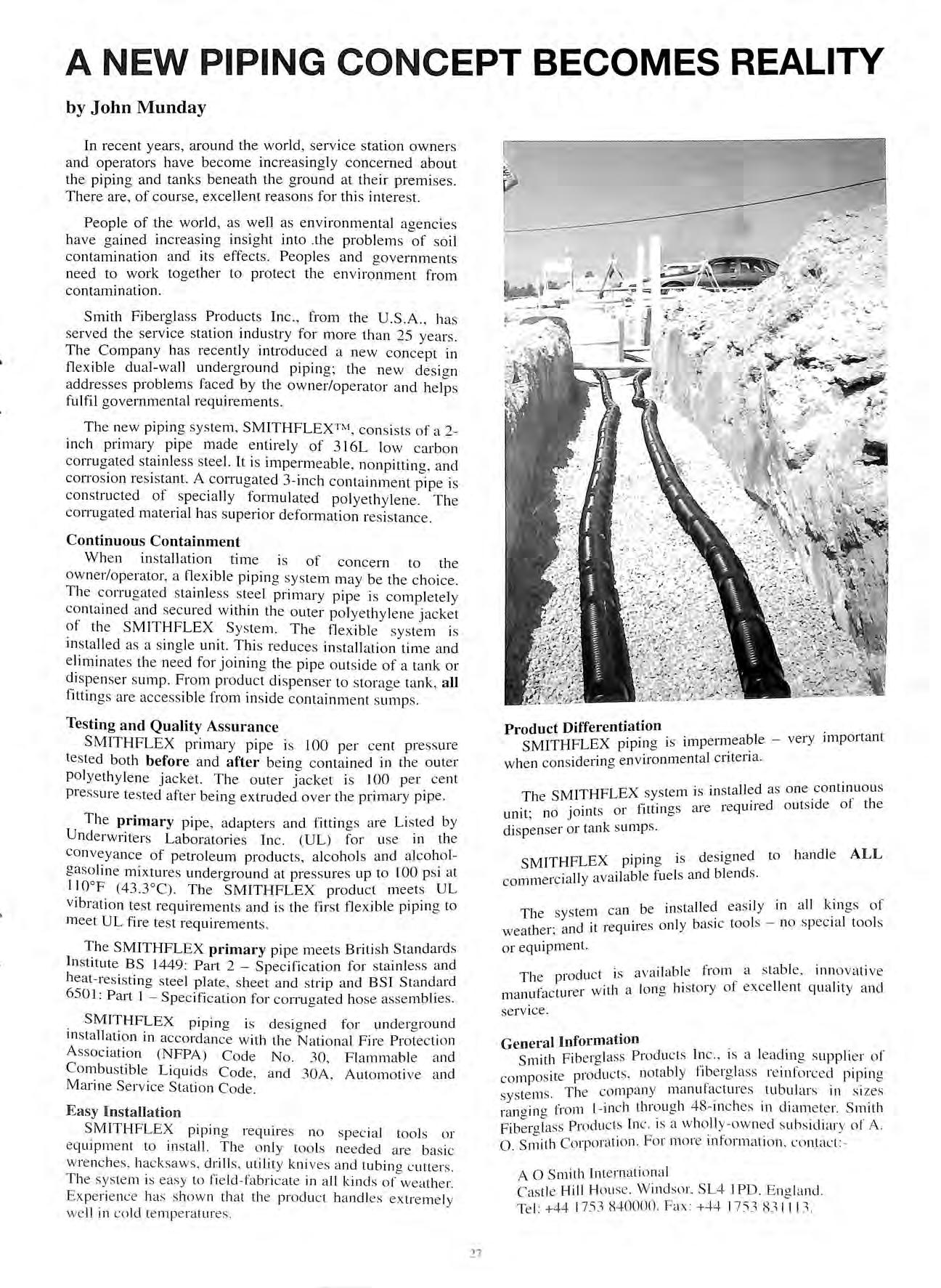
The new piping system, SMITHFLEXn1 consists of a 2inch primary pipe made entirely of 3 I 6L low carbon corrugated stainless steel. It is impermeable , nonpitting , and corrosion res istant. A corrugated 3-inch containment pipe is constructed of specially formulated polyethylene. The coITugated material has superior deformation resistance.
Continuous Containment
Wh en installation time is of concern to the owner/operator, a flexible piping sys te m may be the cho ice. Th e co rru ga ted stainless stee l primary pipe is completely contained a nd sec ured within the outer polyethylene jacket of the SMITHFLEX System. The flexible system is 111 stalled as a si ngle unit. Thi s reduces in sta llation time and eliminates the need for joinin g the pipe outside of a tank or dispenser sump. From produ c t dispenser to s torage tank, all fittings are accessible from in s ide containment sump s.
Testing and Quality Assurance
SMITHFLEX primary pipe is I 00 per cent pres sure te sted both before and after being co ntained in the outer polyethylene jacket. The o uter jacke t is I 00 per cent press ure te sted after bein g extruded over the primary pipe.
The primary pipe , adapters and fittings are Li s ted by Underwriters Laboratorie s Inc (UL) for use in th e co nveya nce of petrol e um products, alcohols and alcoholgasoline mixture s underaround at pressures up to I 00 ps i at 110°F (43.3°C). The SMITH FLEX product meet s UL vibration te st requirements and is the first flexible pipin g to meet UL fire test requirement s .
The SMITHFLEX primary pipe meets British Standards In st itute BS 1449: Part 2 Specification for stainl ess and heat- res istin g steel plate , s heet and strip a nd BSI Standard 6501: Part I Specification for corrugated ho se assemblies.
SMTTHFLEX pipin o is desioned for under <>ro und b b b 111 stallation in accorda nce with the National Fire Protec ti o n Association (N FPA) Code No. 30, Flammable a nd Comb ust ibl e Liquids Code, and 30A, Automotive a nd Marine Service Station Code Easy
Installation
SMITHFLEX pipin g req uires no spec ial tools o r eq uipm ent to install. The o nl y tool s needed a re ba s ic wrenc hes , hacksaws. drills utility kniv es and tubing c utters. T he sys te m is easy to fi e ld -fabricate in a ll kind s of weat he r Ex pe ri e nce has s hown that the produ c t ha ndl es ext re me ly we ll in co ld temperatures.
Product Differentiation
SMITHFLEX piping is very importa nt when con sidering environmental cntena.
The SMITHFLEX system is in stalled as one ·01·11ts or fittin<>s a.re required o uts id e ot the umt ; no J o di spenser or tank sumps.
SMITHFLEX piping is de sig ned to ha ndl e ALL commercially available fu e ls and bl e nd s.
TI t 1 ca n be in stalled easily in all kings of 1e sys en ' , , 1 h d ·t 1·equires only basic tool s no spec 1<1 tools weat e1 , an 1 or equipment.
The product is ava ilabl e from a stab le, inn ovat iv e ·t11 a lon 0 a hi story of excelle nt quality and manufacture r w1 · serv ic e.
General Information
.
Smith Fiberglass Products is a lead 111 g s uppli e r o l composite produ cts. notably t1berglass reinforc ed piping ste ms. The company manufactures tubulars in s izes sy · 48 1 ranaina from L 111 c h through me 1es 111 diamete r. S mith Products Inc. is a wholl y-o wned s ub s idi a ry of A. o. Corporation For more information. contac t :
A o Sm ith [n ternationa l Castle Hill Hou se. Windsor. SL4 I PD. E ngland Te l: +44 17'53 840000. Fax +44 1753 83 111 3.
27
OVERFILL PREVENTION
By Peter Edgington
I have read with some interest the correspondence generated between various manufacturers following the article on Overfill Prevention Devices published in issue 3 Volume 32 of the APEA Bulletin. Having noted some of the statements made I could not let them pass without adding a further view point and correcting some misconceptions. My own views are based on using such equipment in operational service and are the result of assessing, testing and recommending such equipment for a major oil company over a 25 year period worldwide. During this time I have examined systems operating on a variety of principles including mechanical, hydraulic, pneumatic, electrical and hybrids of them for installation in both above and below ground tanks and road tankers. In all cases the methods of operation are similar. Rising fuel level is detected in a tank or compartment by a sensing device which relays a signal to a shutdown valve. The valve may form either an integral part of the sensing unit or be located remotely from it.
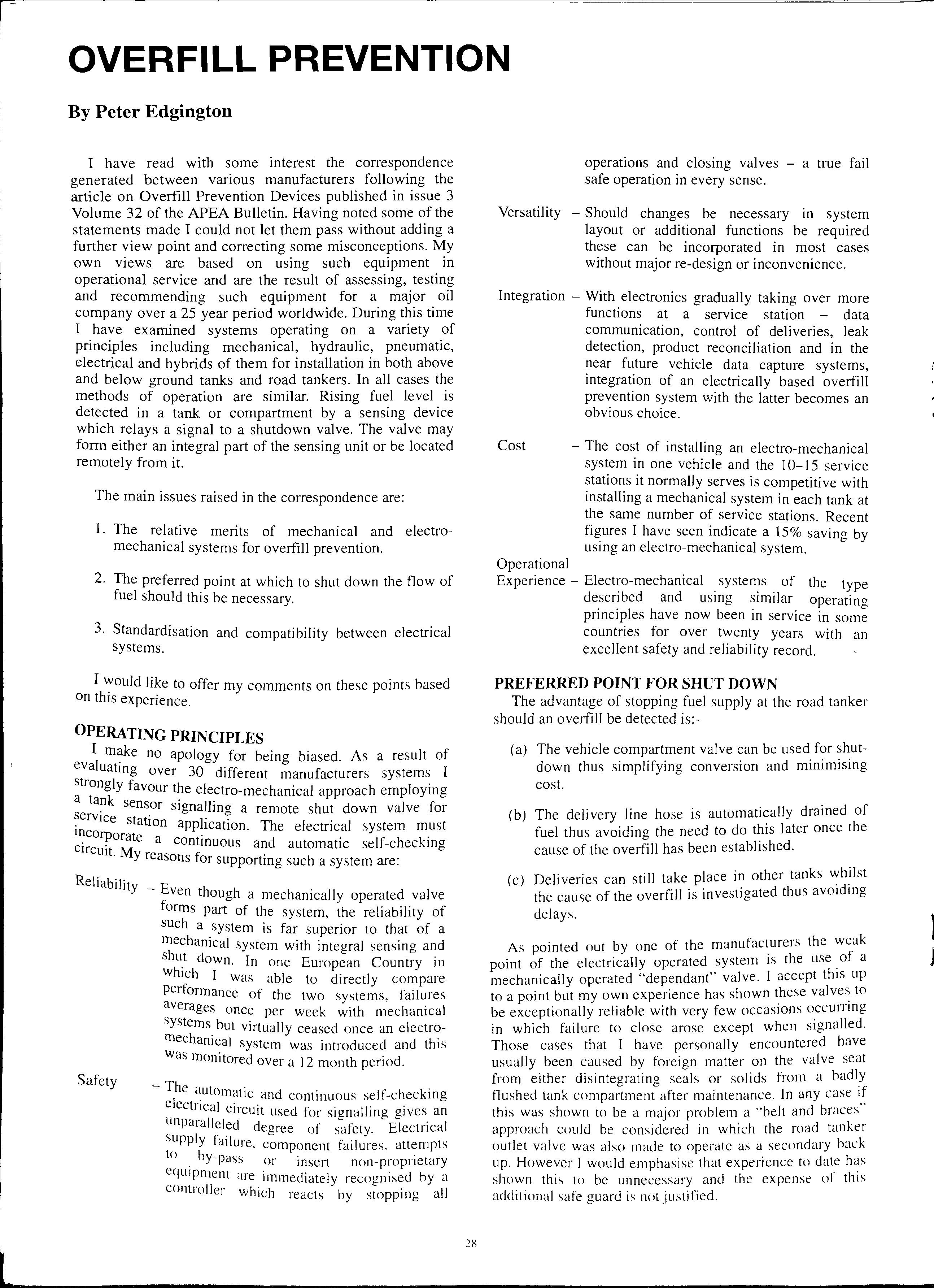
The main issues raised in the correspondence are:
1. The relative merits of mechanical and electromechanical systems for overfill prevention.
2. The preferred point at which to shut down the flow of fuel should this be necessary.
3. Standardisation and compatibility between electrical systems.
I "."ould like to offer my comments on these points based on this experience.
OPERATING PRINCIPLES
I make no apology for being biased. As a result of eval · uatmg over 30 different manufacturers systems I strongly favour the electro-mechanical approach employing a sensor signalling a remote shut down valve for station application. The electrical system must a continuous and automatic self-checking Ircuit My " . · reasons ior supporting such a system are:
operations and closing valves -a true fail safe operation in every sense.
Versatility Should changes be necessary in system layout or additional functions be required these can be incorporated in most cases without major re-design or inconvenience.
Integration With electronics gradually taking over more functions at a service station data communication, control of deliveries, leak detection, product reconciliation and in the near future vehicle data capture systems, integration of an electrically based overfill prevention system with the latter becomes an obvious choice.
Cost The cost of installing an electro-mechanical system in one vehicle and the I0-15 service stations it normally serves is competitive with installing a mechanical system in each tank at the same number of service stations. Recent figures I have seen indicate a 15% savincr by using an electro-mechanical system. 0
Operational Experience
Electro-mechanical systems of the type described and using similar operating principles have now been in service in some countries for over twenty years with an excellent safety and reliability record.
PREFERRED POINT FOR SHUT DOWN
The advantage of stopping fuel supply at the road tanker should an overfill be detected is:-
(a) The vehicle compartment valve can be used for shutdown thus simplifying conversion and minimising cost.
(b) (c)
The delivery line hose is automatically drained of fuel thus avoiding the need to do this later once the cause of the overfill has been established.
forms part of the system, the reliability of such a system is far superior to that of a mechanical system with integral sensing and shu.t down. In one European Country in which I was able to directly compare performance of the two systems, failures averages once per week with mechanical systems but virtually ceased once an electromechanical system was introduced and this wasm · · onitored over a 12 month period.
Reliability E ven though a mechanically operated valve Safety
The and continuous self-checking electrical circuit used for signalling gives an unparalleled degree of safety. Electrical supply failure. component failures. attempts to by-pass or insert non-proprietary equipment are immediately recognised hy a controller which reacts hy stopping all
Deliveries can still take place in other tanks the cause of the overfill is investigated thus avmdmg delays.
As pointed out by one of the the weak point of the electrically operated system 1s the use of a mechanically operated "dependant" valve. I accept this up to a point but my own experience has shown t_hese to be exceptionally reliable with very few occas10ns o_ccurrmg in which failure to close arose except when signalled. Those cases that I have personally encountered have usually been caused by foreign matter on the valve seat from either disintegrating seals or solids from a badl_y_ flushed tank compartment after maintenance. In any case If this was shown to be a major problem a "belt and braces" approach could be considered in which the road tanker outlet valve was also made to operate as a secondary hack up. However I would emphasise that experience to date has shown this to be unnecessary and the expense of this additional safe guard is not justified.
28
A further point in support of using the compartment bottom valve for shut down is that on an average working day the valve would be operated for up to 2--4 loadings and as many off loadings. Compare this with the same incidence of use for an integrated mechanical valve in an underground tank which may only be required to operate should an overfill situation arise. It is this comparative lack of use which causes many of the operating problems with integrated mechanical valves.
STANDARDISATION AND SYSTEM COMPATIBILITY
The lack of standardisation and compatibility between electrical systems offered by different suppliers is of concern and a valid criticism but in practice it has been overcome because of the attractiveness of the electromechanical system and the advantages it offers.
To achieve cross compatibility between systems it is necessary for government agencies/petroleum industry or similar_ to issue a standard specification which all suppliers in a given country should meet. To date this has been impossible to achieve as equipment has come on to the market before the authorities have had time to react and produce such requirements. Once equipment is in use it is then too late to obtain acceptance of a standard specification as no manufacturer is neither prepared to back track or modify equipment in order to comply nor is he prepared to release proprietary information such as methods of electrical signalling which must be disclosed. In practice the problem has been solved by those oil companies who wish to ad?pt an system specifying their own reqmrements which have to be met by all those contracted to supply product to them.
However attempts are now being made in Europe to produce a common standard covering overfill prevention systems for use at service stations when offloadincr from road tankers, this is known as CEN 221. Yariousc- study groups have been formed to draft requirements for different applications and the U.K. are well represented on these groups.
I would now like to comment on specific points raised by the two mechanical equipment manufacturers which I find difficult to accept.
OPW claim that mechanical equipment has a low incidence of reported failure. This is not my experience, but perhaps the key word is "reported". Not all incidents are reported for obvious reasons as no driver will willingly do this as it reflects adversely on his competence to do his job. Invariably only major incidents get reported i.e. those involving a large fuel spillage or where the incident is witnessed by other parties. I am also surprised that the failures when diagnosed were invariably due to incompetent or incorrect installation. I find this statement extraordinary. Again my experience shows that poor installation only represents a small percentage of the total failure rate. What about failures in service caused by sticking/jamming of moving parts due to solids contamination, gum deposits from fuel, corrosion, floats losing buoyancy and ice built up in winter. On several occasions I have encountered problems at service station rebuilds in which a new mechanical device had to be replaced several times before an acceptable one was found so there could also be a quality control problem with some manufacturers.
The major criticism I have with mechanical systems is that when you connect up to off load a vehicle you never know with confidence whether the overfill device will operate when required to do so in an emergency. Some companies have attempted to introduce procedures which require a daily check of mechanical equipment by physically making sure that floats and moving parts_ etc are free to operate. However you can imagine the reception that such a procedure receives from fore-court personnel and the willingness to do this soon lapses once the problem of accessibility to do this have to be faced.
From the remarks made by Emco-Wheaton on the ability to bypass the electronic circuit in systems using dummies it is apparent that of the automatic and continuous self-checking electncal circuit is not fully understood. With such a system any attempt to by-pass, change with unacceptable or insert a dummy would result in the electncal signature being transmitted back to the on the road tanker. This would result m a non-permissive signal being given and the off-loading would immediately stop and could not proceed until the cause of the in-correct signal had been fully diagnosed fault corrected. I know that on occasions special been supplied by some manufacturers to enable to proceed from road tankers which are not yet eqmppe with the electrical-mechanical systell!· In these additional safeguards are incorporated in the _electnhca . d "d t'fi s these vehicles t us circuit which recogmses an 1 en 1 ie enablincr them to deliver product. b
Finally I find it ironic that the two m_echanical . . I b t lectromc systems w IC suppliers are so cnuca a ou e ., 1 . h d tanker to stop i ue operate a mechanical valve m t e roa facturer markets delivery flow as I one ove1fill their own items of eqmpment for are the major prevention systems and between t Iem eyldwide Do the . d k bottom va ves wor · suppliers of roa er , f confidence in these and criticisms therefore imply. lack 0 .,... knowledcre the . f qmpment? io my ctheir own 0 e nts one of the most reliable bottom valve_s m and have an excellent record components m a road tan Id ·de I would have thought vice wor WI • over many years ser ther than criticise those nufacturers ra that the two ma h . 1 should be prmsmg rather companies which use sue va ves than condemning them.

29
LEAK INVESTIGATION AND COST EFFECTIVE REMEDIATION
Eur Ing John Waters Groundwater Technology International Ltd Epsom, United Kingdom
1.0 INTRODUCTION
The operation of petroleum retailing sites with underground storage tanks, pipelines, dispensing pumps, vents, drainage and oil/water separators is potentially hazardous. The hazards give rise to occupational, safety and environmental risks which may have significant economic consequences and may directly impact the oil company's profitability.
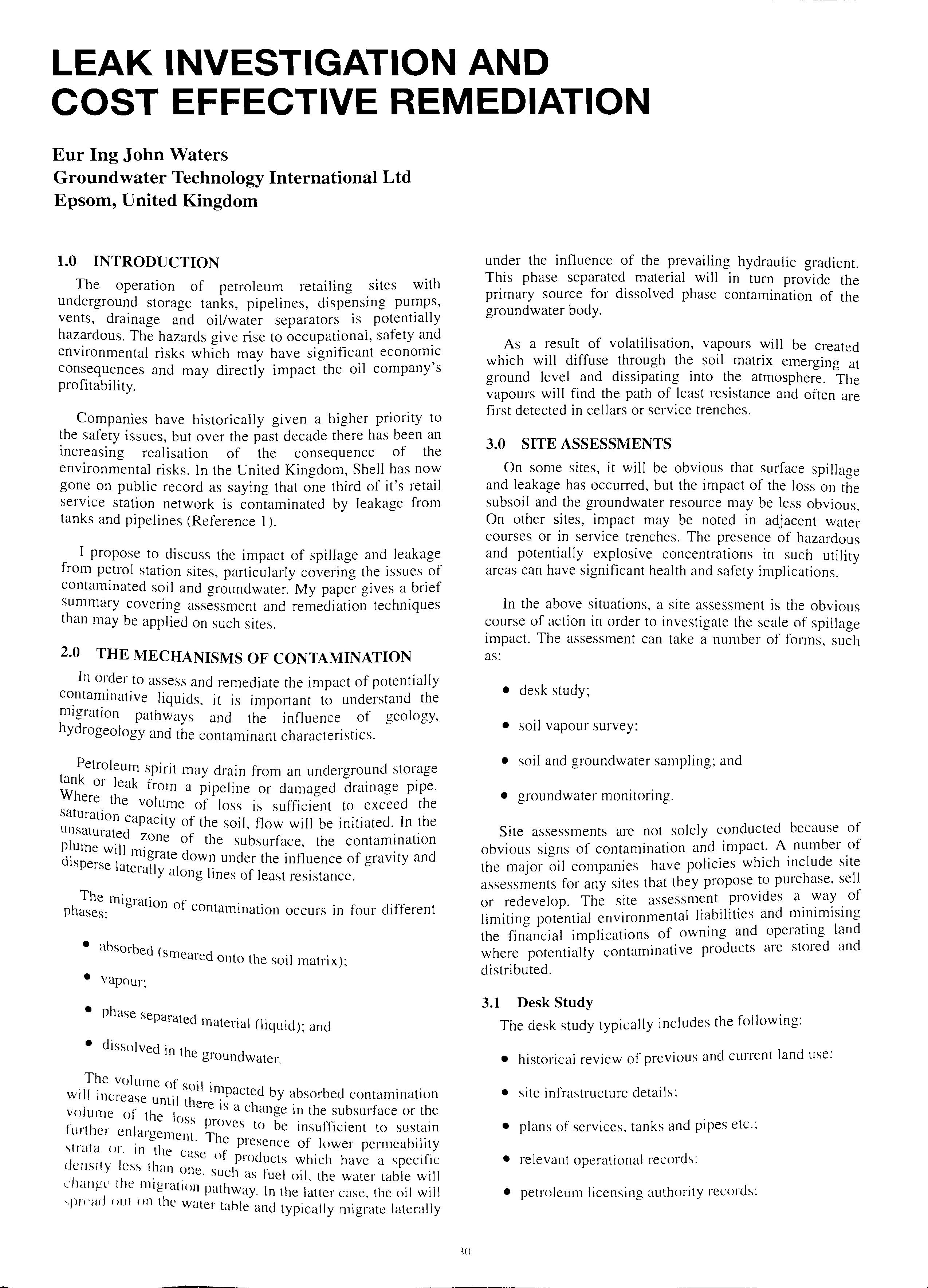
Companies have historically given a higher priority to the safety issues, but over the past decade there has been an increasing realisation of the consequence of the environmental risks. In the United Kingdom, Shell has now gone on public record as saying that one third of it's retail service station network is contaminated by leakage from tanks and pipelines (Reference 1).
I propose to discuss the impact of spillage and leakage from petrol station sites, particularly covering the issues of contaminated soil and groundwater. My paper gives a brief summary covering assessment and remediation techniques than may be applied on such sites.
2.0 THE MECHANISMS OF CONTAMINATION
In order to assess and remediate the impact of potentially liquids, it is important to understand the migrat10n pathways and the influence of geology, hydrogeology and the contaminant characteristics.
Petroleum spirit may drain from an underground storage or leak from a pipeline or damaged drainage pipe. ere. the volume of loss is sufficient to exceed the capacity of the soil flow will be initiated. In the zone of the subsurface the contamination me will mig t d . d disper 1. ra e own under the mfluence of gravity an se aterally along lines of least resistance.
The migratio f . . phases: n ° contammat1on occurs in four different
• absorbed (s · meaied onto the soil matrix);
• vapour;
• phase separat d . e matenal Oiquid); and
• dissolved in the g1 oundwater.
The volume ors 1 will increase unrt · 1n:1Pacted by absorbed contamination volume of the 1 1 t ere is a change in the subsu1t'ace or the oss proves t b . 1·f· further enlarge · o e msu · 1c1ent lo sustam ment. The P . f slrala or. in the ea, resence o . tower I , " 1,. se of products which have a spec1f1c 1 enslly ess than one s 1 r· . . · · uc 1 as uel oil the water table will cha11°e !he m1grat1on . tl . ' . . "' P<1 iway. In the latter case. the ml will out on the W'tle · t· bi d . . · ' ' <1. e an typically migrate laterally
under the influence of the prevailing hydraulic gradient. This phase separated material will in tum provide the primary source for dissolved phase contamination of the groundwater body.
As a result of volatilisation, vapours will be created which will diffuse through the soil matrix emerging at ground level and dissipating into the atmosphere. The vapours will find the path of least resistance and often are first detected in cellars or service trenches.
3.0 SITE ASSESSMENTS
On some sites, it will be obvious that surface spillage and leakage has occurred, but the impact of the loss on the subsoil and the groundwater resource may be less obvious. On other sites, impact may be noted in adjacent water courses or in service trenches. The presence of hazardous and potentially explosive concentrations in such utility areas can have significant health and safety implications.
In the above situations, a site assessment is the obvious course of action in order to investigate the scale of spillage impact. The assessment can take a number of forms, such as:
• desk study;
• soil vapour survey;
• soil and groundwater sampling; and
• groundwater monitoring.
Site assessments are not solely conducted because of obvious signs of contamination and A. number .of the major oil companies have policies which mclude site assessments for any sites that they propose purchase, sell or redevelop. The site assessment provides a. of limiting potential environmental and m1?1m1smg the financial implications of ownmg and operatmg land where potentially contaminative products are stored and distributed.
3.1 Desk Study
The desk study typically includes the following:
• historical review of previous and current land use:
• site infrastructure details;
• plans of services. tanks and pipes etc.:
• relevant operational records:
• petroleum licensing authority records:
\()
• anecdotal information from site operatives;
• geology;
• hydrogeology;
• local abstraction boreholes;
• aquifer type; and
• site reconnaissance.
The desk study should recommend whether future site assessment will be required and what scope of work are likely to be most appropriate.
3.2 Soil Vapour Survey
. A .soil. survey !s a screening tool for the mvest.1gat1on of sites potentially contaminated by volatile orgamc compounds (VOCs) or semi-volatile oroa · d T · II · to me co.mpoun s. yp1ca a gnd of small diameter holes are dnlled the site surface to a depth of around 1m. Representative samples of the vapour held withi th ·i · I d · n e soi matnx are ana yse usmg a photo=ionisation detector (PIO) or a gas chromatograph (GC). The so1'l \'apoLt · · r su1 vey 1s a app1f·oahch and the results can be mapped to oive an m 1cat1on o t e areal extent of 1 cont·1111 · , t' 1 to • • • • < < ma ion p ume. 1:he. causes httle site disturbance yet allows a s1gmf1cant number of sampling Jocat1 · . t b ff I . . . ons o e cost e ect1ve y mvest1gated ma one day survey.
3.3 Soil and Groundwater Sampling
The collection and analysis of represe t· t. 1 · n a 1ve soi and groundwater samples 1s an esse 11 t1·al ·t 'f' · f h · s ep to the quantt 1cat1on o t e impact of spillage or J k TI ·i , · ea age. le soi s<1mples can be collected directly fr<)m tl t·· , d · · 1 · le sur <1ce or at epth Jrom tna pits and boreholes.
Where groundwater is encountered the t)). h l b <1e o es can e converted to momtonng wells with the s ·i·ee d . c n size an pack chosen be compatible with the adjacent subsml. In the cas.e of .fuel oil which has migrated down to water table it :-VIII be necessary to investigate the thickness a?d. chemical composition of the product. The thickness of 011 recorded in the monitoring well will need to be for pore pressure effects which overestimates the thickness of fuel actually on the water table.
analysis should be designed to target on the _likely contammants from the desk study. For a luel storage site. this may include total petroleum hydrocarbons. volatile organic chemicals. such as benzene. as well as other potentially contaminative products that may have been used on the site over the years.
Quality control must he maintained in all stages of the sampling. transport, analysis and reporting Every care must he taken to ensure samples are representative. that they are preserved correctly. immediately placed in cool storage to minimise the loss of volatiles. properly labelled and logged both on site and at the laboratory. Chai;1 of custody documentation must track every stage of this process to ensure defensible results.
3.4 Groundwater Monitoring
In cases where phase separated material and/or dissolved contamination arc identified. it may be necessary to undertake a programme of groundv.•ater monitoring. The
programme may be designed to establish whether the extent of the impact on the groundwater is increasing/decreasing with time or migrating off-site.
A groundwater monitoring programme can also be employed to confirm that a remediation programme has met the cleanup targets. Such a programme may need to be designed in consultation with the appropriate environmental regulator.
It is interesting to note at this stage that monitoring programmes must take note of product developments and may need to evolve. Over the past decade there has been a significant transfer from leaded to unleaded fuels in order to minimise atmospheric pollution. As you will be aware this required the use of an alternative anti-knock agent to be added to petroleum spirit. Methyl tertiary butyl ether (MTBE) is a fuel oxygenate which has been increasingly used as unleaded fuel additive. MTBE has a low toxicity, yet it's low odour and taste threshold makes it a problem at concentration levels above 2 to 3 parts per billion in water. It is ten times more soluble than the BTEX, is apparently not retarded by sorption and is non-biodegradable. We are increasingly identifying it's presence in groundwater and are becoming concerned about the fact that it exhibits cosolubility with BTEX components. thereby increasing their mobility.
4.0 HAZARD RANKING
At any of the above stages of site assessment, a risk assessment can be undertaken to evaluate the hazards identified, the exposure pathways and the risks posed. For example. a hazard may be potentially explosive vapour concentrations, the exposure pathway may be a telecommunications duct leading to a school and the risk is impact on the health and safety of the pupils and teachers. Another hazard may be a leaking underground storage tank. the exposure pathway an adjacent water course/groundwater and the risk is polluting a d1inking water supply.
The data accumulated from the site assessment phase will then need to be reviewed in the context of the location of the site and the presence of local environmental receptors such as drinking water boreholes.
The risk assessment can be incorporated into a review of a number of sites to provide an indication of which are the potential high risk locations. F.or we are operat111g . 1 no term database for a ma.1nr ml company to produce a ,1 o II 11·s1 ·issessment pro<>ramme tor a 1t s service na 1 1 , " ' · · • eo station sites. This programme started with data on .geology and hydrogeology and now i1.1cludes all petroleum licensing authority records on the site. leaks and even proximity to underground and mamhne railways. This national risk assessment programme has provided the basis for a logical programme of subsequent site. assessments to focus the finite resources onto the potentially hazardous sites first.
Such hazard ranking programmes alst1 prnvide data for proactive programmes to built nr re1rorit sites with engineering measures to prL'Vent spillage and kakage and impal'lmg sod and groundwater. These enginec1ing measures include replaL·ing singk skin tanks a double skinned \ ersinn. plastic suL·t iun Iines to replace nlL'tal ones. check \ alues on each pump and sophistiL·a1ed tank monitoring and wet stoL·k nmtrol systems. However li"e L'nvirnnmcntal ill\L'stigation and
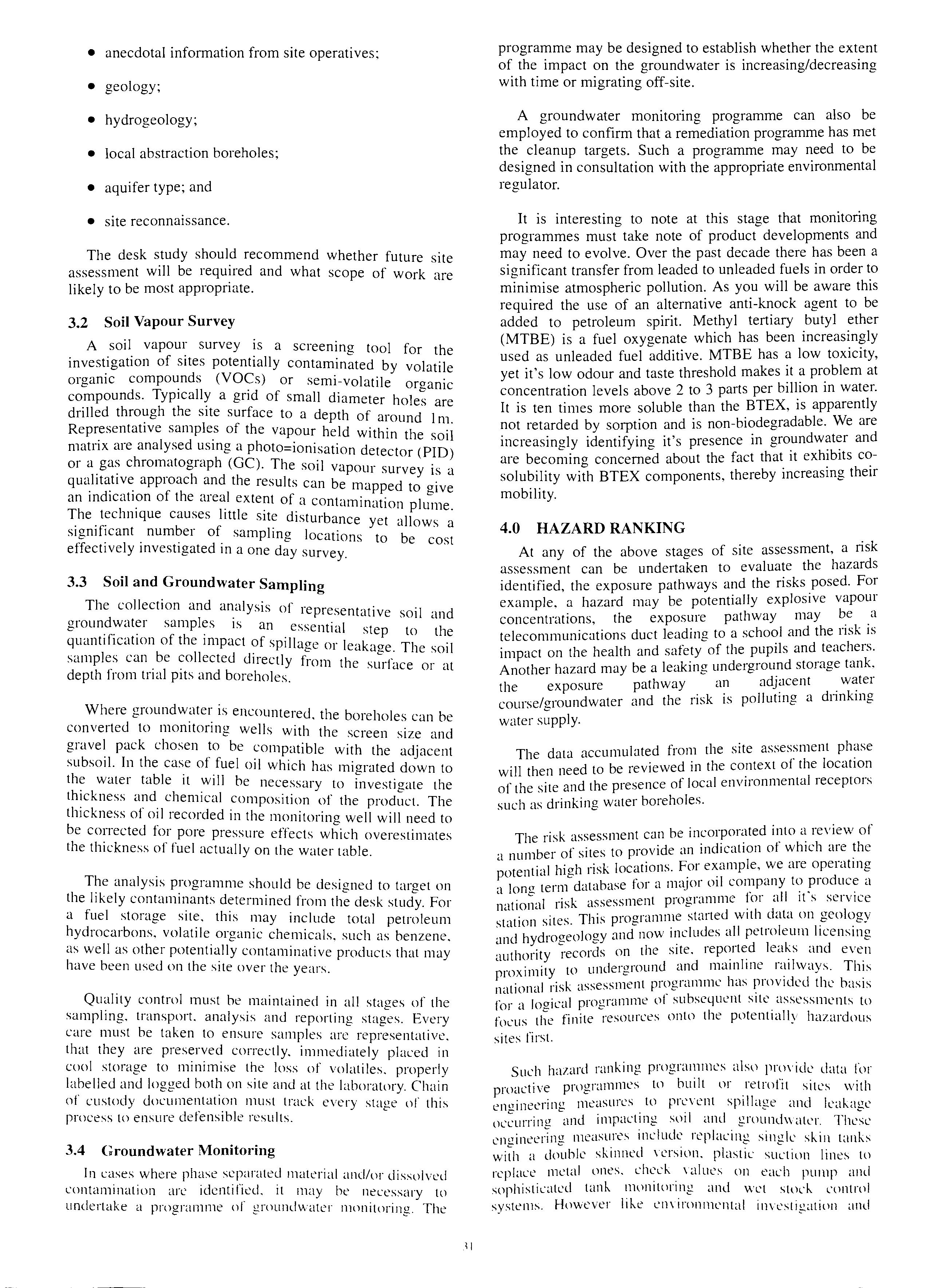
1 \
remediation, these measures are not cheap. Shell indicate that complying with new environmental and safety standards in the UK means that it now costs £92,000 more to build a site than would have been necessary ten years ago.
5.0 CLEANUP
There are a range of remediation options available to address the impact of spillage and leakage, dependant on the results of site assessment, the potential environmental liabilities and the cleanup targets.
Remediation alternatives broadly fall into two categories, namely transfer and destructive techniques. Historically the remediation of contaminated soil has been dominated by conventional transfer techniques, such as and off-site disposal. However there is an mcreasing use of more innovative remediation techniques across Europe, which reduce the contamination on site and have the benefit of not transferring environmental liabilities elsewhere and are progressively more cost effective.
5.1 Dig and Carry
The most widely used approach to address polluted soil m many parts of Europe is to excavate the impacted area and dispose of the spoil at a licensed landfill site.
The solution transfers the problem to another location containment measures should be more appropriate to hm1t the environmental impact of the waste. Landfill has progressively incorporated ever more sophisticated engineering measures to control the impact of the landfill on the surrounding environment.
h In _some European Union states. such as the Netherlands, e dig and carry technique is no longer permissible there hecause of the lack of landfill space. Another limitation is t although digging up contaminated soil may remove a pnmh_ary source of groundwater contamination, it does not mg to dd · 1 d" a ress any phase separated matena or tssolved phase groundwater contamination caused already.
5 2 Pump and Treat
wh'!'h1e pump and treat options comprise a rano-e of methods ic 1 recove b lk "' I and/ r u quant1t1es of phase separated matena shalloor control groundwater and plume flow. Typically in w o-roundw t b · I · depressed b a er_ ta le scenanos. the water table leve 1s separated the groundwater and then phase hydraulic that accumulates under the induced gra ient is re . d . system. Th . · covere using an alternative pumpmg sumps, pumping system can be commissioned in es and abstraction boreholes.
There is r . · a general · emediation 1 m1sconcept1on that pump and treat 1s a as so ut1on b t . · a containm ' u 1t should actually only be viewed arc d ent measur B iun the . b . · e. Y creating a cone of depression 111 d" a stractton I · <=: a 1ent can be ocat1on, the prevailing hydraulic limited. overcome and off-site migration can be
The reason tha recovery is du t pump and treat does not provide full ·1s e lo the retenf t' l' '· a result of . ion o 1quids in the soil matrix h poi e pressur 1·1· e lo view the 1 · · e ects. A crude analogy would soi matrix b sponge is imm .. d . as a ath sponge. When the e1se in wate· ·1 f II represents soi I heneath 1 1 . is u y saturated and '>ponge from th . . the_ water t,tble. Slowly remove the e W<1te1 which c·m b d . :md water will d.. . ' e compare to pumpmg i.1111 under grwity t 1· tl ·1 <'4t11lihnum is re·tc , . ' ou o 1e sponge unt1 W.;, .• ' hed. II y1_iu then squeeze the sponge. ''"lil'lh1n,!! .:: c 11 1 1 ' ino lo with the soil matrix. you will
release a significant amount of additional liquid. There is another complicating factor, because as we depress the water table in the presence of phase separated material this will create a smearing effect and a greater proportion of adsorbed contamination.
It is for the above reasons that pump and treat solutions have been known to proceed for many years and, where over optimistic claims for treatment were given, never achieve the remediation goals.
5.3 Bioremediation
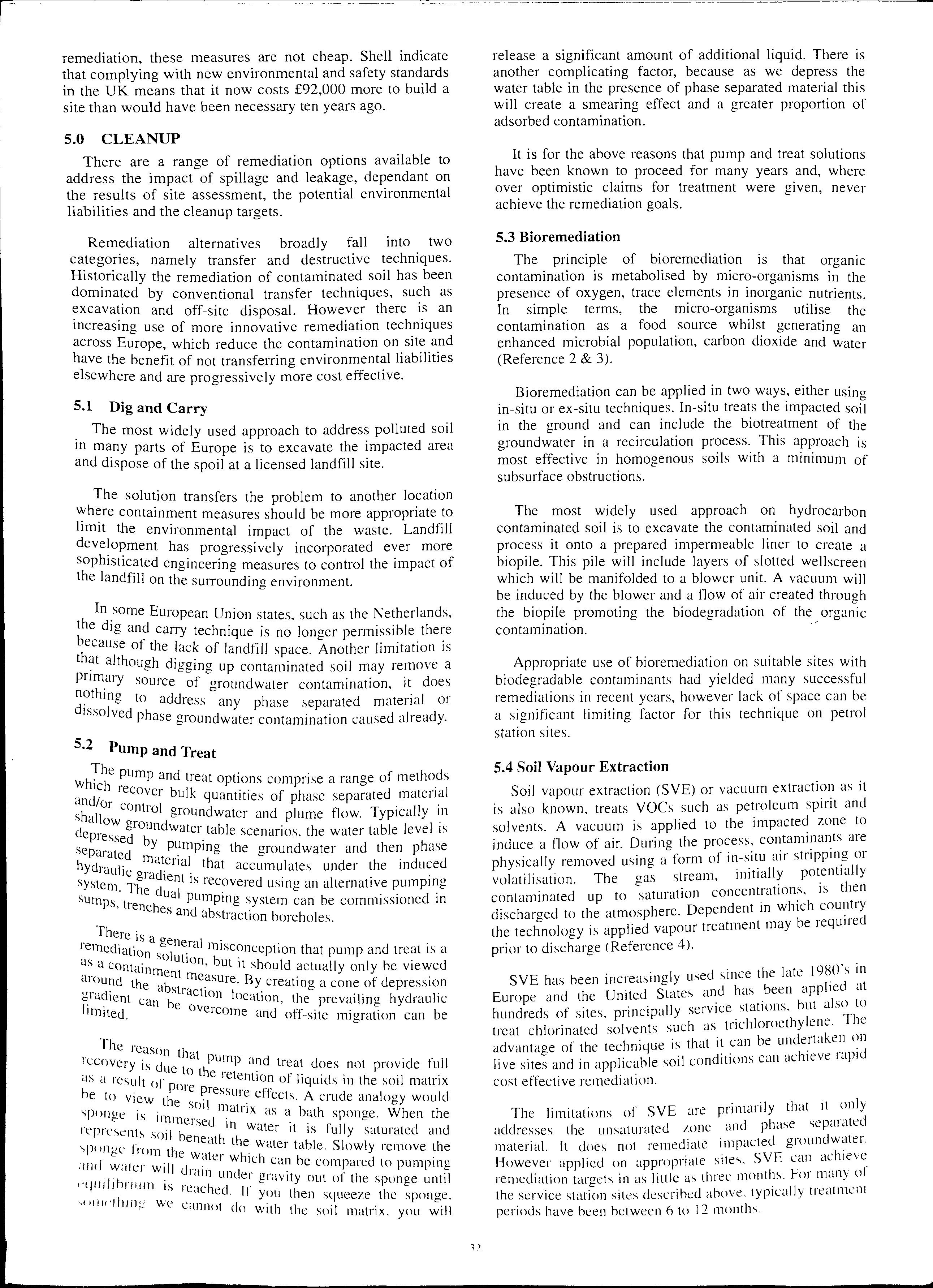
The principle of bioremediation is that organic contamination is metabolised by micro-organisms in the presence of oxygen, trace elements in inorganic nutrients. In simple terms, the micro-organisms utilise the contamination as a food source whilst generating an enhanced microbial population, carbon dioxide and water (Reference 2 & 3).
Bioremediation can be applied in two ways, either usina "' in-situ or ex-situ techniques. In-situ treats the impacted soil in the ground and can include the biotreatment of the groundwater in a recirculation process. This approach is most effective in homogenous soils with a minimum of subsurface obstructions.
The most widely used approach on hydrocarbon contaminated soil is to excavate the contaminated soil and process it onto a prepared impermeable liner to create a biopile. This pile will include layers of slotted wellscreen which will be manifolded to a blower unit. A vacuum will be induced by the blower and a flow of air created through the biopile promoting the biodegradation of the, organic contamination.
Appropriate use of bioremediation on suitable sites with biodegradable contaminants had yielded many successful remediations in recent years, however lack of space can be a significant limiting factor for this technique on petrol station sites.
5.4 Soil Vapour Extraction
Soil vapour extraction (SVE) or vacuum extraction as it is also known, treats VOCs such as petroleum spirit and solvents. A vacuum is applied to the impacted zone to induce a flow of air. During the process, are physically removed using a form of air or volatilisation. The gas stream, pot_entially contaminated up to saturation concentrat10ns. is then discharged to the atmosphere. Dependent in which the technology is applied vapour treatment may be requued prior to discharge !Reference 4).
SVE has been increasingly used since the late l in Europe and the United States has _been at hundreds of sites, principally service. stations. but also tl: treat chlorinated solvents such as tnchloroethylene. The advantage of the technique is that it can be unde_rtaken · 1 ·1 d't' l 1 · c·1n achieve rapid hve sites and m apphcab e s01 con 1 t< t s ' cost effective remediation.
The limitations of SVE are primarily that it only addresses the unsaturated zone and phase separated material. It does not rernediate impacted groundwater. However applied on appropriate sites. SVE can achieve. rernediation targets in as little as three months. For many ol the service station sites described ahove. typically treatment periods have been between 6 to 12 months.
'-'
A development of the SVE approach is dual phase vacuum extraction (DVPE). In a DVPE remedy, both groundwater and air are extracted from each well, lowering the water table and exposing additional contaminated soil to the air moving through the subsurface, thereby enhancing contaminant mass reduction.
5.5 Air Sparging
Air sparging is a technique used in conjunction with SVE, whereby air is injected into the groundwater to extend the advantages of volatilisation down into the groundwater. This promotes the airstripping of volatile contaminants and in-situ biodegradation of organic compounds. Both light and dense phase separated material can be remediated in appropriate soil conditions (Reference 5).
Effective control of air sparging is essential not only to enhance the performance of the treatment system, but also for health and safety considerations. The danger of injectinooxygen into the subsoil where there may be the potential explosive gas mixtures to be created should not be underestimated. It is therefore vital that airspargino- is run in randem with SVE and that suitable safety factor; are built into the design.
Air. offers considerably enhanced potential to reme?1ate phase contamination. It is most suitable on sites which have a water table Jess than Sm below ground level.
6.0 CLEANUP TARGETS
The issue ?f targets for contaminated soil and groundwater 1s a maJor area for debate and d' · .· b · 1scuss1on pract1t1oners, regulators and landowners. Different developed national strategies to deal with their contammated land problems.
The do .not publish cleanup levels but rely on a comprehensive nsk assessment to be undertaken at each polluted site. The Department of the Environment in the UK specific guidance on twenty-two soil contammants, pnmarily related to the development of former gas works sites (Reference 6). There are no agreed standards for hydrocarbons, for example. Where redevelopment is proposed for a contaminated site. clean-up, dependant on the end use of the land will be required. This is in contrast with the situation in the where the legislation promotes the mult1funct10nality of land use and specific clean-up targets are set for eighty-eight compounds.
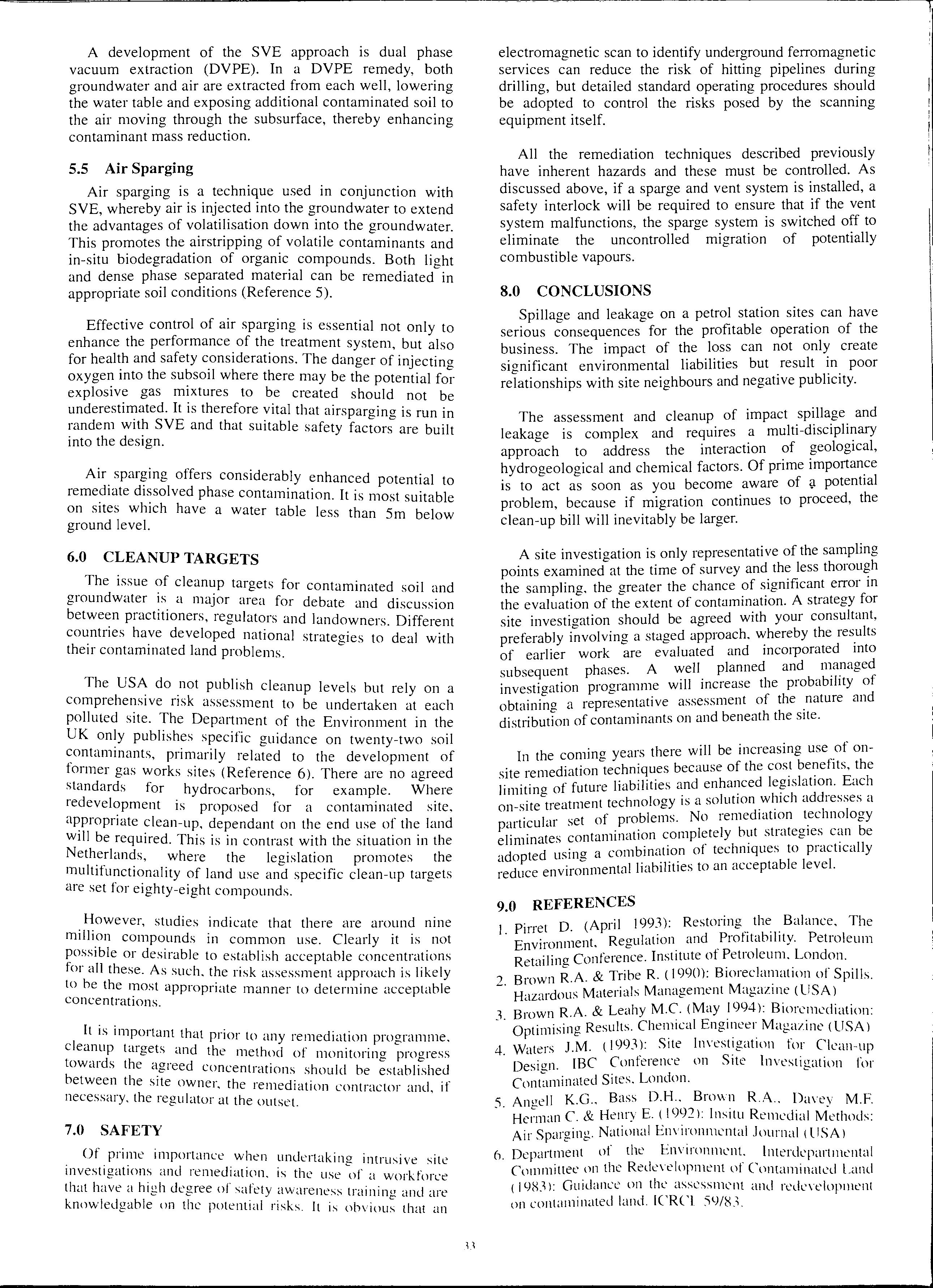
However, studies indicate that there are around nine milli.on compounds in common use. Clearly it is not possible or desirable to establish acceptable concentrations for all these. As such. the risk assessment approach is likely to he the most appropriate manner to determine acceptable concentrations.
It is important that prior to any remediation programme. cleanup targets 111 d th h d f' · ' e met o o momtonng progress towaids the concentrations should be established between the site owner. the remediation contractor and, if necessary. the regulator at the outset.
7.0 SAFETY
Of. pri1.ne importance when undertaking intrusive site 111vest1gat1ons and remediation. is the use of a workforce that have a high degree of safety awareness training and are knowledgahle un the potential risks. It is obvious that an
electromagnetic scan to identify underground ferromagnetic services can reduce the risk of hitting pipelines during drilling, but detailed standard operating procedures should be adopted to control the risks posed by the scanning equipment itself.
All the remediation techniques described previously have inherent hazards and these must be controlled. As discussed above, if a sparge and vent system is installed, a safety interlock will be required to ensure that if the vent system malfunctions, the sparge system is switched off to eliminate the uncontrolled migration of potentially combustible vapours.
8.0 CONCLUSIONS
Spillage and leakage on a petrol station sites can have serious consequences for the profitable operation of the business. The impact of the loss can not only create significant environmental liabilities but result in poor relationships with site neighbours and negative publicity.
The assessment and cleanup of impact spillage and leakage is complex and requires a multi-disciplinary approach to address the interaction of geological, hydrogeological and chemical factors. Of prime is to act as soon as you become aware of potential problem, because if migration continues to proceed, the clean-up bill will inevitably be larger.
A site investigation is only representative of the sampling points examined at the time of survey and the less the sampling, the greater the chance of significant error m the evaluation of the extent of contamination. A strategy for site investigation should be agreed with your consultant, preferably involving a staged approach, the res.ults of earlier work are evaluated and mcorporated mto subsequent phases. A well planned and investigation programme will increase the probab1hty of obtaining a representative assessment of the .nature and distribution of contaminants on and beneath the site.
In the coming years there will be increasing use .of onsite remediation techniques because of the cos.t the limiting of future liabilities and Each _ "t treatment technology is a solution which addresses a on s1 e d' · I I particular set of problems. No reme iat1on 1110 ogy eliminates contamination completely strategies 1be adopted using a of to pract1ca ly reduce environmental hab1ht1es to an acceptable level.
9.0 REFERENCES
I. Pirret D. (April J 993): Restoring Balance, The Environment. Regulation and Prohtab1hty. Petroleum Retailing Conference. Institute of Petroleum. London.
2. Brown R.A. & Tribe R. ( J990): of Spills. Hazardous Materials Management Magazme (USA)
'.\ Brown R.A. & Leahy M.C. (May 1994):
· Optimising Results. Chemical Engineer Magazine (USA)
4. Waters J.M. ( 1993 ): Site Invest!gation for Clean-up Design. IBC Conference on Site Investigation for Contaminated Sites. London.
5. Angell K.G.. Bass D.H.. Brown R.A.. Davey M.F. Herman C. & Henry E. ( 1992): Insitu Remedial Methods: Air Sparging. National Environmental .lnurnal (USA)
6. Department of the Environment. Interdepartmental Committee on the Redevelopment of Contaminated Land ( J 983 ): Guidance on the assessment and redcvelopmenl on contaminated land. lCRCI 59/83.
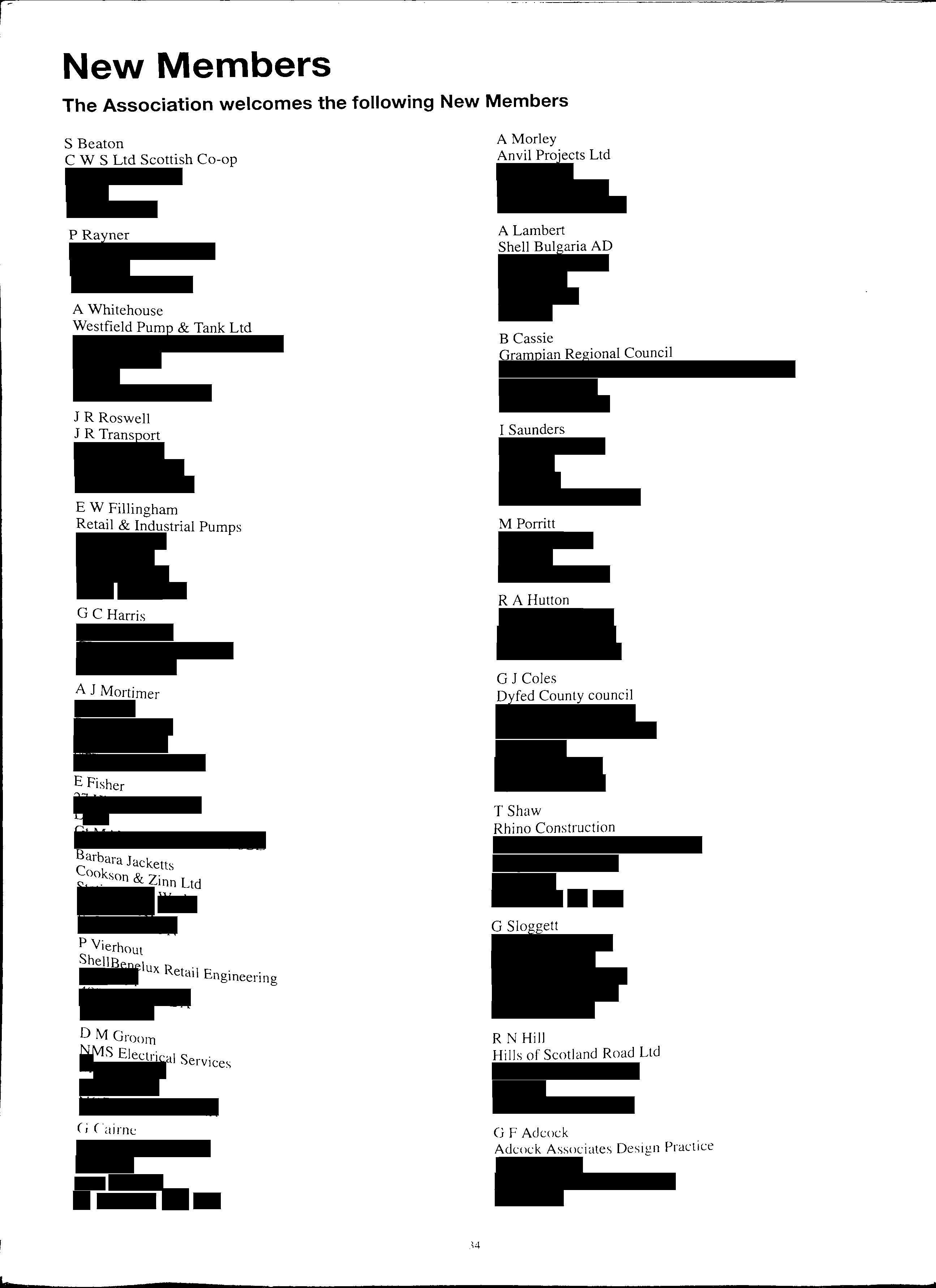
New Members The Association welcomes the following New Members S Beaton C W S Ltd Scottish Co-op P Rayner A Whitehouse Westfield Pump & Tank Ltd J R Roswell J R Transport E W Fillingham Retail & Industrial Pumps G C Harris A 1 Mortimer E Fisher Jacketts OOkson & z·inn Ltd p Vierhout elux Re . . . tail Engineering D M Groom S Electrical s . erv1ces (; Cairnc .l4 A Morley Anvil Projects Ltd A Lambert Shell Bulgaria AD B Cassie Grampian Regional Council I Saunders M Porritt RA Hutton G J Coles Dyfed County council TShaw Rhino Construction G Sloggett RN Hill Hills of Scotland Road Ltd G F Adcock Adcock Associates Design Practice
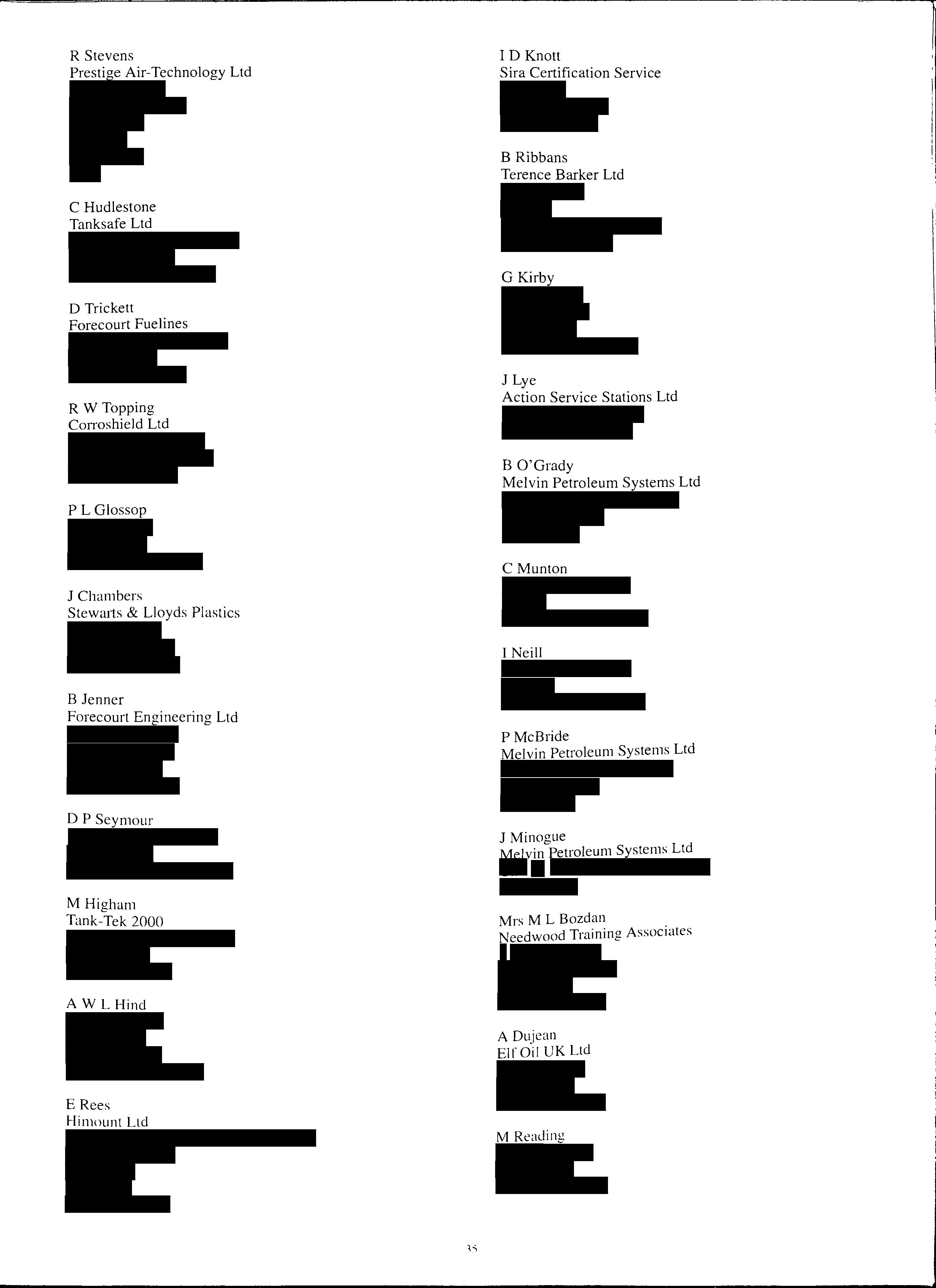
R Stevens Prestige Air-Technology Ltd C Hudlestone Tanksafe Ltd D Trickett Forecourt Fuelines R WTopping Corroshield Ltd P L Glossop J Chambers Stewarts & Lloyds Plastics B Jenner Forecourt Engineering Ltd DP Seymour M Higham Tank-Tek 2000 AWL Hind E Rees Himount Ltd ID Knott Sira Certification Service B Ribbans Terence Barker Ltd G Kirby J Lye Action Service Stations Ltd B O'Grady Melvin Petroleum Systems Ltd C Munton I Neill P McBride Melvin Petroleum Systems Ltd J Minogue Melvin Petroleum Systems Ltd
M L Bozdan Needwood Training Associates A Dujean Elf Oil UK Ltd M Reading
Mrs
LOCK UP YOUR PETROL
"UNI-CAP"
The simple answer for your fill-pipe
The cam type forecourt cap has been with us for many years and is now the standard for most new sites being built.
The conventional way of capping off this type of fitting is with a cap with two levers one or both of which are secured by a padlock.
That is simple enough until after many years someone in the industry take s a fresh look and say s "these padlocks are a bit troublesome, can't we come up with something better than this " .
Our response to this sort of question is usually "Yes I'm sure we can" and after a short period working with a major forecourt operator we produced a new approach to the secunty, safety and ease of operation of this important area of fuel handling.
To be an improvement any new piece of equipment should be d · d h f es1gne wit ease o use as a pnmary consideration r t d , 1 f · n o ay s c 1mate any item we come across or the first f h · · · · ime t at 1s d1ff1cult to operate soon become s an 1rntat1on so let CAP us now exarnrne the operation of the UNiand the benefits we have incorporated to make this part of the forecourt work that little bit better.
• UNI-CAP is designed with its own built in lock which cannot disappear down a manhole like a loose Likewi se it does not need the additional c am or strap required on the DCD site.
• The operation of the cap relies on just one lever which works particularly easily and with a smooth action.
• Thi s sinole l b "" ever can e operated by one hand oloved or otherwise, particularly useful in the
• The po sitio f h · n o t e operatmg lever can be clearly seen even from a di stance.
• The cap can only be locked when the lever is in the correct po s iti on.
• The shaft that carries out the lockino function is co mpl ete ly protected by the lever and does not have th e w k · ea po111t that most padlocked caps tend to ex h1b1 t.
• The lock mechani sm itself also gives a high visibility rnd1 cat1o n that the cap is correc tly secured and is aga rn very c lear even from a di stance
• Pos itioning the loc k on the top of the cap give s an eas y e ntry fo r the special key even in poor light c ompare thi s wit h try in g to put a key into an awkward pad lo c k
• An important factor is weight UNI-cap is less than 2lbs.
• Enaineerina to a specification rather than down to a the cap is manufactured to a standard and will give long and robust service.
• Installation could not be easier with a heavy duty TieWrap provided with each cap allowing the attachment strap to be fitted in the most convenient way Either round the fill-pipe itself or to a more convenient pomt if appropriate.
• With each dispatch of the UNI-CAP a clear set of instructions are included allowing any forecourt operator to gain rapid staff acceptance of the new method of fill-pipe security.
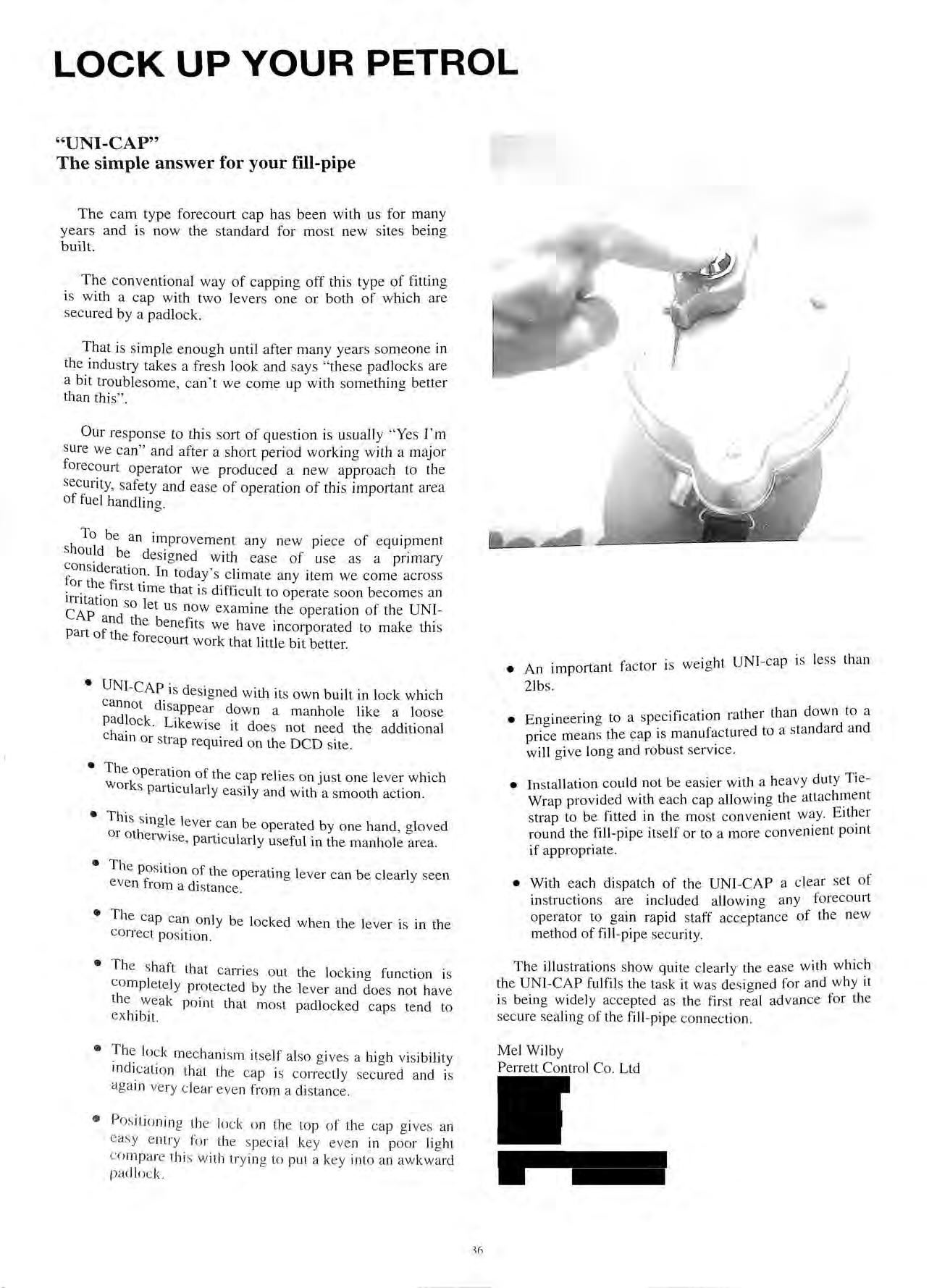
The illustrations show quite clearly the ease with which the UNI-CAP fulfils the task it was designed for and why it is being widely accepted as the first real advance for the secure sealing of the fill pipe connection.
Mel Wilby Perrett Control Co. Ltd
36
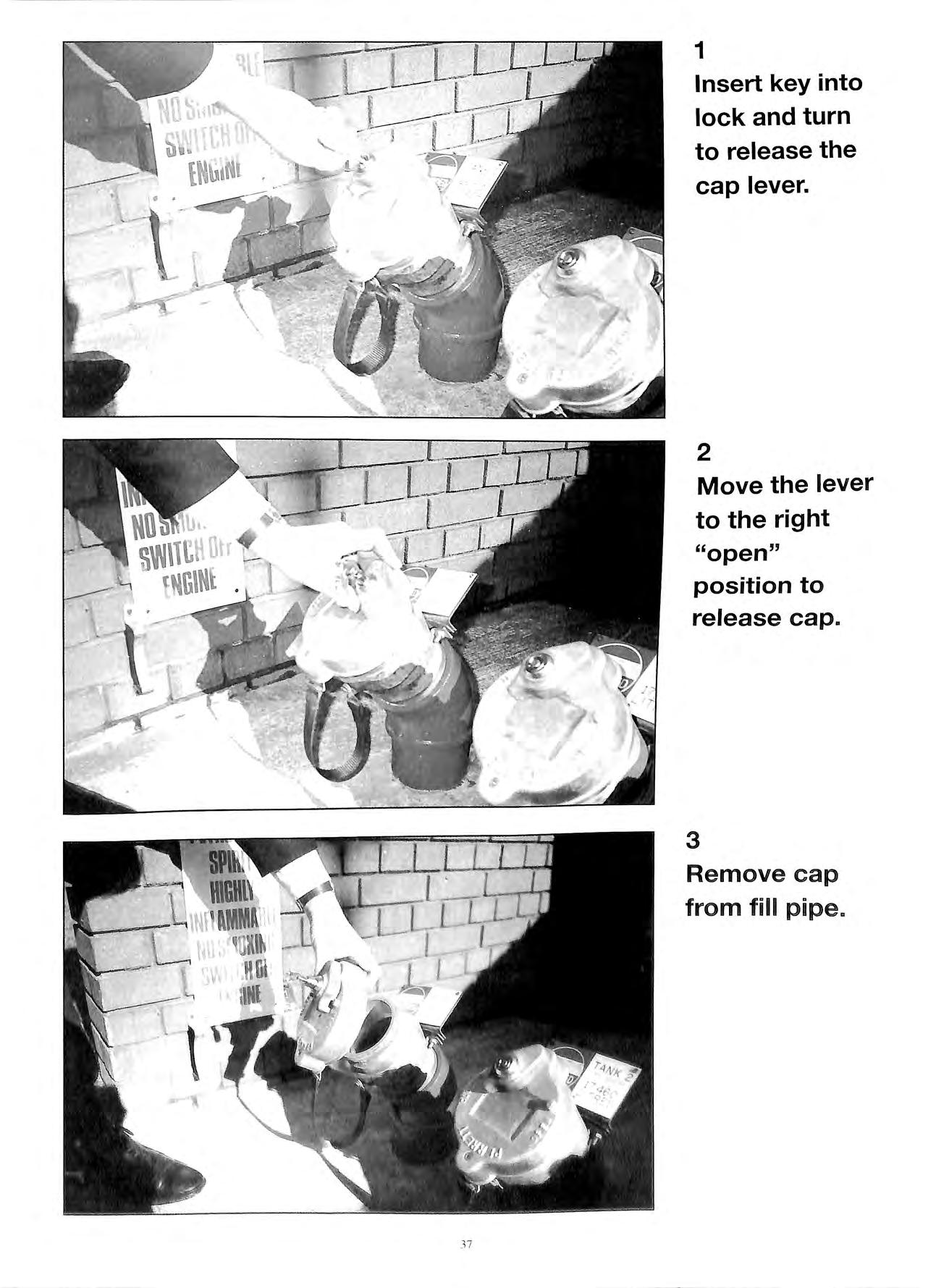
37 1 Insert key into lock and turn to release the cap lever. 2 Move the lever to the right "open" position to release cap. 3 Remove cap from fill pipe.
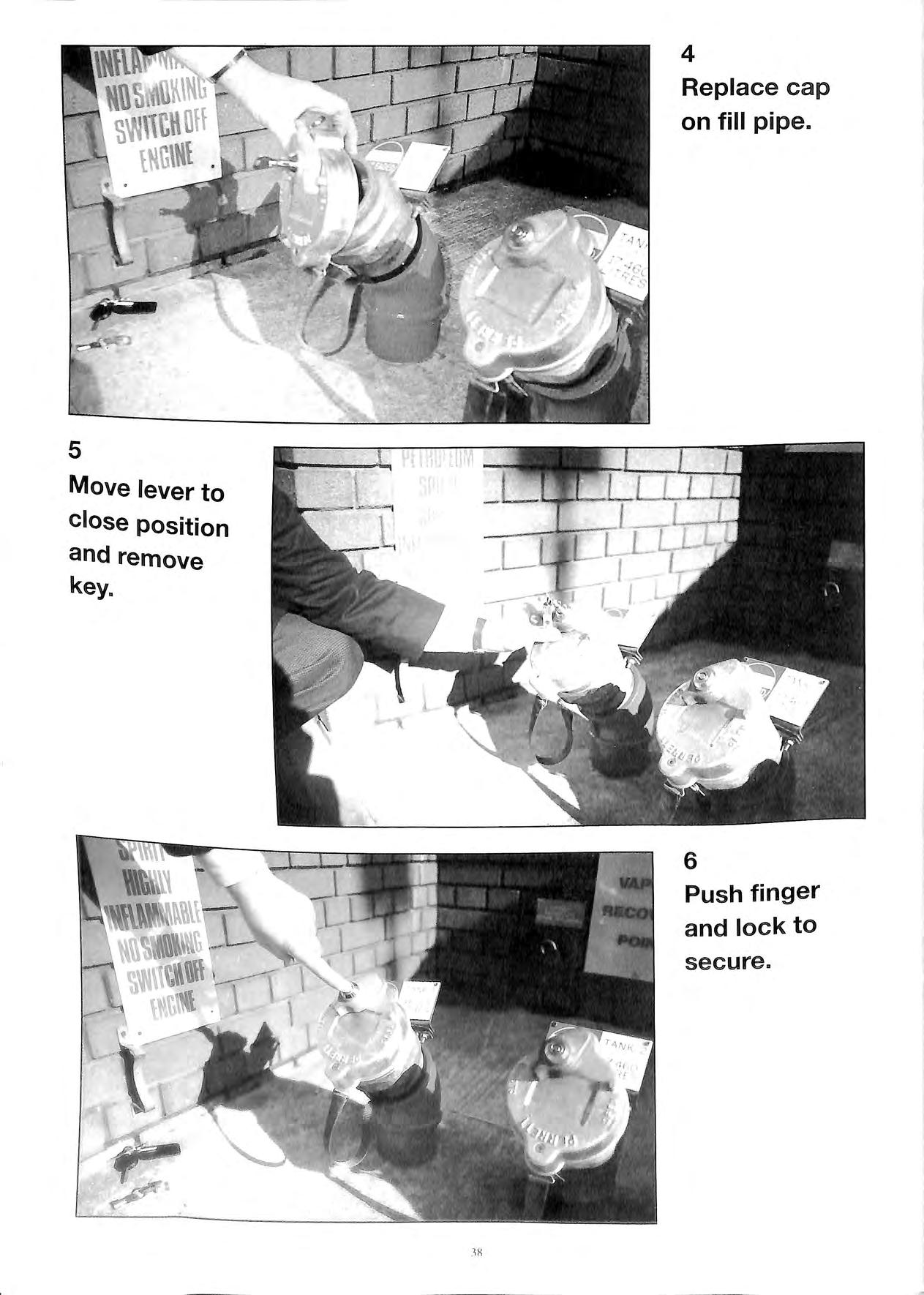
5 Move lever to close position and remove key. 4 Replace cap on fill pipe. 6 Push finger and lock to secure.
EYhe/l
e New Busin e ss C ontacts

A Company Li m ited by Gu arantee Reg istered in England No 2261 660 ... ... ••• you are ... involved in the Oil Industry work for an oil company work for a retailer operating petrol
stations a Petroleum Officer, or a Regulator concerned with the industry a supplier of goods or services to the petroleum industry a contractor to the industry
The Association for Petroleum and Explosives Administration Registered Office: Stoughton House Harborough Road Oadby Leicestershire LE24LP England
filling
...
should join the APEA ... The Association
Petroleum
Explosives
You
for
a d
Administration e Low Cost Value for Money ... At only £20 per annum, the APEA offers substantial returns on your membership subscription, which may be tax-deductible. e Be Better Informed APEA Publications, including a free quarterly magazine, The Bulletin, APEA Newsletters and other essential literature, meetings, seminars and conferences all enable members to be better informed about new developments , changing legislation, and new technology.
'•- •• r w• , A:PEA Industry and Regulato1·s Working Together For a Safer Environment ' _,.,.., ___ ,._......__. · .,, ,._ ,_ !
Membership of the APEA offers you the forum in which you can exchange views and ideas wi t h colleagues and fellow members , and make valuable new contacts within the industry.
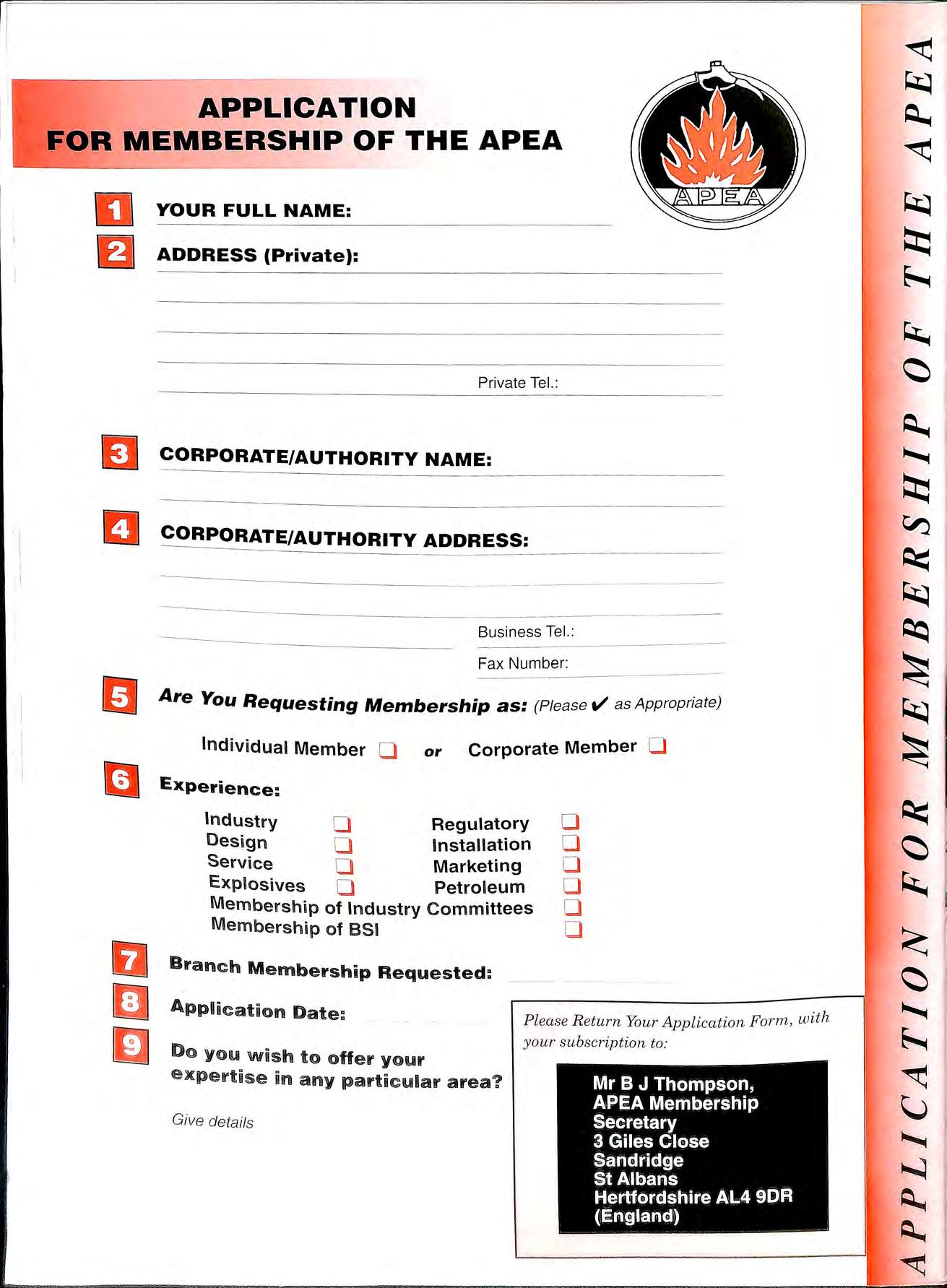
APPLICATION F01R MEMBERSHIP OF THE APEA YOUR FULL NAME: El ADDRESS (Private): Private Tel.: IEJ CORPORATE/AUTHORITY NAME: CORPORATE/AUTHORITY ADDRESS: Business Tel.: Fax Number: Are You Requesting Membership as: (Please V as Appropriate) Individu al Member D or Corporate Member D a Experience: Industry O Regulatory D Design O Installation D Service O Marketing D Explosives O Petroleum D Membership of Industry Committees D Membership of BSI D Branch Membership Requested: Application Do you wish to offer your expertise in any particular area? Please Return Your Application Form , with your subscription to: G ive details Mr B J Thompson, A.PEA Membership Secretary 3 Giles Close Sandridge St Albans Hertfordshire AL4 9DR (England)
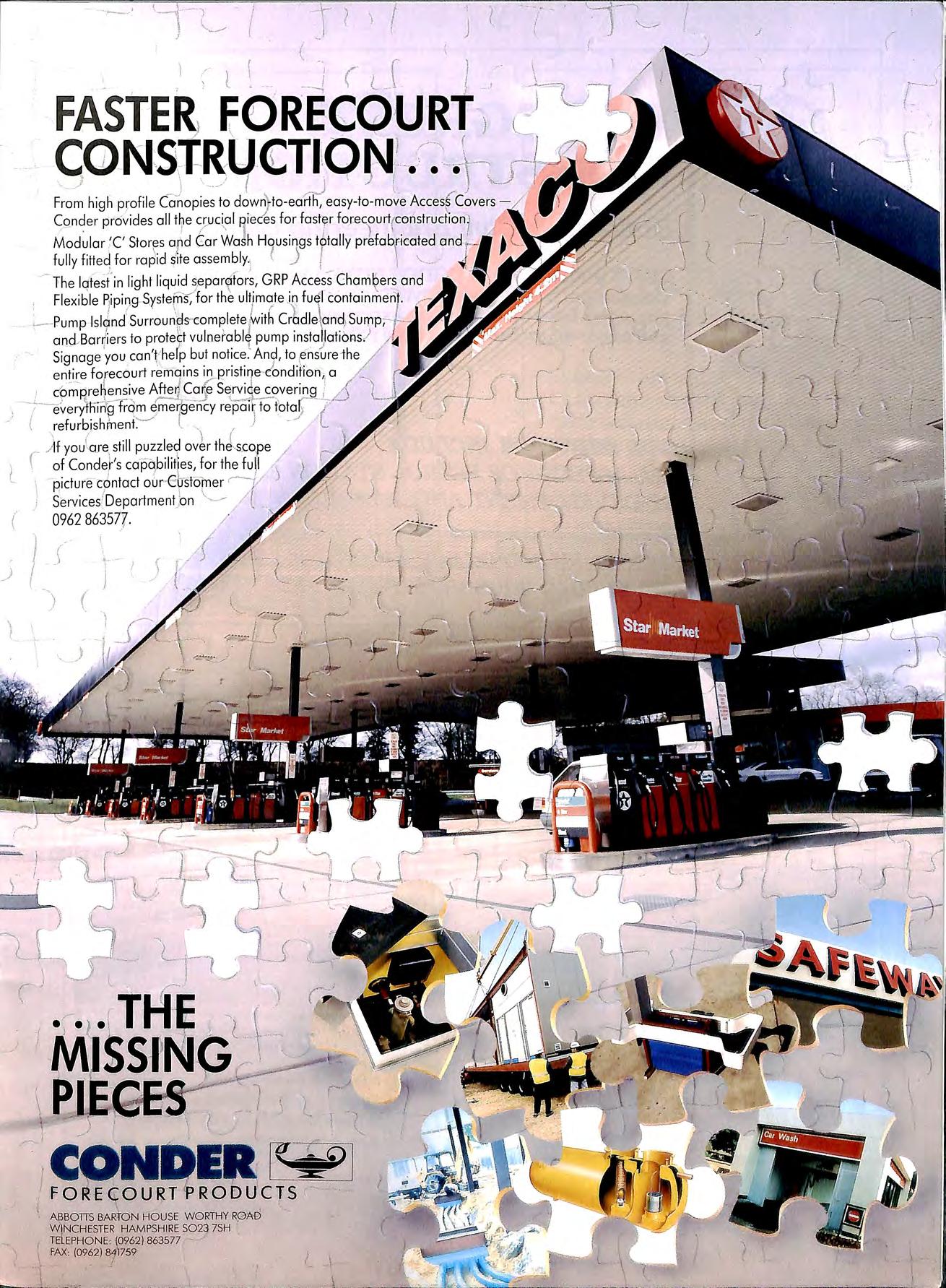
i I I -\\ I J \ { ( ( , ·:i 1 1< r J \ < -; L - - - ' --r=G! CG)_(\J:.S\JRU --- .'rTliONL __ r- '} I(_ 1 1 \ / { \l.- t J / • • • \ ,/ \ \ \ From high profile Canopies to down ,to-earth, easy-to-move Access Covers / provides all 1ie /es for fast yr foi:ec) urt(constru cfiont __ Modular '. C' Stores apd Car Wash Housi gs t6tally prefabt iee:ited • fully fitte tj for s·rte assembly.! ( { \ '----lqlest in light and · , Flexible for the fu el contarnmen lslT, nd CradJe\e:ind1Surpp1 and, Barri iers to pump / !II Signage you can but AnJ , to_ t nsurex the en ti! e fo ecourt rem 9 1ns In a _ r __ : cp mp(e . Si:; rvi Ge LJ ) / repar ) to totc:f ·(; ( refu rbrshf!lent. l , \ / ) ( __;jf ;till over the,sco,pe / L ( s the fu ll ) P,rcture tontact r----j/ ' I \ I / I Services ·Department_,b n '......-- l ( 0962 86357(. / ( '_{ _) l, r 1 L ) ( J l,_ \ I ,-- ) ( \ ·; ; r., A ,,,,...._/'.? v:_) ::,_c: . r _j I l \ /
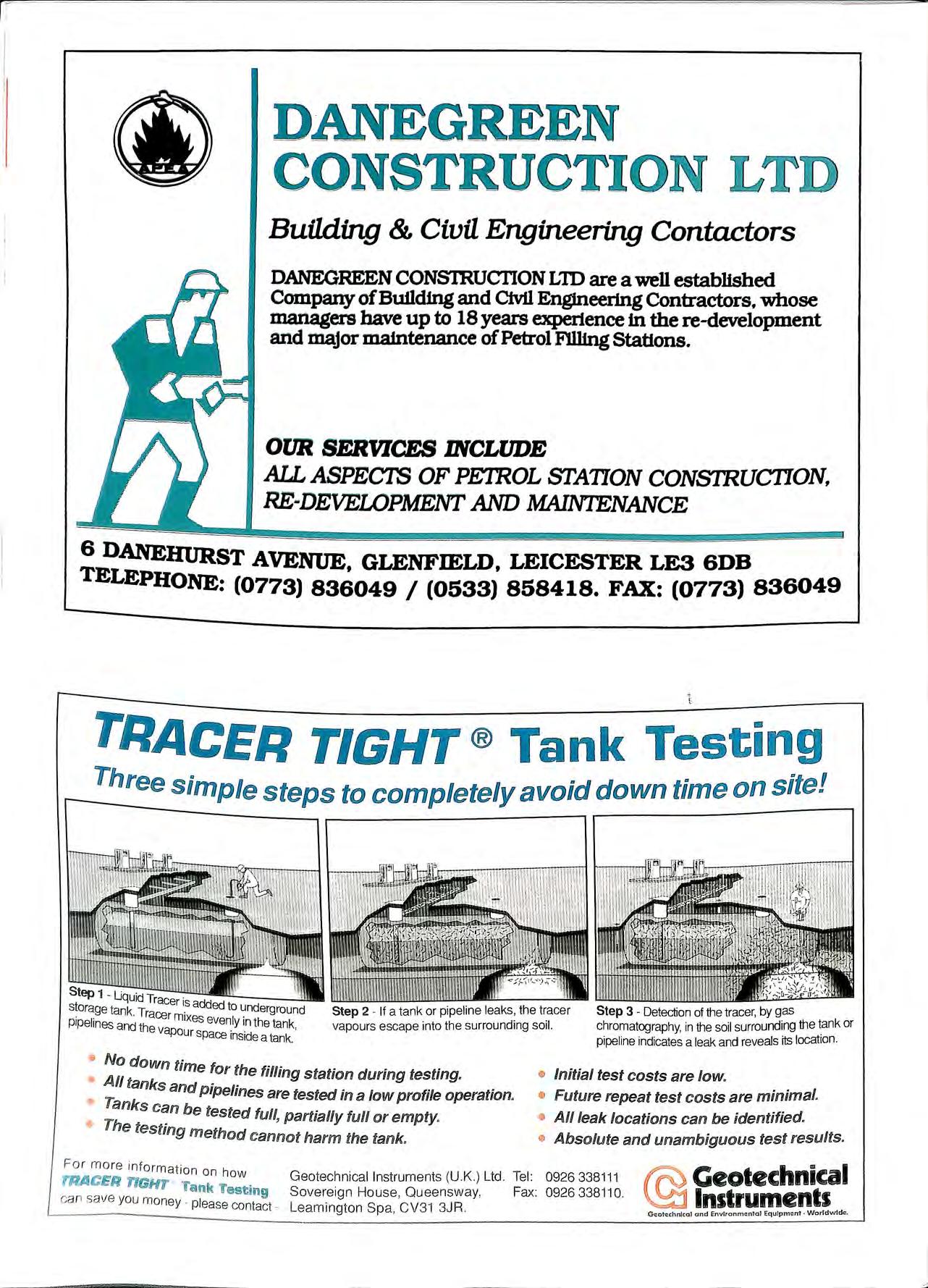
DANEGREEN CONSTRUCTION Bullding & Civll Engineering Contactors DANEGREEN CONSIRUCTION LID are a well established Company of Building and Civil Engineering Contractors. whose managers have up to 18 years experience in the re-development and major maintenance of Petrol Filling Stations. OVR SERVICES INCLUDE ALL ASPECTS OF PE'IROL STATION CONSTRUCTION, AND MAINIENANCE 6 DANEHlJRST AVENUE, GLENFIELD, LEICESTER LE3 6DB TELEPHONE: (0773) 836049 / (0533) 858418. FAX: (0773) 836049 TRACER TIGHT® Tank Testing Three simple steps to completely avoid down time on site! Step 2 If a tank or pipeline leaks, the tracer vapours escape into the surrounding soil. Step 3 Detection of the tracer, by gas chromatography, in the soil surrounding the tank or pipeline indicates a leak and reveals its location. 0 No do iM t" . . . n tme for the f1llmg station during testmg. • All tanks and · pipe/mes are tested in a low profile operation. • Tankscanb • Th e tested full, partially full or empty e testing me th od cannot harm the tank. Initial test costs are low. © Future repeat test costs are minimal. " All leak locations can be identified. 0 Absolute and unambiguous test results. Fo r mo re information on how Geotechnica l Instruments (U.K.) Ltd Tel: 0926 338111 TRACER flGHT Tank Testing Sovere ign House, Queensway, Fax: 0926 338110. Cieotechnical Instruments can s ave you money please co ntact Leam ington Spa, C V31 3JR. and Envlronmcmt ol Equlpmonf Worfdwh:k.
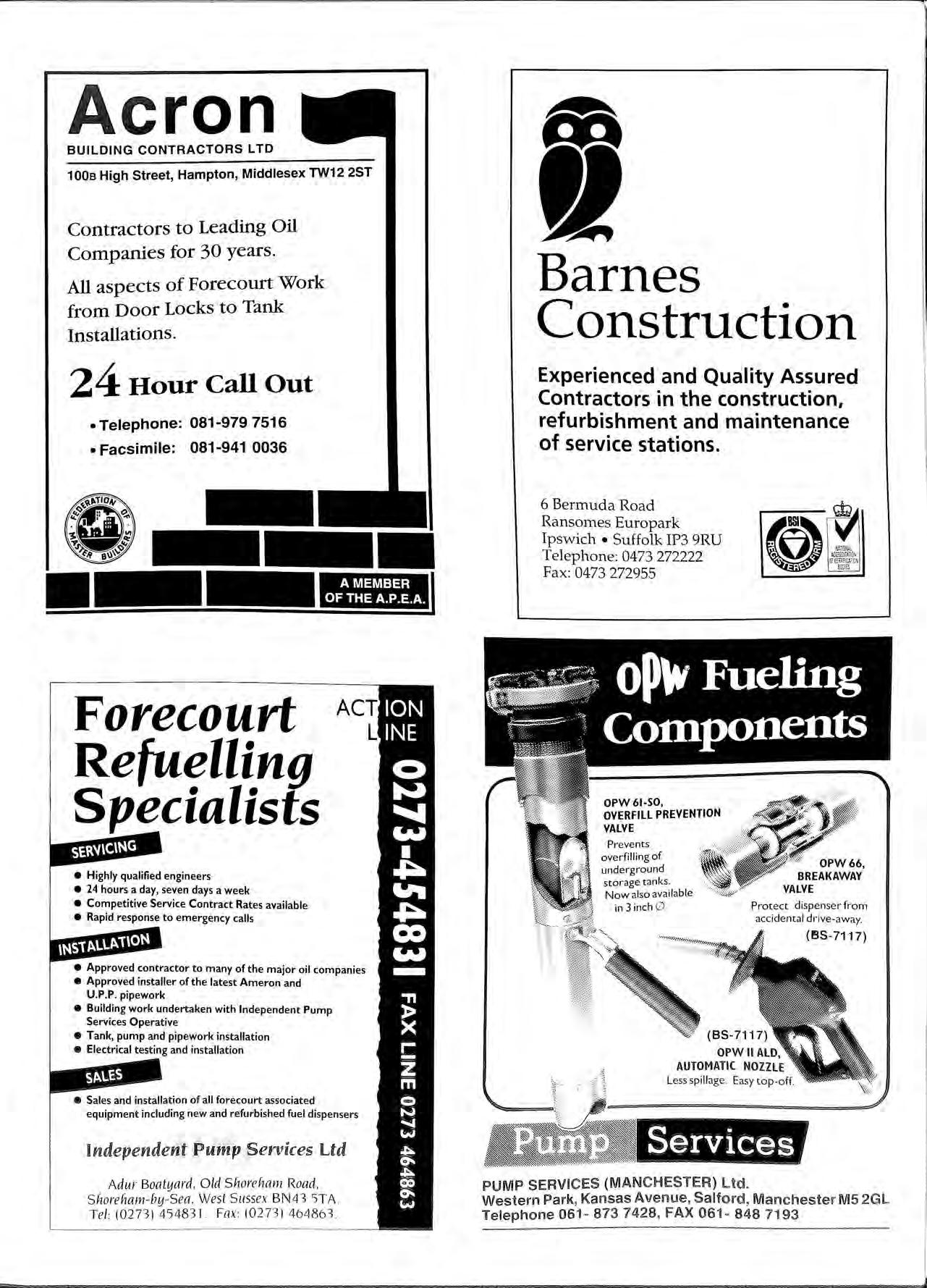
Acron BUILDING CONTRACTORS LTD 100s High Street, Hampton, Middlesex TW12 2ST Contractors to Leading Oil Companies for 30 years. All aspects of Forecourt Work from Door Locks to Tank Installations. 24 Hour Call Out •Telephone: 081-979 7516 •Facsimile: 081-941 0036 A MEMBER OF THE A.P.E.A. Forecourt Refuelling Specialists SER'l\C\NG • Highly qualified engineers • 24 hours a day, seven days a week • Competitive Service Contract Rates available • Rapid response to emergency calls l • Approved contractor to many of the major oil companies • Approved installer of the latest Ameron and U.P.P. pipework • Building work undertaken with Independent Pump Services Operative • Tank, pump and pipework installation • Electrical testing and installation SA.LES • Sales and installation of all forecourt associated equipment including new and refurbished fuel dispensers Independent Pu mp Servic es Ltd Adur Boatyard, Old Shoreham Road, Shoreham-by-S ea, West Susse x BN4 3 STA Tel (027 3 ) 45 48 3 1 Fax (0 2 7 3 ) 464 8 63 ION INE 0 ....... IAI I "' co IAI.,, )> >< r z m 0 t-.J ..... w .. co °" w Barnes Construction Experienced and Quality Assured Contractors in the construction, refurbishment and maintenance of service stations. 6 Bermuda Road Ransornes Europark Ipswich • Suffolk IP3 9RU Telephone: 0473 272222 Fax: 0473 272955 OPW61-SO, OVERFILL PREVENTION VALVE Prevents overfilling of underground scornge tanks. Now also available in 3 inch 0 Protect dispenser· from accidental drive-aw ay. (19S- 7117) OPWllALD, ' AUTOMATIC NOZZLE Less spillage Easy top-off. PUM P SERVICES (MAN CHEST ER ) Ltd. Western Pa r k, Kan sa s Avenue, Sa lford, Manch este r M5 2GL Tele p hon e 061 8 73 7 428 , FA X 061 8 4 8 7193
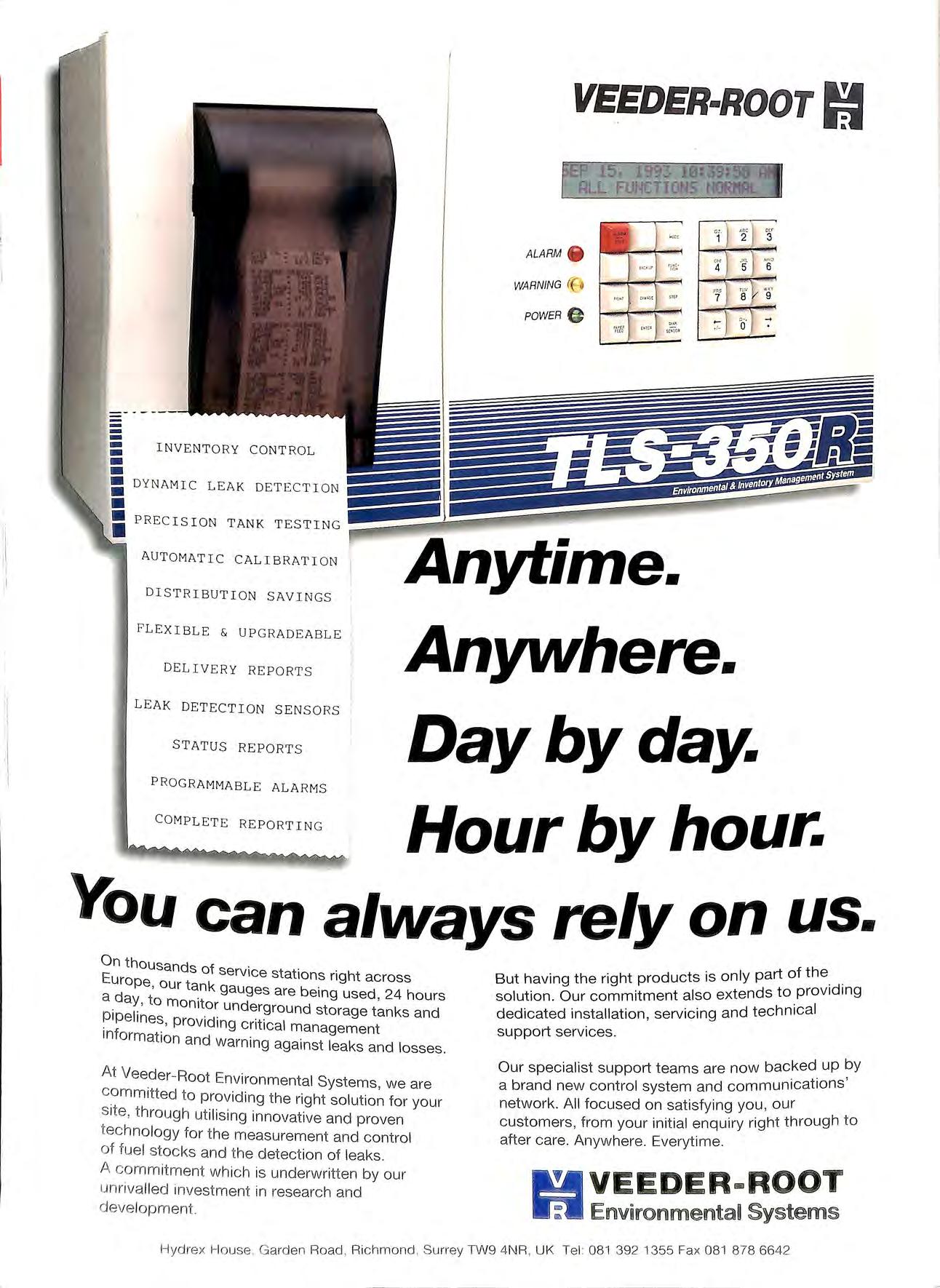
VEEDER-Roar tit ALARM 8 WARNING · POWER e 7s -:;: ) a· - - - ----= INVENTORY CONTROL• : DYNAMIC LEAK DETECTION • ; PRECISION TANK TESTING AUTOMATIC CALIBRATION Anytime. DISTRIBUTION SAVINGS DELIVERY REPORTS FLEXIBLE & UPGRADEABLE Anywhere. LEAK DETECTION SENSORS STATUS REPORTS Day by day. PROGRAMMABLE ALARMS COMPLETE REPORTIN G Hour by hour. You can always rely on us. On thousand f E s 0 service stations right across urope , our tank gauges are being used 24 hours a day t · ' . , 0 rnon 1tor underground storage tanks and Pipelines, Providing critical rnanagernent 1 ntorrnation and warning against leaks and losses
Veeder-Root Environrnental Systerns, we are cornrnitted to providing the right solution for your site , through utilising innovative and proven technology for the measurement and control of fuel stocks and the detection of leaks
cornmitrnent wh ich is underwritten by our unriva lled investment in research and development. But having the right products is only part of the. . sol ution. Our commitment also extends to.providing dedicated installation, servicing and technical support services. Our specialist support teams are now backed up by a brand new control system and communications ' network. All focused on satisfying you , our customers, from your initial enquiry right through to after care . Anywhere. Everytime . b VEEDER-ROOT 1:1 Environmental Systems Hyd,ex House Ga,den Road , R;chmond , Su"ey 1W9 4NR , UK lei 081 392 1355 Fax 081 878 6642 I
At
A
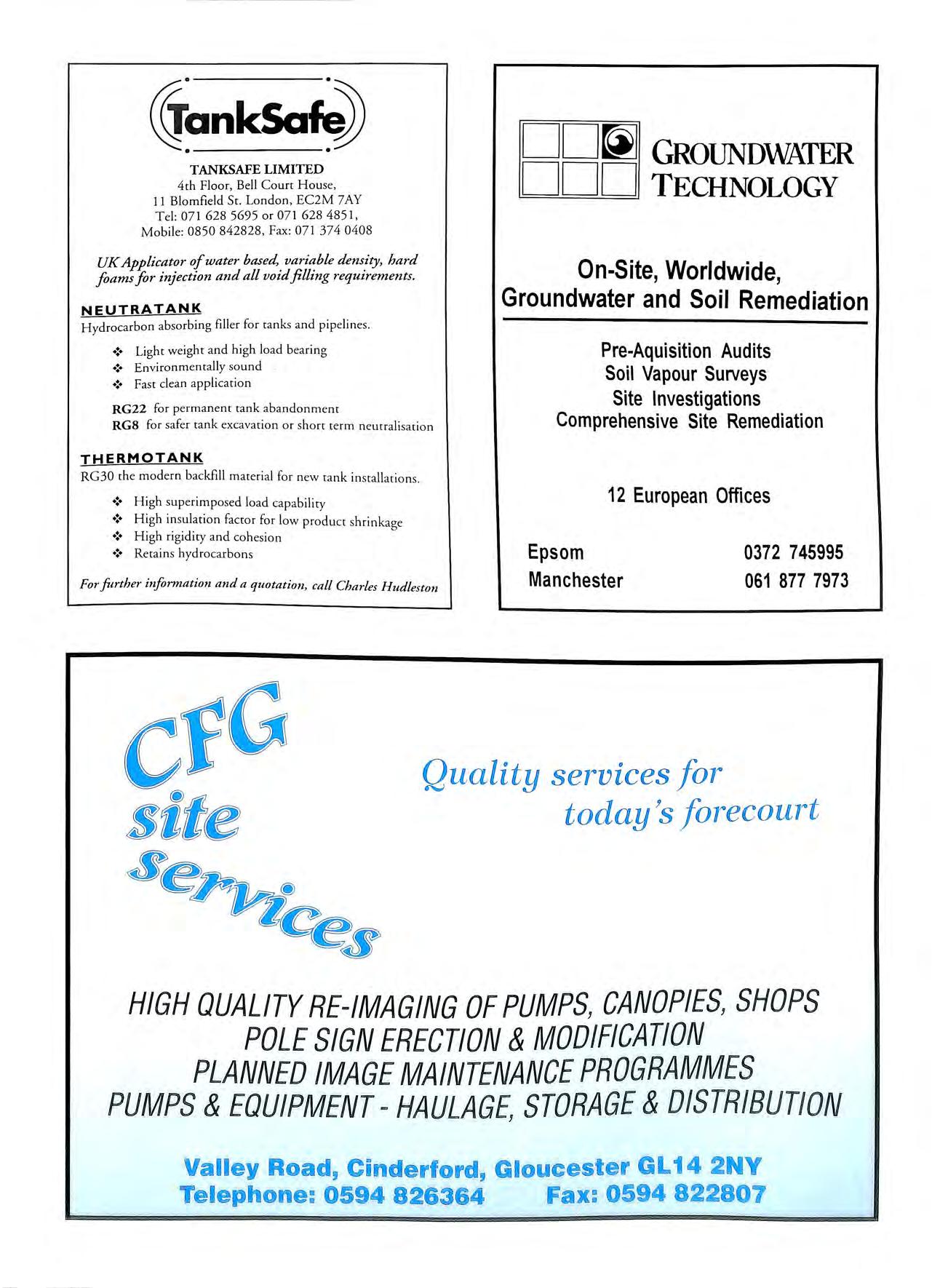
. . TANKSAFE LIMITED 4th Floor, Bell Court House, 11 Blomfield St. London, EC2M 7AY Tel: 071 628 5695 or 071 628 4851, Mobile: 0850 842828, Fax: 071 374 0408 UKApplicator ofwater based, variable density, hard foams for injection and all voidfilling requirements. NEUTRATANK Hydrocarbon absorbing filler for tanks and pipelines. •:• Light weight and high load bearing •:• Environmentally sound •:• Fast clean application RG22 for permanent tank abandonment RGB for safer tank excavation or short term neutralisation THERMOTANK RG30 the modern backfill material for new tank installations. •:• High superimposed load capability •:• High insulation factor for low product shrinkage •:• High rigidity and cohesion •:• Retains hydrocarbons For further infonnation and a quotation, call Charles Hudleston GROUNDWATER ODD TECHNOLOGY On-Site, Worldwide, Groundwater and Soil Remediation Pre-Aquisition Audits Soil Vapour Surveys Site Investigations Comprehensive Site Remediation 12 European Offices Epsom 0372 745995 Manchester 061 877 7973 cf G site &e v Qitality services for today Js f orecoitrt '"Cea HIGH QUALITY RE-IMAGING OF PUMPS, CANOPIES, SHOPS POLE SIGN ERECTION &MODIFICATION PLANNED IMAGE MAINTENANCE PROGRAMMES PUMPS & EQUIPMENT - HAULAGE, STORAGE &DISTRIBUTION Valley Road, Cinderford, Gloucester GL 14 2NY Telephone: 0594 826364 Fax: 0594 822807
LEAK DETECTION SYSTEMS FOR DOUBLE SKIN TANKS.
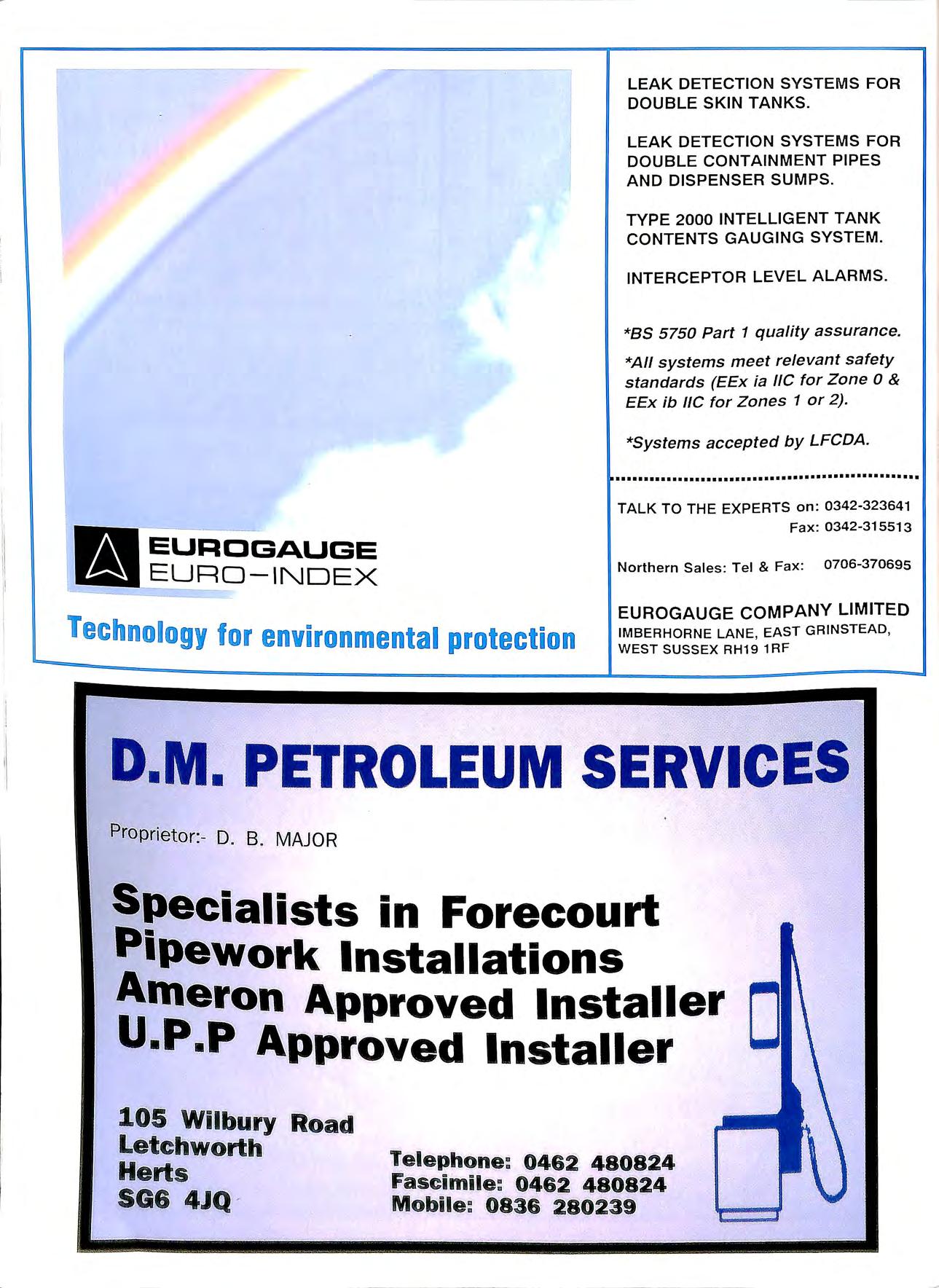
LEAK DETECTION SYSTEMS FOR DOUBLE CONTAINMENT PIPES AND DISPENSER SUMPS.
TYPE 2000 INTELLIGENT TANK CONTENTS GAUGING SYSTEM.
INTERCEPTOR LEVEL ALARMS.
• EURCGAUGE EURO-INDEX i...-:..:::;;;==:==::=:::::::
····•••··············•·········•·····················
Tee nology for environmental protection EUROGAUGE COMPANY LIMITED IMBERHORNE LANE, EAST GRINSTEAD , WEST SUSSEX RH19 1RF D.M. PETROLEUM SER\il<C&S · IU . B. MAJOR Specialists in Forecourt Pipework Installations Ameron Approved Installer O' .. U.P .P Approved Installer llS WiHllury Read letmllwenh Hens SCI 4lJQTelephone: 1 4 62 4 8 0 824 Fasei1mHe: 1 4 62 481 · 824 M 'ehi·le,: 0 ,836 2802319
*85 5750 Part 1 quality assurance. *All systems meet relevant safety standards (EEx ia l/C for Zone 0 & EEx ib l/C for Zones 1 or 2). *Systems accepted by LFCDA.
TALK TO THE EXPERTS on: 0342-323641 Fax: 0342-315513 Northern Sales: Tel & Fax: 0706-370695
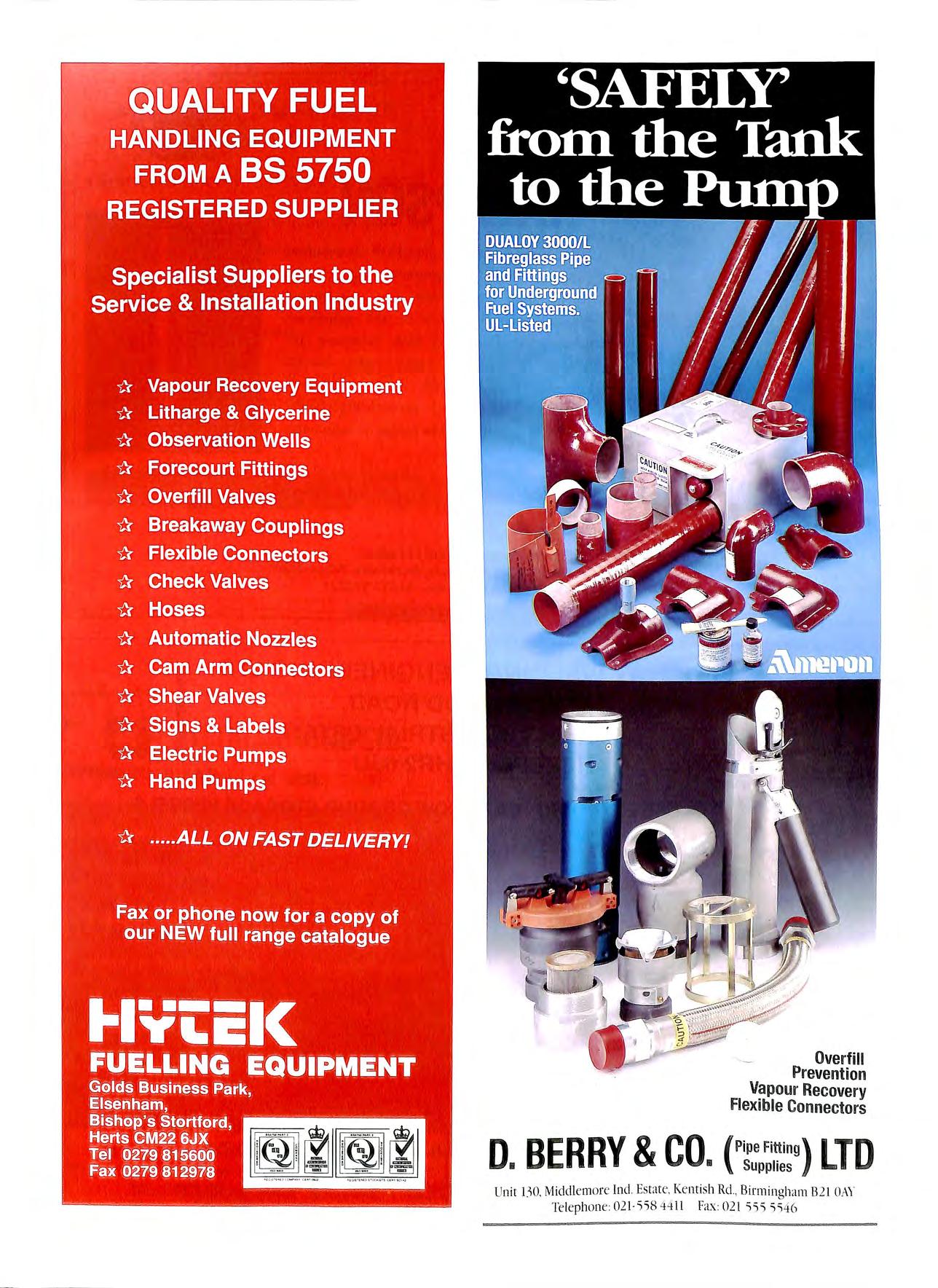
Overfill Prevention Vap our Recove ry Flexible Con ne ctor s Unit no. Middlemore Ind Es tate. Kenti sh Rei , Birmingham 8 21 OA\ Teleph one 02Vi5 8 44 11 fax 021 'i 55 'i 'i 46

<>PW FUEUNG COMPON ENTS EUROPE B V. A QOVEA RESOURCES COMPAN Y
LINK
are official UK distributors
OPW Fueling Components and EBW
are
suppliers
are
placed
supply; vapour-tight overfill prevention devices, Stage
vapour recovery equipment, spill containers , monitoring wells, breakaway couplings and
wide range of automatic
manual nozzles Premium Products - Superior Service Link Hampson A Division of UTC (UK) Limite d UTAC House, Bone Lane, Newbury, Berkshire, RG 14 SUH Telephone: O1635 524200 Fax: 01635 550331 lw LEDBURY WELDING & ENGINEERING LTD. Ml NETHERWOOD ROAD, ROTHERWAS INDUSTRIAL ESTATE, (TEL: 01 432-27 5566) HEREFORD HR2 6JU (FAX: 01432 358493) A COMP L ETE RANGE OF ABOVE & BELOW GROUND STORAGE VESSELS OU ALI TY UNDERGROUND TANKS DOUBLE AND SINGLE SKIN QUALITY UNDERGROUND TANKS SPECIALIST COATING lEAK DETECTION OVERFILL PREVENT ION DEVICES MANWAY ACCESS FRAMES MULTIPLE COMPARTMENTS A O V!E tFlUJllY BUNDED 'fOTAllY ENCLOSED Goe soo GAllON 110 GALLON .
HAMPSON
HAMPSON
for
International, both of whom
recognized worldwide as leading
to the pet roleum forecourt industry. Therefore, Link Hampson
ideally
to
I B
a
and
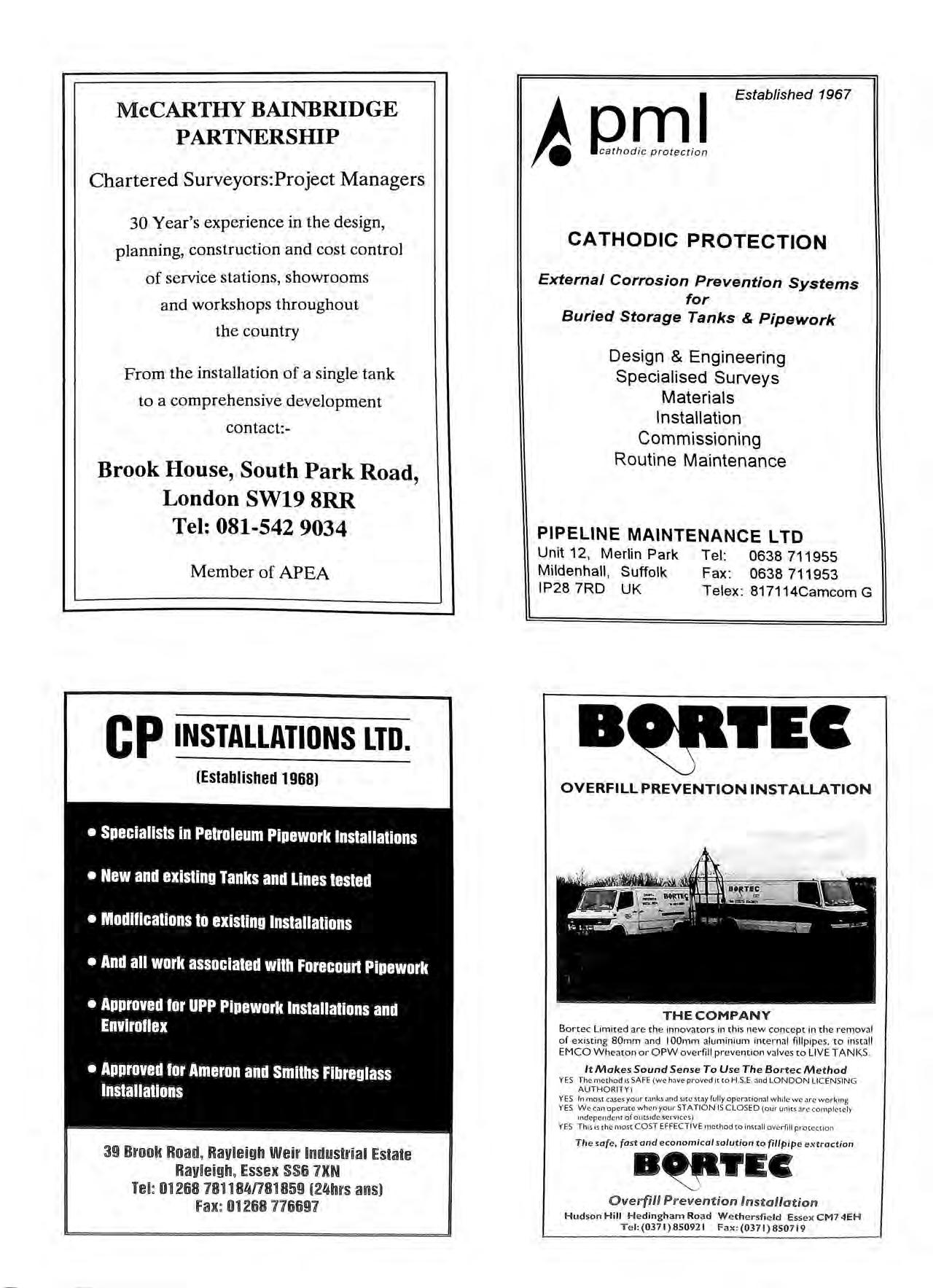
McCARTHY BAINBRIDGE PARTNERSHIP Chartered Surveyors:Project Managers 30 Year's experience in the design, planning, construction and cost control of service stations, showrooms and workshops throughout the country From the installation of a single tank to a comprehensive development contact:Brook House, South Park Road, London SW19 8RR Tel: 081-542 9034 Member of APEA Cp INSTALLATIONS LTD. (Established 1968) • Specialists in Petroleum Pipework lnstallalions • New and existing Tanks and Lines tested • Modifications to existing Installations • And all work associated with Forecoun Pipework • Approved for UPP Pipework Installations and Envirollex • Approved for Ameron and Smiths Fibreglass Installations 39 Brnok Road, Rayleigh Weir imhllstroa! Estate Rayiengh, Essex SS6 7X N 268 781184n8 1859 [24hrs 3H11S) fax: 01268 176691 Established 1967 CATHODIC PROTECTION External Corrosion Prevention Systems for Buried Storage Tanks & Pipework Design & Engineering Specialised Surveys Materials Installation Commissioning Routine Maintenance PIPELINE MAINTENANCE LTD Unit 12, Merlin Park Mildenhall, Suffolk IP28 7RD UK Tel: 0638 711955 Fax : 0638 711953 Telex: 817114Camcom G OVERFILL PREVENTION INSTALLATION THE COMPANY Bartee Limited are the innovators in this new conc ept in the removal of existing BOmm and I OOmm aluminium interna l fill pipes. to install EMCO Wheaton or OPW overfill prevention valves to LIVE TANKS It Makes Sound Sense To Use The Bartee Method YES The method is SAFE (we have proved it to H.S E :ind LO ND O N LI CENS IN G AU TH O RITY ) YES In most cases you r canks site stay fully operational whi le we :ire working YES We can operate when your STATION IS CLOSED (o ur units :ire comple te ly indepe ndent of outside services) YES Tim is the most COST EFFE CTIVE me thod to install overfill protection The safe, fast and economical solution to (ii/ pipe extraction B"'TEC Overfill Prevention Installation Hudson Hi ll Hedingh am Road Wethe rsfie ld CM7 4EH Te l: (0371 )85 09 21 faJ<: (03 71) 8507 19
Introducing SMITH FLEX™ Flexible Dual-Wall System with Stainless Steel.
Check out the new standard in flexible underground piping the UL Listed SMITHFLEX dualwall system. SMITHFLEX piping is designed to handle all
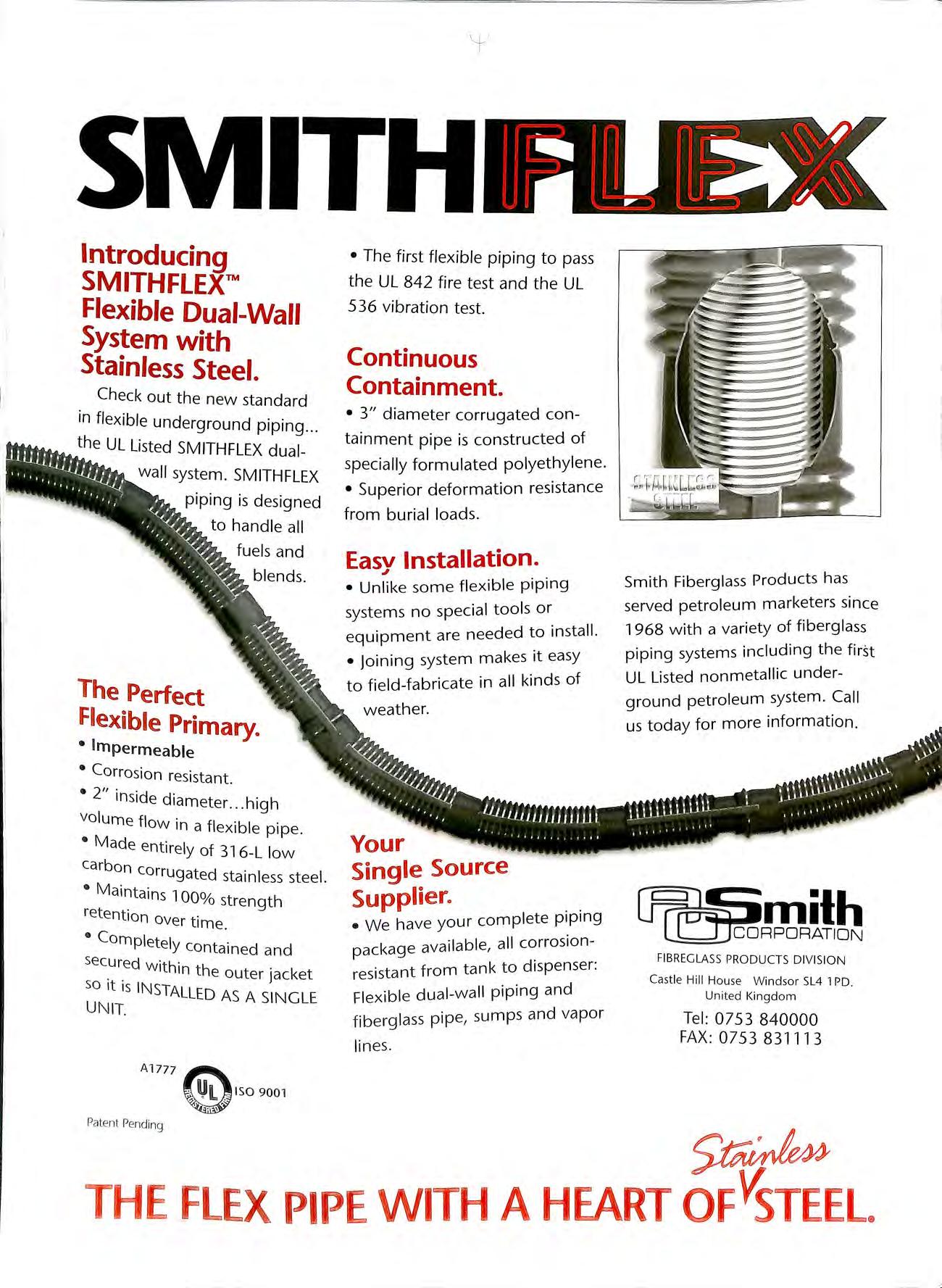
• The first flexible piping to pass the UL 842 fire test and the UL 536 vibration test.
Continuous Containment.
• 3" diameter corrugated containment pipe is constructed of specially formulated polyethylene.
• Superior deformation resistance from burial loads.
Easy Installation.
• Unlike some flexible piping systems no special tools or equipment are needed to install.
• Joining system makes it easy to field-fabricate in all kinds of
The Perfect Flexible Primary
• Impermeable • • Cor · ros1on resistant . • 2" i ns1de diameter h' h I 1g vo ume fl ·
• M ow in a flexible pipe. ade entirely of 31 6-L low carbon corr
• M ugated stainless steel. a1ntains 1 OOo/c retenr o strength ion over time
•Com I · p etely contained and sec ured with ' so it is IN in the outer jacket
UN STALLED AS A SINGLE IT.
•We have your complete piping package available, all corrosionresistant from tank to dispenser: Flexible dual-wall piping and fiberglass pipe, sumps and vapor lines.
Smith Fiberglass Products has served petroleum marketers since 1968 with a variety of fiberglass piping systems including the first UL Listed nonmetallic underground petroleum system. Call us today for more information.
1 1
Pend
Al777 Paten t
ing
Your Single Source Supplier.
FL X PIP WI HAH
R FIBREGLASS PRODUCTS DIVISION Cas tl e Hill Hou se W ind sor SL4 1 PD United Kingdom · Tel :
FAX:
0753 840000
0753 831113
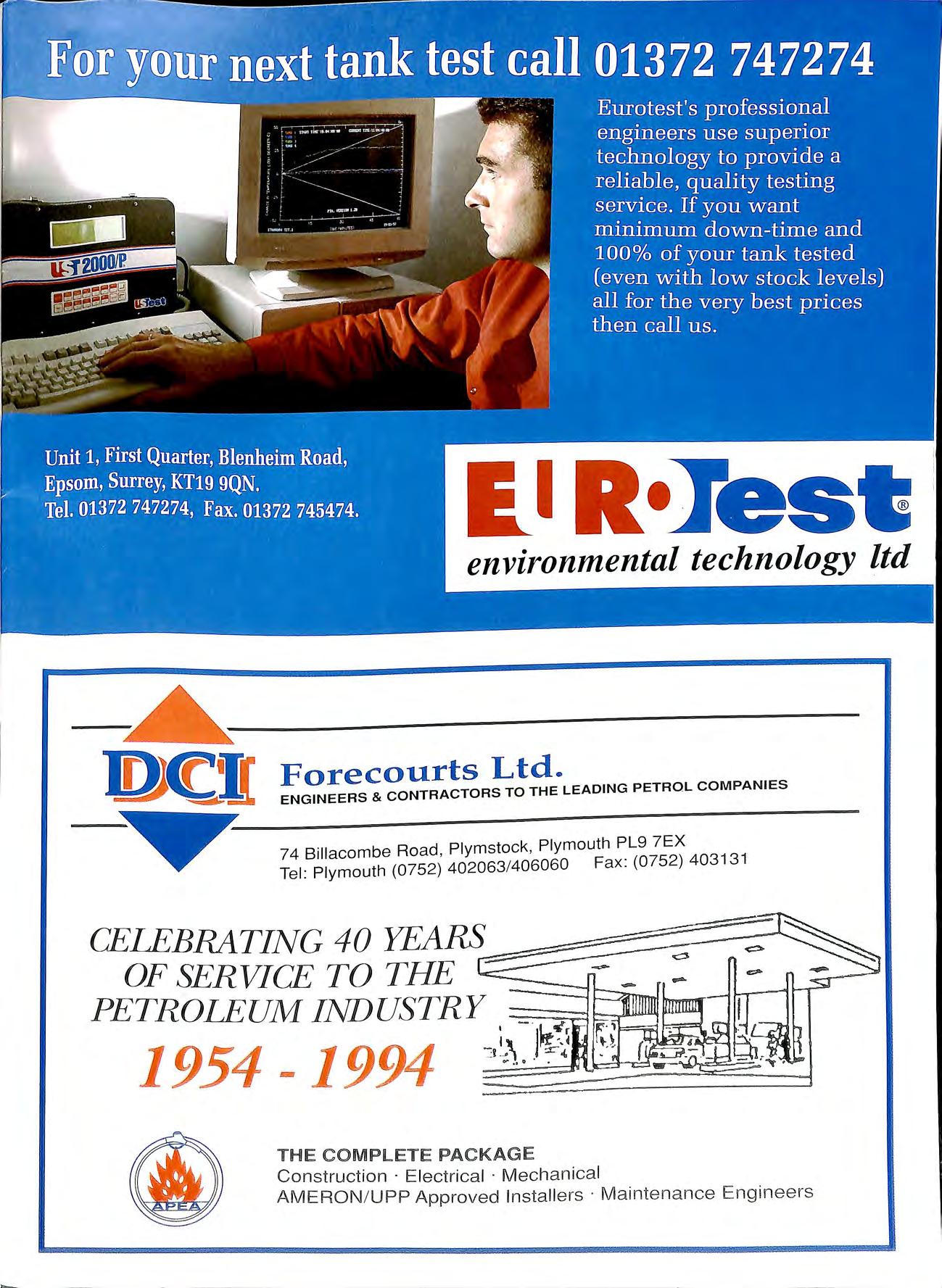
E._ 1R•l'est environmental technology ltd Forecourts Ltd. ENGINEERS & CONTRACTORS TO THE LEADING PETROL COMPANIES 74 Billacombe Road , Plymstock , Plymouth PL9 ?EX Tel : Plymouth (0752) 402063 / 406060 Fax: (0752) 403131 1954- 994 THE COMPLETE PACKAGE Construction · E lectrica l · Me c h anical AMERON / UPP Approved In s ta ll ers · Maintenance Engineers
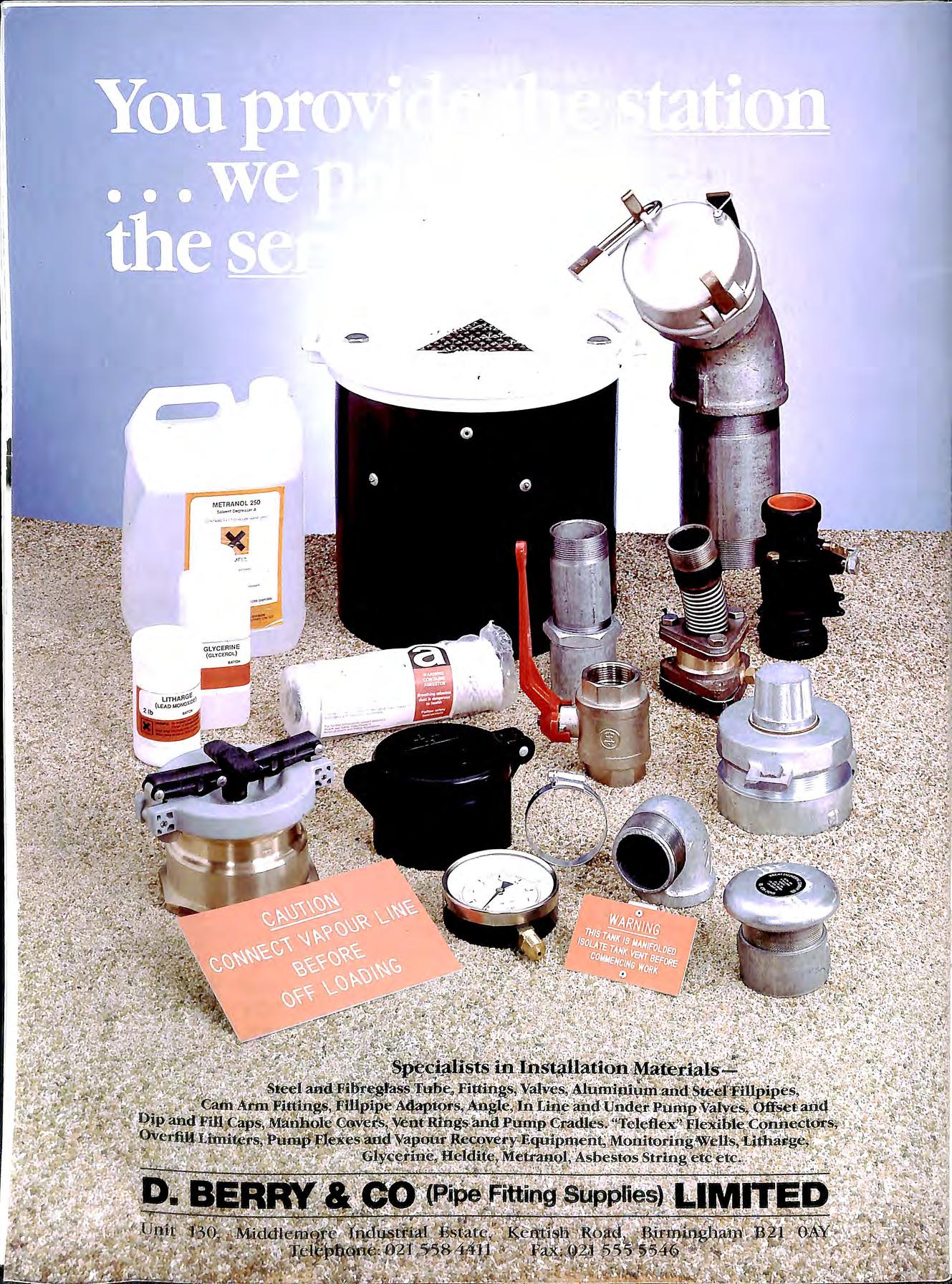
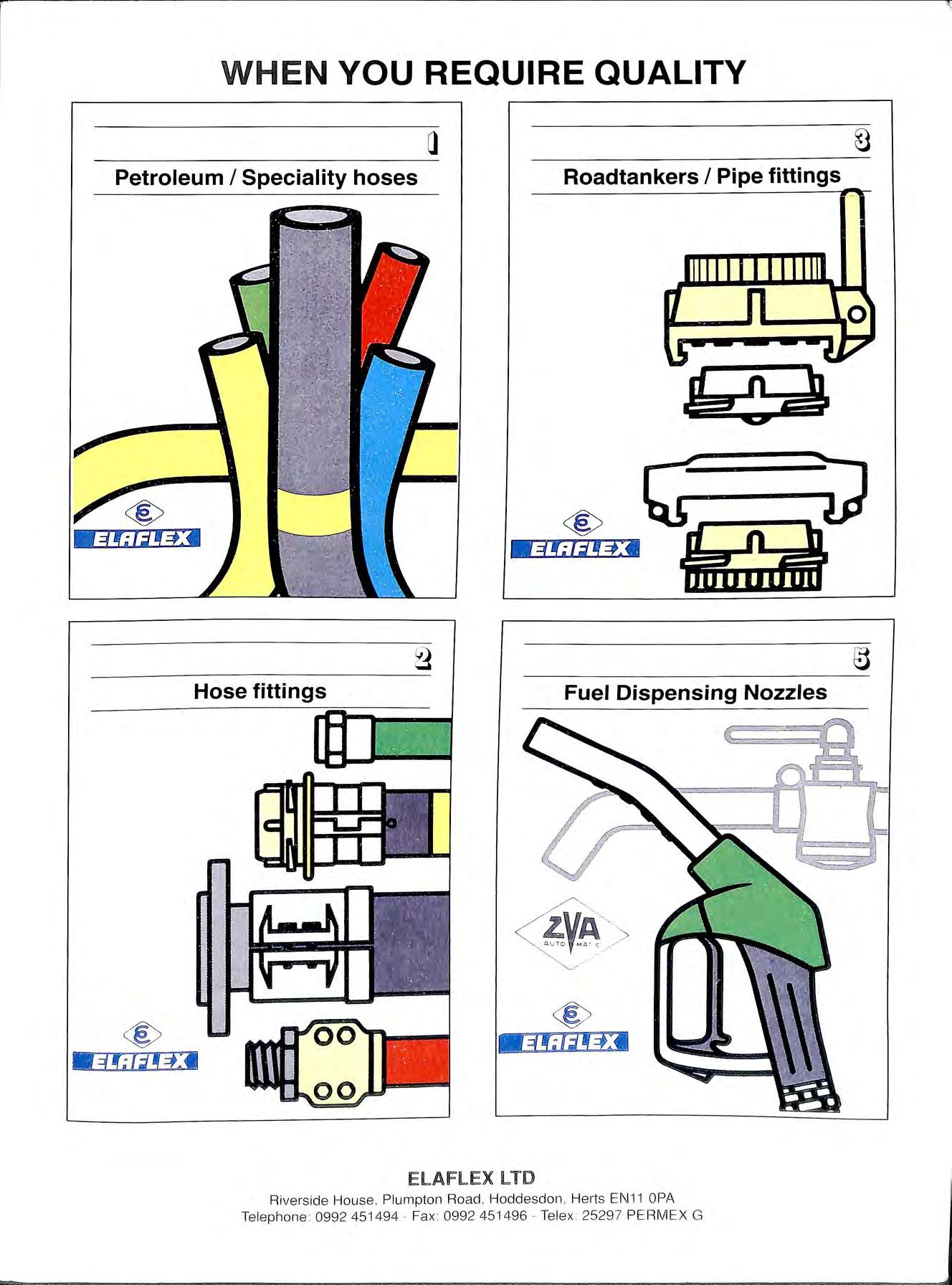
WHE N YOU REQUIRE QUALITY Petroleum I Speciality hoses Roadtankers I Pipe fittings Hose fittings Fuel Dispensing Nozzles 00 ® 00 ElAFLEX LTD Riverside House , Plumpton Road , Hoddesdon , Herts EN11 OPA Te lephone 0992 451494 Fax 0992 451496 Te lex 2529 7 PERMEX G
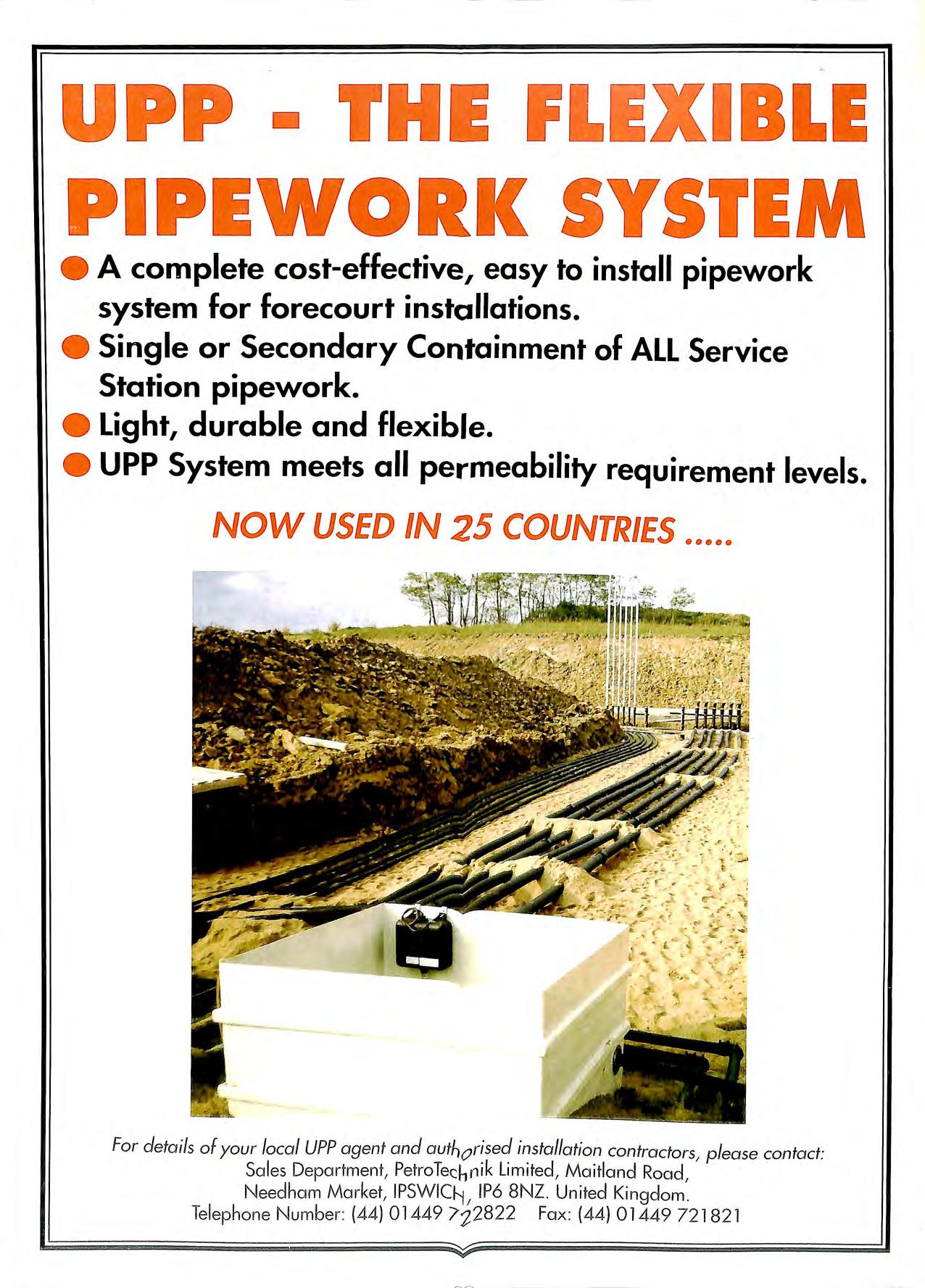
A complete cost-effective, easy to install pipework system for forecourt installations. Single or Secondary Containment of ALL Service Station pipework. Light, durable and flexible. UPP System meets all permeability requirement levels. NOW USED IN 25 COUNTRIES .a For deta ils of your local UPP agent and authorised installation contractors, please contact: Sales Department, PetroTec:hriik Limited, Maitland Road, Needham Market, IPSWICl·-j , IP6 8NZ. United Kingdom Telephone Nu mbe r : (44) 01449 /22822 Fax : (44) 01449 721821






















































